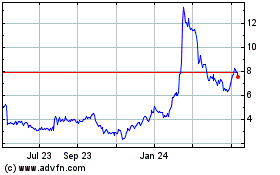0001374690false00013746902024-02-122024-02-12
UNITED STATES
SECURITIES AND EXCHANGE COMMISSION
WASHINGTON, D.C. 20549
FORM 8-K
CURRENT REPORT
Pursuant to Section 13 or 15(d) of the Securities Exchange Act of 1934
|
Date of Report (Date of earliest event reported): February 12, 2024 |
Larimar Therapeutics, Inc.
(Exact name of Registrant as Specified in Its Charter)
|
|
|
|
|
Delaware |
001-36510 |
20-3857670 |
(State or Other Jurisdiction
of Incorporation) |
(Commission File Number) |
(IRS Employer
Identification No.) |
|
|
|
|
|
Three Bala Plaza East |
|
Bala Cynwyd, Pennsylvania |
|
19004 |
(Address of Principal Executive Offices) |
|
(Zip Code) |
|
Registrant’s Telephone Number, Including Area Code: (844) 511-9056 |
(Former Name or Former Address, if Changed Since Last Report)
Check the appropriate box below if the Form 8-K filing is intended to simultaneously satisfy the filing obligation of the registrant under any of the following provisions:
☐Written communications pursuant to Rule 425 under the Securities Act (17 CFR 230.425)
☐Soliciting material pursuant to Rule 14a-12 under the Exchange Act (17 CFR 240.14a-12)
☐Pre-commencement communications pursuant to Rule 14d-2(b) under the Exchange Act (17 CFR 240.14d-2(b))
☐Pre-commencement communications pursuant to Rule 13e-4(c) under the Exchange Act (17 CFR 240.13e-4(c))
Securities registered pursuant to Section 12(b) of the Act:
|
|
|
|
|
Title of each class
|
|
Trading
Symbol(s) |
|
Name of each exchange on which registered
|
Common Stock, par value $0.001 per share |
|
lrmr |
|
Nasdaq Global Market |
Indicate by check mark whether the registrant is an emerging growth company as defined in Rule 405 of the Securities Act of 1933 (§ 230.405 of this chapter) or Rule 12b-2 of the Securities Exchange Act of 1934 (§ 240.12b-2 of this chapter).
Emerging growth company ☐
If an emerging growth company, indicate by check mark if the registrant has elected not to use the extended transition period for complying with any new or revised financial accounting standards provided pursuant to Section 13(a) of the Exchange Act. ☐
Item 2.02 Results of Operations and Financial Condition.
On February 12, 2024, Larimar Therapeutics, Inc. (the “Company”) announced that, as of December 31, 2023, the Company had approximately $86.8 million of cash, cash equivalents and marketable securities. This unaudited, preliminary amount has been prepared by and is the responsibility of management. This amount is based upon information available to management as of the date of this Current Report on Form 8-K and subject to completion of financial closing procedures that could result in changes to the amount. Furthermore, this amount does not present all information necessary for an understanding of the Company’s financial condition as of December 31, 2023. The Company’s independent registered public accounting firm, PricewaterhouseCoopers LLP, has not audited, reviewed, compiled or performed any procedures with respect to this preliminary financial data and, accordingly, PricewaterhouseCoopers LLP does not express an opinion or any other form of assurance with respect thereto. The Company’s actual results for the year ended December 31, 2023 will be included in the Company’s Annual Report on Form 10-K for the year ended December 31, 2023 and may differ materially from the above estimate.
The information furnished pursuant to this Item 2.02 is intended to be furnished and shall not be deemed “filed” for purposes of Section 18 of the Securities Exchange Act of 1934, as amended (the “Exchange Act”), or otherwise subject to the liabilities of that section, nor shall it be deemed incorporated by reference in any filing under the Securities Act of 1933, as amended, or the Exchange Act, except as expressly set forth by specific reference in such filing.
Item 8.01 Other Events.
Press Release
On February 12, 2024, the Company issued a press release announcing top-line data and successful completion of its four-week, placebo-controlled Phase 2 dose exploration study of nomlabofusp (CTI-1601) in participants with Friedreich’s ataxia. A copy of the press release is attached as Exhibit 99.1 to this Current Report on Form 8-K and is incorporated herein by reference.
Investor Presentations
On February 12, 2024, the Company posted on its website two slide presentations, which are attached as Exhibit 99.2 and 99.3 to this Current Report on Form 8-K and are incorporated herein by reference. Representatives of the Company will use these presentations in various meetings with investors, analysts and other parties from time to time.
Item 9.01 Financial Statements and Exhibits.
(d) Exhibits
Below is a list of exhibits included with this Current Report on Form 8-K.
* Filed herewith
SIGNATURES
Pursuant to the requirements of the Securities Exchange Act of 1934, the registrant has duly caused this report to be signed on its behalf by the undersigned hereunto duly authorized.
|
|
|
|
|
|
|
Larimar Therapeutics, Inc. |
|
|
|
|
Date: |
February 12, 2024 |
By: |
/s/ Carole S. Ben-Maimon, M.D. |
|
|
|
Name: Carole S. Ben-Maimon, M.D.
Title: President and Chief Executive Officer |
Larimar Therapeutics Reports Positive Top-line Data from Phase 2 Dose Exploration Study from 25 mg and 50 mg Cohorts of Nomlabofusp in Patients with Friedreich’s Ataxia
•Nomlabofusp was generally well tolerated following repeated subcutaneous injections in patients in the 25 and 50 mg cohorts with no serious adverse events
•Dose dependent increases in frataxin levels were observed in skin and buccal cells
•Open Label Extension (OLE) study initiated in January 2024 to dose 25 mg daily of nomlabofusp with dosing anticipated to be starting later this quarter; Initial data expected in Q4 2024
•Initiated discussions with the FDA on use of tissue frataxin levels as a novel surrogate endpoint to support a potential Biologics License Application (“BLA”) submission for accelerated approval targeted for 2H 2025
•Company management to host webcast and conference call today at 8:00 a.m. ET
Bala Cynwyd, PA, February 12, 2024 – Larimar Therapeutics, Inc. (“Larimar”) (Nasdaq: LRMR), a clinical-stage biotechnology company focused on developing treatments for complex rare diseases, today announced positive top-line data and successful completion of its four-week, placebo-controlled Phase 2 dose exploration study of nomlabofusp (CTI-1601) in participants with Friedreich’s ataxia (FA). Nomlabofusp was generally well tolerated and demonstrated dose dependent increases in frataxin (FXN) levels in all evaluated tissues (skin and buccal cells) after daily dosing of 14 days followed by every other day dosing until day 28 in the 25 mg and 50 mg cohorts. Participants in the 25 mg (n=13) and 50 mg (n=15) cohorts were randomized 2:1 to receive subcutaneous injections of nomlabofusp or placebo.
“We believe the dose-response and increases in FXN levels seen in peripheral tissues further reinforce the therapeutic potential of nomlabofusp to address FXN deficiency, the known root cause of disease in patients with FA,” said Carole Ben-Maimon, MD, President, and Chief Executive Officer of Larimar. “Importantly, the patients treated with 50 mg of nomlabofusp presented with individual baseline FXN skin levels less than 17% of the average level found in healthy volunteers, but after 14 days of daily treatment all patients with quantifiable levels at baseline and day 14 achieved FXN levels in skin cells greater than 33% of the average level found in healthy volunteers, and three of the patients achieved levels greater than 50% of average healthy volunteer level. Together with the consistent results seen across our Phase 2 and Phase 1 studies, we believe these findings suggest that nomlabofusp can achieve tissue FXN levels that may have a clinically meaningful effect on disease progression in patients with FA.”
Dr. Ben-Maimon continued, “Recently, we had discussions with the FDA regarding the use of tissue FXN levels as a novel surrogate endpoint. The FDA has acknowledged that frataxin deficiency appears to be critical to the pathogenic mechanism of FA, and that there continues to be an unmet need for treatments for FA patients that address the underlying disease pathophysiology. We intend to pursue an accelerated approval using FXN levels, supportive pharmacodynamics and clinical information, and safety data from the OLE study, along with additional nonclinical pharmacology information needed to support the novel surrogate endpoint approach. We are beginning to plan for a confirmatory study and are targeting a BLA submission in the second half of 2025.”
Dr. Russell Clayton, Chief Medical Officer of Larimar added, “These promising Phase 2 dose exploration data further expand our nomlabofusp safety database and strengthen clinical support for the generally well tolerated profile and low discontinuation rates seen across studies. In January, we initiated the OLE study that will start with a 25 mg daily dose, and the first subjects will begin self-administration later this quarter. The OLE study will inform on the long-term safety and self-administration of nomlabofusp following daily subcutaneous administration. Further dose expansion in the OLE will be considered based on safety, pharmacokinetics, and tissue FXN levels from the 25 mg dose of nomlabofusp. We expect to provide interim data from the OLE study in the fourth quarter of 2024.”
Key Phase 2 Results
•Median changes in FXN levels from baseline for the 25 mg and 50 mg cohorts of nomlabofusp
oSkin cells: 2.81 pg/µg for the 25 mg cohort and 5.57 pg/µg for the 50 mg cohort
oBuccal cells: 0.56 pg/µg for the 25 mg cohort and 0.72 pg/µg for the 50 mg cohort
•As seen in our multiple ascending dose (MAD) study, when dosing is switched to every other day, FXN levels decline from the levels achieved with daily dosing but remain above baseline.
•All treated patients demonstrated increases in FXN levels in skin cells and the majority of patients also demonstrated increases in FXN levels in buccal cells.
•At Day 14, all patients with quantifiable levels at baseline and Day 14 treated with 50 mg of nomlabofusp achieved FXN levels in skin cells greater than 33% of the average level found in healthy volunteers, and 3 of the patients achieved levels greater than 50% of the average healthy volunteer level.
•While FXN levels measured in buccal cells show a high degree of correlation with FXN levels measured in skin cells, higher variability in FXN levels was seen in buccal cells compared to skin cells in both the multiple ascending dose study and the Phase 2 dose exploration study. Skin cells have a lower turnover rate and skin is a more stable tissue. The collection method for skin cells is also well-established and standardized, which provides a more reliable and reproducible measure of changes in FXN levels with treatment compared to buccal cells.
Median baseline tissue FXN levels in skin cells were 3.70 pg/µg and 2.12 pg/µg for the 25 mg and 50 mg cohorts, respectively, and in buccal cells were 1.78 pg/µg and 1.61 pg/µg for the 25 mg and 50 mg cohorts, respectively. Changes in FXN levels after nomlabofusp administration in the Phase 2 trial at day 14 (QD: once daily for 14 days) and day 28 (QOD: every other day after day 14) are:
|
|
|
|
Median Change from Baseline in FXN Levels (pg FXN/ μg total protein) (25th, 75th percentile) |
|
Placebo N= 9 |
25 mg Nomlabofusp N= 9 |
50 mg Nomlabofusp N = 10 |
Skin Biopsies* |
|
Day 14 QD |
-0.53 (-0.96, 0.57) |
2.81 (2.16, 3.32) |
5.57 (4.25, 6.55) |
Day 28 QOD |
-0.34 (-0.74, 0.31) |
2.28 (-0.03, 2.71) |
3.14 (2.50, 3.64) |
|
Buccal Cells** |
Day 14 QD |
-0.35 (-0.75, 0.04) |
0.56 (-0.28, 0.64) |
0.72 (0.05, 1.06) |
Day 28 QOD |
-0.52 (-1.07, 0.01) |
0.03 (-0.66, 0.86) |
0.48 (-0.16, 0.76) |
*Subjects who had one or more FXN measurements below quantifiable levels are excluded from the above analysis.
For the placebo group, one participant had skin cell FXN levels below quantifiable levels on day 14 and day 28. For the 25 mg group, Day 14 and 28 skin biopsies were not collected from one nomlabofusp treated participant who discontinued treatment and one nomlabofusp treated participant had FXN levels below quantifiable levels at day 14 and day 28. For the 50 mg group, one participant had skin cell FXN levels below quantifiable levels at baseline.
**Subjects who had one or more FXN measurements below quantifiable levels are excluded from the above analysis. For the placebo group, one participant had buccal cell FXN levels below quantifiable levels at baseline and four participants had buccal cell FXN levels below quantifiable levels at day 14 and day 28. For 25 mg group, day 28 buccal FXN were not collected from one participant who discontinued treatment and two participants had buccal FXN levels below quantifiable levels at baseline. For the 50 mg, one participant had buccal cell FXN levels below quantifiable levels at baseline, day 14 and day 28, and two participants had buccal FXN levels below quantifiable levels at day 14 and day 28.
Key Phase 2 Pharmacokinetic and Safety Data for 25 mg and 50 mg Cohorts of Nomlabofusp
•Quick absorption after subcutaneous administration of nomlabofusp with dose proportional increases in exposure were observed with increasing doses.
•Generally well tolerated with no serious adverse events reported.
•No severe adverse events in the 50 mg cohort. One severe adverse event for an allergic reaction to the study drug was reported in the 25 mg cohort and was resolved with standard treatment.
•18 of the 19 participants dosed with nomlabofusp completed the trial, with one participant in the 25 mg cohort withdrawing due to the aforementioned allergic reaction that resolved with standard treatment.
•Most common adverse events were mild and moderate injection site reactions.
Updates on the Nomlabofusp Regulatory Pathway in FA
•FDA acknowledgment that frataxin deficiency appears to be critical to the pathogenic mechanism of FA, and that there continues to be an unmet need for treatments for FA patients that address the underlying disease pathophysiology.
•Ongoing discussions with the FDA on evidence needed to support an accelerated approval application, including supplementary nonclinical pharmacology investigations, FXN, supportive PD and clinical outcomes information from the OLE study, and additional clinical safety data.
•Initiation of a confirmatory study planned prior to BLA submission.
•Potential BLA submission targeted for 2H 2025.
Cash position
As of December 31, 2023, the Company had cash, cash equivalents and marketable securities totaling $86.8 million, which we expect to provide runway into the first quarter of 2025.
Conference Call and Webcast
Larimar will host a conference call and webcast today, February 12, 2024 at 8:00 a.m. ET. To access the webcast, please visit this link to the event. To participate by phone, please dial 1-877-407-9716 (domestic) or 1-201-493-6779 (international) and refer to conference ID 13744180, or click on this link and request a return call. Following the live event, an archived webcast will be available on the “Events & Presentations” page of the Larimar website.
About Nomlabofusp (CTI-1601)
Nomlabofusp is a recombinant fusion protein intended to deliver human frataxin to the mitochondria of patients with Friedreich’s ataxia who are unable to produce enough of this essential protein. Nomlabofusp has been granted Rare Pediatric Disease designation, Fast Track designation and Orphan Drug designation by the U.S. Food and Drug Administration (FDA), Orphan Drug Designation by the European Commission, and a PRIME designation by the European Medicines Agency.
About Larimar Therapeutics
Larimar Therapeutics, Inc. (Nasdaq: LRMR), is a clinical-stage biotechnology company focused on developing treatments for complex rare diseases. Larimar’s lead compound, nomlabofusp (CTI-1601), is being developed as a potential treatment for Friedreich's ataxia. Larimar also plans to use its intracellular delivery platform to design other fusion proteins to target additional rare diseases characterized by deficiencies in intracellular bioactive compounds. For more information, please visit: https://larimartx.com.
Forward-Looking Statements
This press release contains forward-looking statements that are based on Larimar’s management’s beliefs and assumptions and on information currently available to management. All statements contained in this release other than statements of historical fact are forward-looking statements, including but not limited to statements regarding Larimar’s ability to develop and commercialize nomlabofusp (also known as CTI-1601) and other planned product candidates, Larimar’s planned research and development
efforts, including the timing of its nomlabofusp clinical trials, interactions with the FDA and overall development plan and other matters regarding Larimar’s business strategies, ability to raise capital, use of capital, results of operations and financial position, and plans and objectives for future operations.
In some cases, you can identify forward-looking statements by the words “may,” “will,” “could,” “would,” “should,” “expect,” “intend,” “plan,” “anticipate,” “believe,” “estimate,” “predict,” “project,” “potential,” “continue,” “ongoing” or the negative of these terms or other comparable terminology, although not all forward-looking statements contain these words. These statements involve risks, uncertainties and other factors that may cause actual results, performance, or achievements to be materially different from the information expressed or implied by these forward-looking statements. These risks, uncertainties and other factors include, among others, the success, cost and timing of Larimar’s product development activities, nonclinical studies and clinical trials, including nomlabofusp clinical milestones and continued interactions with the FDA; that preliminary clinical trial results may differ from final clinical trial results, that earlier non-clinical and clinical data and testing of nomlabofusp may not be predictive of the results or success of later clinical trials, and assessments; that the FDA may not ultimately agree with Larimar’s nomlabofusp development strategy; the potential impact of public health crises on Larimar’s future clinical trials, manufacturing, regulatory, nonclinical study timelines and operations, and general economic conditions; Larimar’s ability and the ability of third-party manufacturers Larimar engages, to optimize and scale nomlabofusp’s manufacturing process; Larimar’s ability to obtain regulatory approvals for nomlabofusp and future product candidates; Larimar’s ability to develop sales and marketing capabilities, whether alone or with potential future collaborators, and to successfully commercialize any approved product candidates; Larimar’s ability to raise the necessary capital to conduct its product development activities; and other risks described in the filings made by Larimar with the Securities and Exchange Commission (SEC), including but not limited to Larimar’s periodic reports, including the annual report on Form 10-K, quarterly reports on Form 10-Q and current reports on Form 8-K, filed with or furnished to the SEC and available at www.sec.gov. These forward-looking statements are based on a combination of facts and factors currently known by Larimar and its projections of the future, about which it cannot be certain. As a result, the forward-looking statements may not prove to be accurate. The forward-looking statements in this press release represent Larimar’s management’s views only as of the date hereof. Larimar undertakes no obligation to update any forward-looking statements for any reason, except as required by law.
Investor Contact:
Joyce Allaire
LifeSci Advisors
jallaire@lifesciadvisors.com
(212) 915-2569
Company Contact:
Michael Celano
Chief Financial Officer
mcelano@larimartx.com
(484) 414-2715
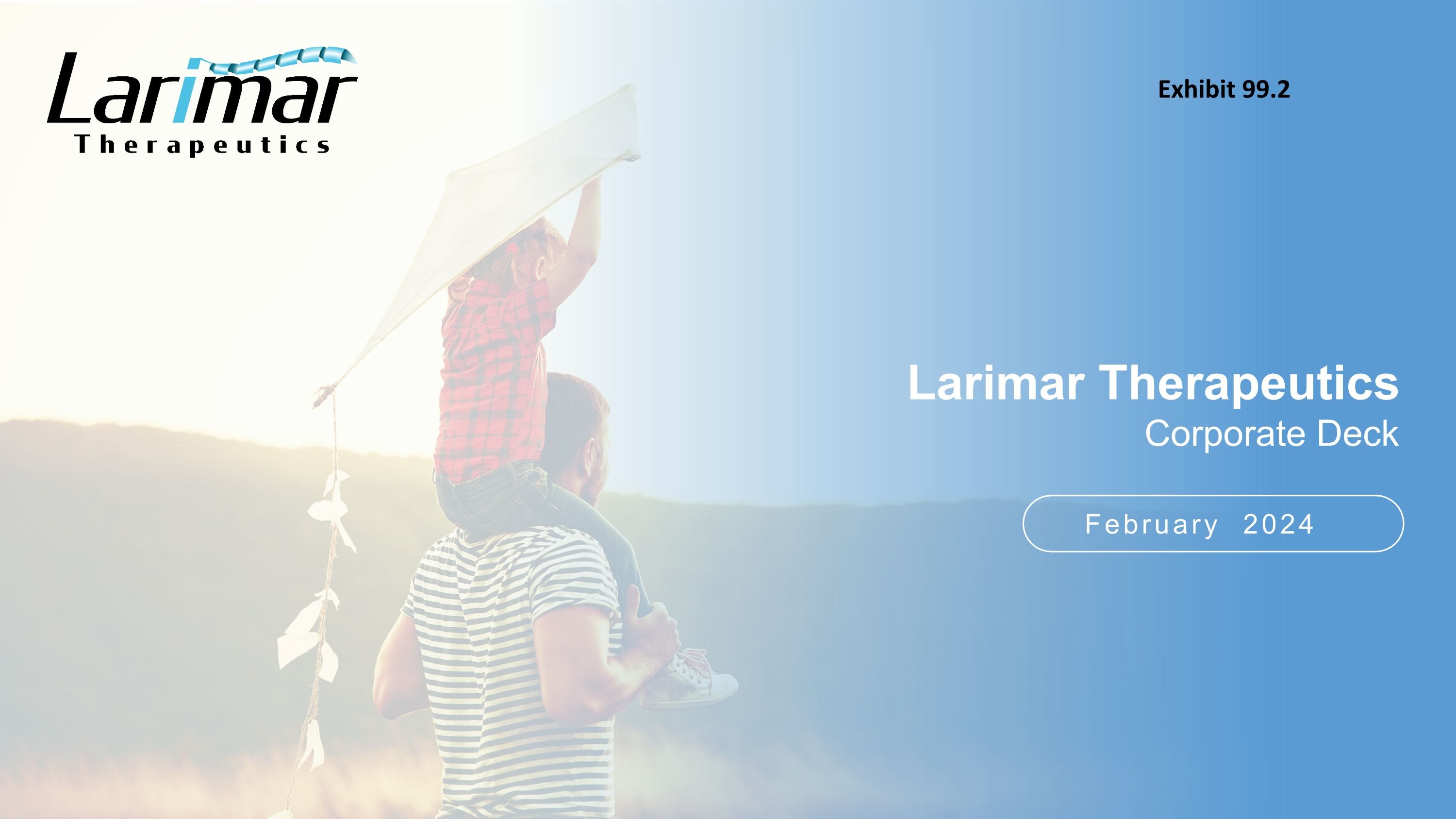
February 2024 Larimar Therapeutics Corporate Deck Exhibit 99.2
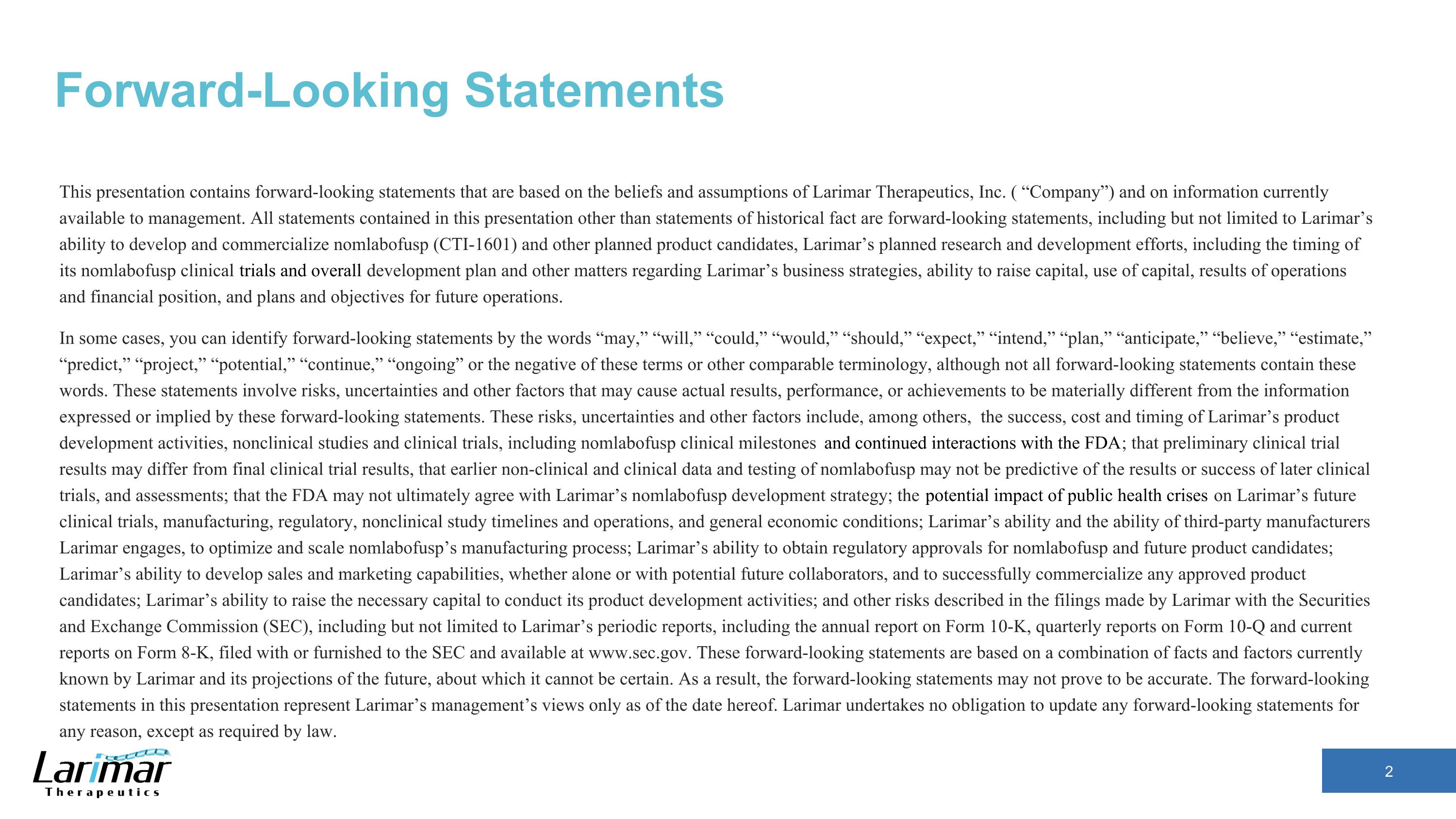
This presentation contains forward-looking statements that are based on the beliefs and assumptions of Larimar Therapeutics, Inc. ( “Company”) and on information currently available to management. All statements contained in this presentation other than statements of historical fact are forward-looking statements, including but not limited to Larimar’s ability to develop and commercialize nomlabofusp (CTI-1601) and other planned product candidates, Larimar’s planned research and development efforts, including the timing of its nomlabofusp clinical trials and overall development plan and other matters regarding Larimar’s business strategies, ability to raise capital, use of capital, results of operations and financial position, and plans and objectives for future operations. In some cases, you can identify forward-looking statements by the words “may,” “will,” “could,” “would,” “should,” “expect,” “intend,” “plan,” “anticipate,” “believe,” “estimate,” “predict,” “project,” “potential,” “continue,” “ongoing” or the negative of these terms or other comparable terminology, although not all forward-looking statements contain these words. These statements involve risks, uncertainties and other factors that may cause actual results, performance, or achievements to be materially different from the information expressed or implied by these forward-looking statements. These risks, uncertainties and other factors include, among others, the success, cost and timing of Larimar’s product development activities, nonclinical studies and clinical trials, including nomlabofusp clinical milestones and continued interactions with the FDA; that preliminary clinical trial results may differ from final clinical trial results, that earlier non-clinical and clinical data and testing of nomlabofusp may not be predictive of the results or success of later clinical trials, and assessments; that the FDA may not ultimately agree with Larimar’s nomlabofusp development strategy; the potential impact of public health crises on Larimar’s future clinical trials, manufacturing, regulatory, nonclinical study timelines and operations, and general economic conditions; Larimar’s ability and the ability of third-party manufacturers Larimar engages, to optimize and scale nomlabofusp’s manufacturing process; Larimar’s ability to obtain regulatory approvals for nomlabofusp and future product candidates; Larimar’s ability to develop sales and marketing capabilities, whether alone or with potential future collaborators, and to successfully commercialize any approved product candidates; Larimar’s ability to raise the necessary capital to conduct its product development activities; and other risks described in the filings made by Larimar with the Securities and Exchange Commission (SEC), including but not limited to Larimar’s periodic reports, including the annual report on Form 10-K, quarterly reports on Form 10-Q and current reports on Form 8-K, filed with or furnished to the SEC and available at www.sec.gov. These forward-looking statements are based on a combination of facts and factors currently known by Larimar and its projections of the future, about which it cannot be certain. As a result, the forward-looking statements may not prove to be accurate. The forward-looking statements in this presentation represent Larimar’s management’s views only as of the date hereof. Larimar undertakes no obligation to update any forward-looking statements for any reason, except as required by law. Forward-Looking Statements
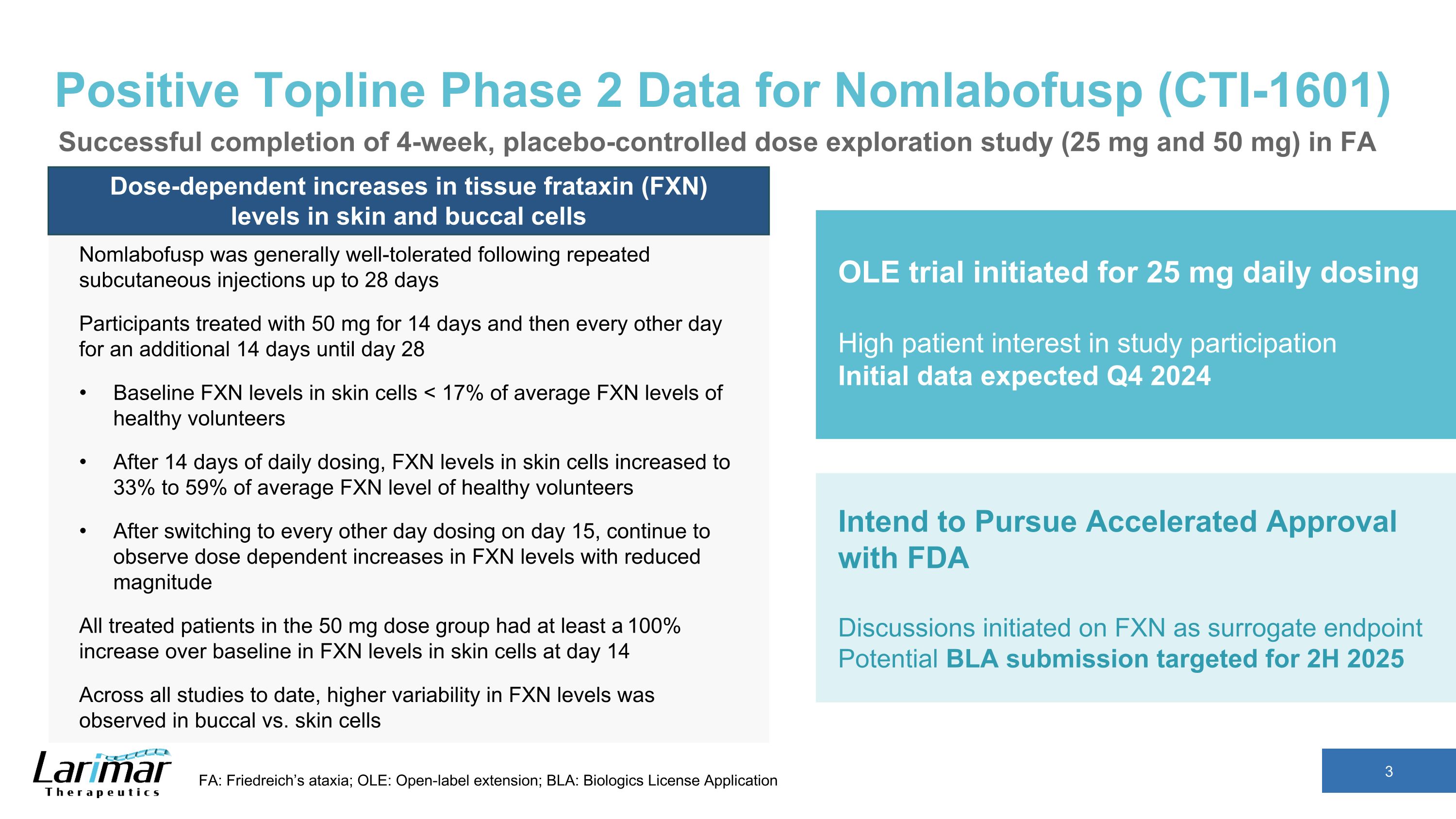
Positive Topline Phase 2 Data for Nomlabofusp (CTI-1601) Dose-dependent increases in tissue frataxin (FXN) levels in skin and buccal cells Nomlabofusp was generally well-tolerated following repeated subcutaneous injections up to 28 days Participants treated with 50 mg for 14 days and then every other day for an additional 14 days until day 28 Baseline FXN levels in skin cells < 17% of average FXN levels of healthy volunteers After 14 days of daily dosing, FXN levels in skin cells increased to 33% to 59% of average FXN level of healthy volunteers After switching to every other day dosing on day 15, continue to observe dose dependent increases in FXN levels with reduced magnitude All treated patients in the 50 mg dose group had at least a 100% increase over baseline in FXN levels in skin cells at day 14 Across all studies to date, higher variability in FXN levels was observed in buccal vs. skin cells FA: Friedreich’s ataxia; OLE: Open-label extension; BLA: Biologics License Application OLE trial initiated for 25 mg daily dosing High patient interest in study participation Initial data expected Q4 2024 Intend to Pursue Accelerated Approval with FDA Discussions initiated on FXN as surrogate endpoint Potential BLA submission targeted for 2H 2025 Successful completion of 4-week, placebo-controlled dose exploration study (25 mg and 50 mg) in FA
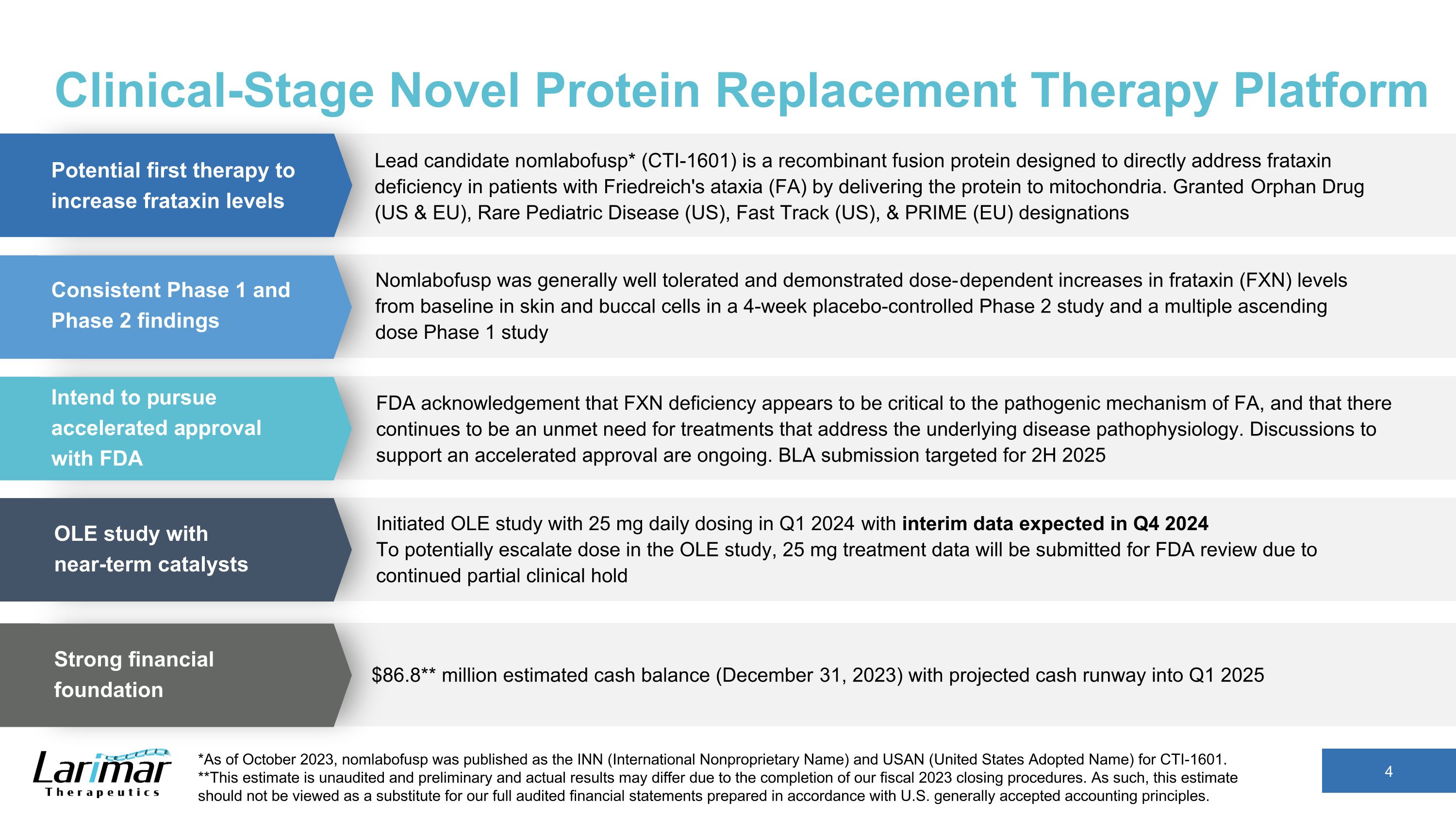
Clinical-Stage Novel Protein Replacement Therapy Platform Lead candidate nomlabofusp* (CTI-1601) is a recombinant fusion protein designed to directly address frataxin deficiency in patients with Friedreich's ataxia (FA) by delivering the protein to mitochondria. Granted Orphan Drug (US & EU), Rare Pediatric Disease (US), Fast Track (US), & PRIME (EU) designations Nomlabofusp was generally well tolerated and demonstrated dose-dependent increases in frataxin (FXN) levels from baseline in skin and buccal cells in a 4-week placebo-controlled Phase 2 study and a multiple ascending dose Phase 1 study Initiated OLE study with 25 mg daily dosing in Q1 2024 with interim data expected in Q4 2024 To potentially escalate dose in the OLE study, 25 mg treatment data will be submitted for FDA review due to continued partial clinical hold $86.8** million estimated cash balance (December 31, 2023) with projected cash runway into Q1 2025 Potential first therapy to increase frataxin levels Consistent Phase 1 and Phase 2 findings Intend to pursue accelerated approval with FDA OLE study with near-term catalysts Strong financial foundation *As of October 2023, nomlabofusp was published as the INN (International Nonproprietary Name) and USAN (United States Adopted Name) for CTI-1601. **This estimate is unaudited and preliminary and actual results may differ due to the completion of our fiscal 2023 closing procedures. As such, this estimate should not be viewed as a substitute for our full audited financial statements prepared in accordance with U.S. generally accepted accounting principles. FDA acknowledgement that FXN deficiency appears to be critical to the pathogenic mechanism of FA, and that there continues to be an unmet need for treatments that address the underlying disease pathophysiology. Discussions to support an accelerated approval are ongoing. BLA submission targeted for 2H 2025
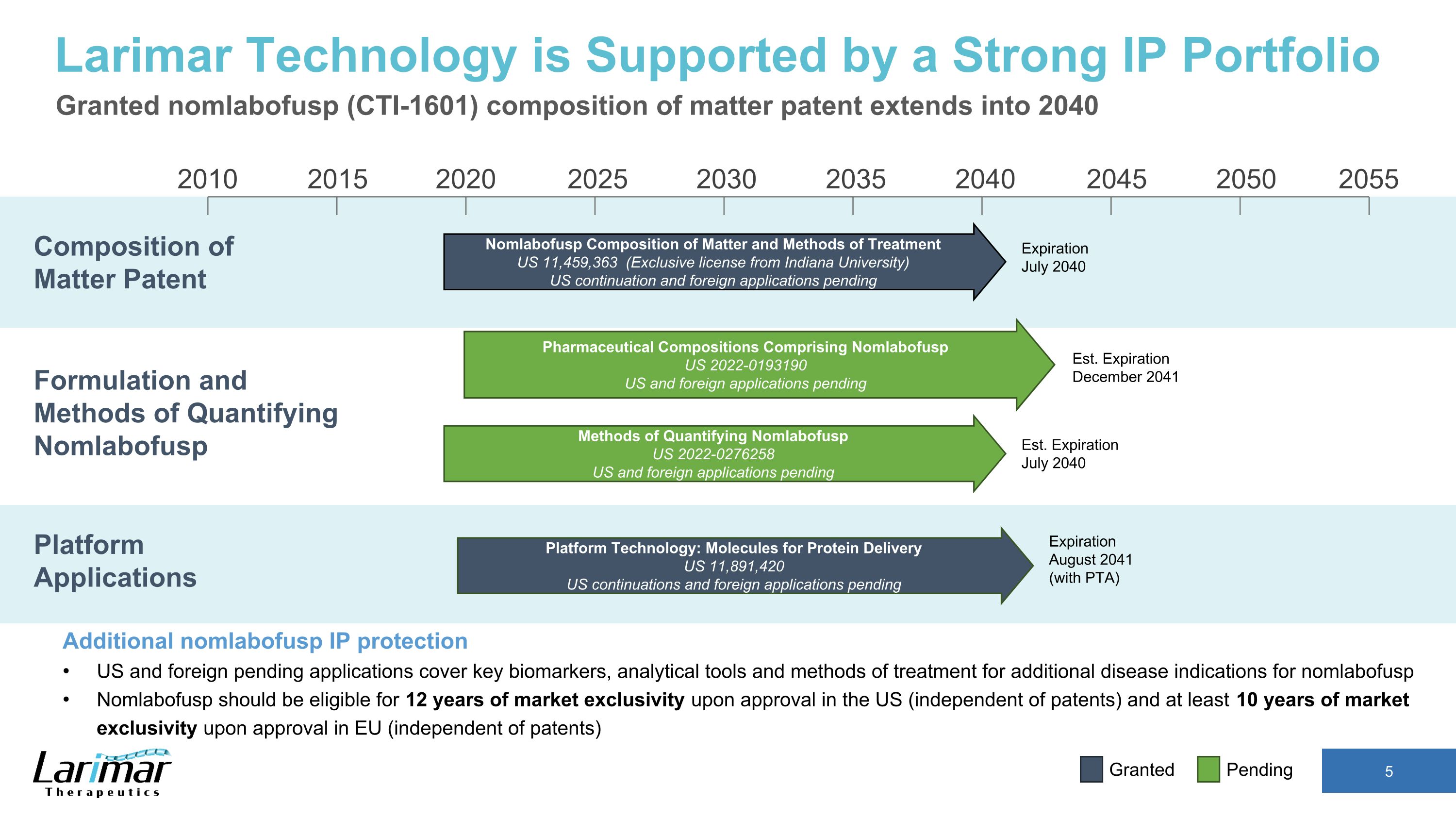
2015 2020 2030 2035 2040 2045 2050 2055 2010 2025 Nomlabofusp Composition of Matter and Methods of Treatment US 11,459,363 (Exclusive license from Indiana University) US continuation and foreign applications pending Expiration July 2040 Composition of Matter Patent Larimar Technology is Supported by a Strong IP Portfolio Granted nomlabofusp (CTI-1601) composition of matter patent extends into 2040 Additional nomlabofusp IP protection US and foreign pending applications cover key biomarkers, analytical tools and methods of treatment for additional disease indications for nomlabofusp Nomlabofusp should be eligible for 12 years of market exclusivity upon approval in the US (independent of patents) and at least 10 years of market exclusivity upon approval in EU (independent of patents) Platform Applications Formulation and Methods of Quantifying Nomlabofusp Platform Technology: Molecules for Protein Delivery US 11,891,420 US continuations and foreign applications pending Pharmaceutical Compositions Comprising Nomlabofusp US 2022-0193190 US and foreign applications pending Methods of Quantifying Nomlabofusp US 2022-0276258 US and foreign applications pending Est. Expiration December 2041 Est. Expiration July 2040 Expiration August 2041 (with PTA) Pending Granted
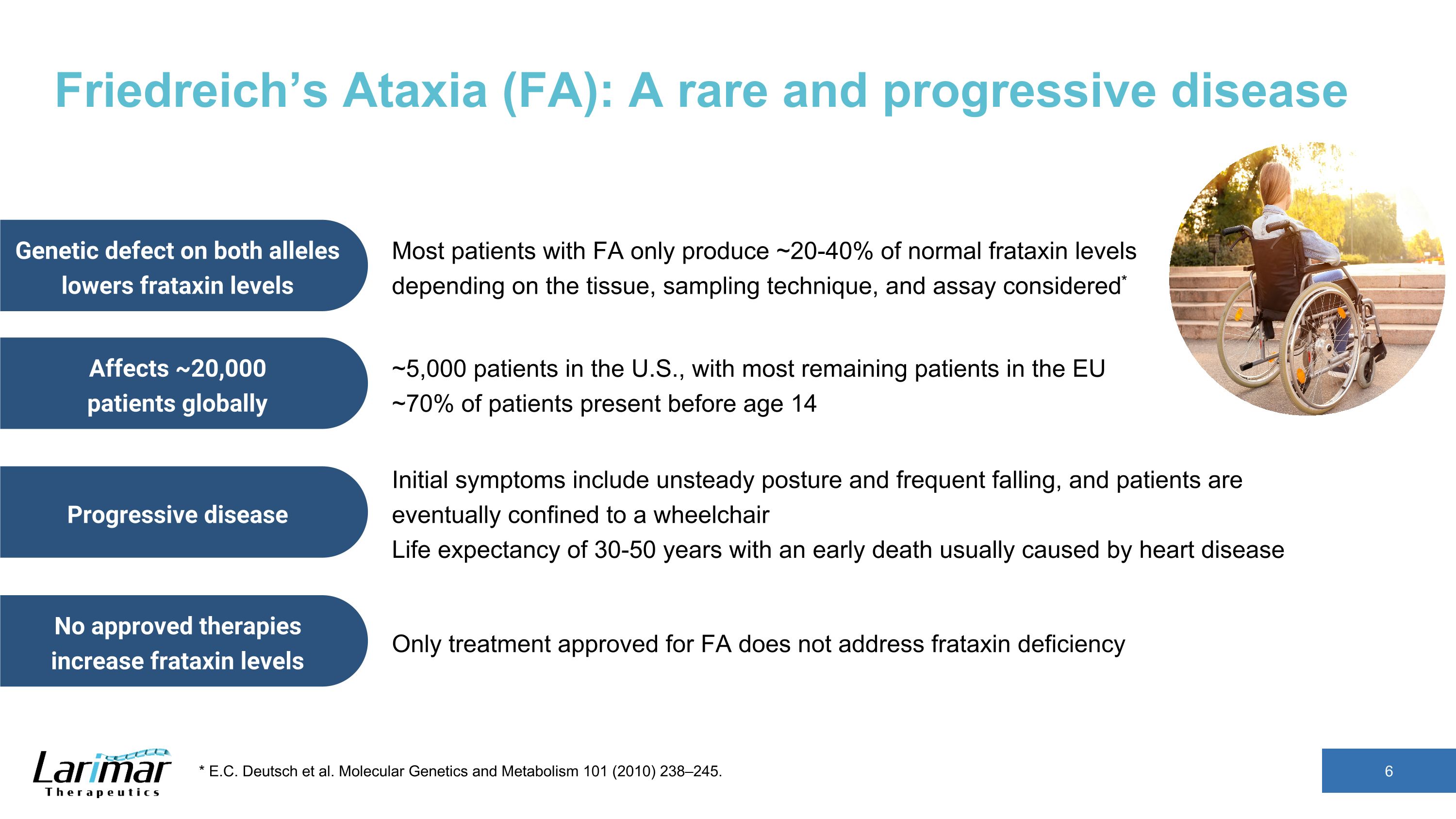
Friedreich’s Ataxia (FA): A rare and progressive disease 6 * E.C. Deutsch et al. Molecular Genetics and Metabolism 101 (2010) 238–245. Most patients with FA only produce ~20-40% of normal frataxin levels depending on the tissue, sampling technique, and assay considered* Genetic defect on both alleles lowers frataxin levels Progressive disease Initial symptoms include unsteady posture and frequent falling, and patients are eventually confined to a wheelchair�Life expectancy of 30-50 years with an early death usually caused by heart disease Affects ~20,000 patients globally ~5,000 patients in the U.S., with most remaining patients in the EU�~70% of patients present before age 14 No approved therapies increase frataxin levels Only treatment approved for FA does not address frataxin deficiency

Nomlabofusp is Designed to Deliver Additional Frataxin The presence of the cleavage site allows the CPP and MTS to be removed by mitochondrial processing peptidase to produce mature human FXN in the mitochondria STRUCTURE OF ENDOGENOUS FXN STRUCTURE OF NOMLABOFUSP Cleavage by mitochondrial processing peptidase (MPP) at this site produces mature human FXN in mitochondria Mitochondrial Targeting Sequence (MTS) Mature Human FXN Cleavage by mitochondrial processing peptidase (MPP) at this site produces mature human FXN in mitochondria Mature Human FXN Cell Penetrating Peptide (CPP) Mitochondrial Targeting Sequence (MTS) Nomlabofusp (CTI-1601) maintains the cleavage site between the MTS and mature human frataxin (FXN)
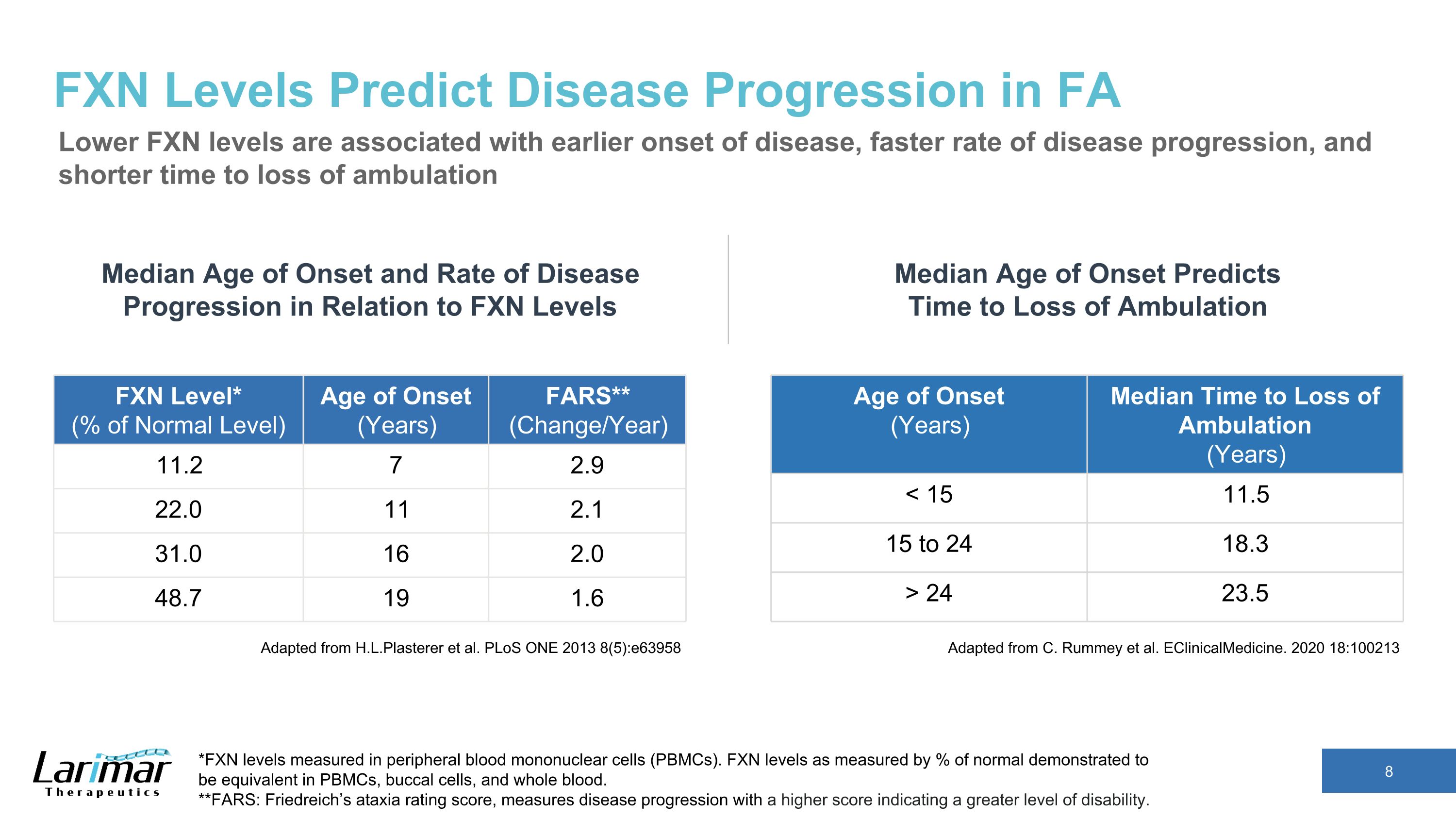
FXN Levels Predict Disease Progression in FA Lower FXN levels are associated with earlier onset of disease, faster rate of disease progression, and shorter time to loss of ambulation Adapted from H.L.Plasterer et al. PLoS ONE 2013 8(5):e63958 Age of Onset (Years) Median Time to Loss of Ambulation (Years) < 15 11.5 15 to 24 18.3 > 24 23.5 Median Age of Onset and Rate of Disease Progression in Relation to FXN Levels *FXN levels measured in peripheral blood mononuclear cells (PBMCs). FXN levels as measured by % of normal demonstrated to be equivalent in PBMCs, buccal cells, and whole blood. **FARS: Friedreich’s ataxia rating score, measures disease progression with a higher score indicating a greater level of disability. FXN Level* (% of Normal Level) Age of Onset (Years) FARS** (Change/Year) 11.2 7 2.9 22.0 11 2.1 31.0 16 2.0 48.7 19 1.6 Adapted from C. Rummey et al. EClinicalMedicine. 2020 18:100213 Median Age of Onset Predicts Time to Loss of Ambulation
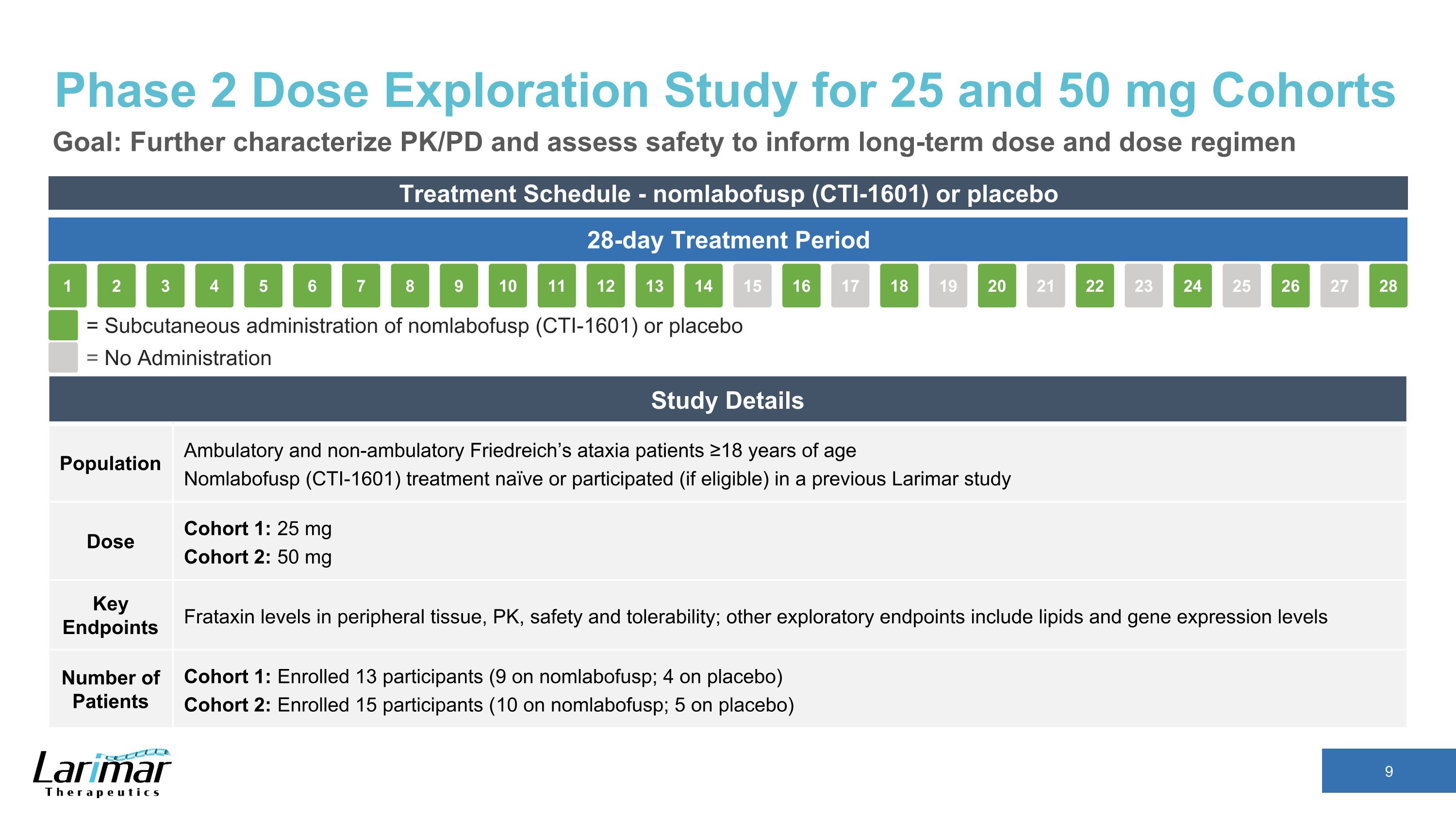
Phase 2 Dose Exploration Study for 25 and 50 mg Cohorts Goal: Further characterize PK/PD and assess safety to inform long-term dose and dose regimen Treatment Schedule - nomlabofusp (CTI-1601) or placebo 28-day Treatment Period 16 17 18 19 15 20 21 22 23 24 25 26 27 28 2 3 4 5 1 6 7 8 9 10 11 12 13 14 = Subcutaneous administration of nomlabofusp (CTI-1601) or placebo = No Administration Study Details Population Ambulatory and non-ambulatory Friedreich’s ataxia patients ≥18 years of age Nomlabofusp (CTI-1601) treatment naïve or participated (if eligible) in a previous Larimar study Dose Cohort 1: 25 mg Cohort 2: 50 mg Key Endpoints Frataxin levels in peripheral tissue, PK, safety and tolerability; other exploratory endpoints include lipids and gene expression levels Number of Patients Cohort 1: Enrolled 13 participants (9 on nomlabofusp; 4 on placebo) Cohort 2: Enrolled 15 participants (10 on nomlabofusp; 5 on placebo)
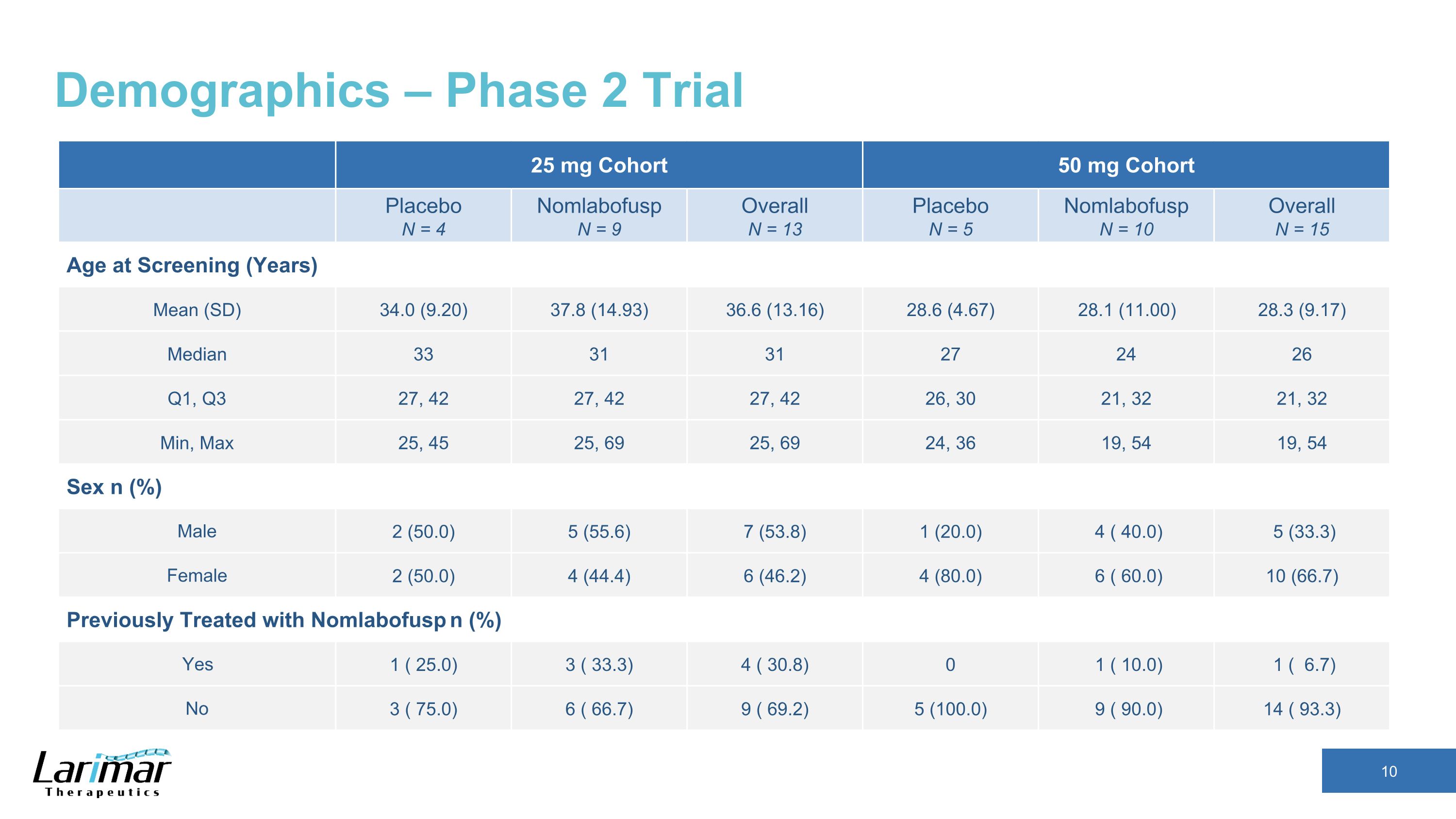
Demographics – Phase 2 Trial 25 mg Cohort 50 mg Cohort Placebo N = 4 Nomlabofusp N = 9 Overall N = 13 Placebo N = 5 Nomlabofusp N = 10 Overall N = 15 Age at Screening (Years) Mean (SD) 34.0 (9.20) 37.8 (14.93) 36.6 (13.16) 28.6 (4.67) 28.1 (11.00) 28.3 (9.17) Median 33 31 31 27 24 26 Q1, Q3 27, 42 27, 42 27, 42 26, 30 21, 32 21, 32 Min, Max 25, 45 25, 69 25, 69 24, 36 19, 54 19, 54 Sex n (%) Male 2 (50.0) 5 (55.6) 7 (53.8) 1 (20.0) 4 ( 40.0) 5 (33.3) Female 2 (50.0) 4 (44.4) 6 (46.2) 4 (80.0) 6 ( 60.0) 10 (66.7) Previously Treated with Nomlabofusp n (%) Yes 1 ( 25.0) 3 ( 33.3) 4 ( 30.8) 0 1 ( 10.0) 1 ( 6.7) No 3 ( 75.0) 6 ( 66.7) 9 ( 69.2) 5 (100.0) 9 ( 90.0) 14 ( 93.3)
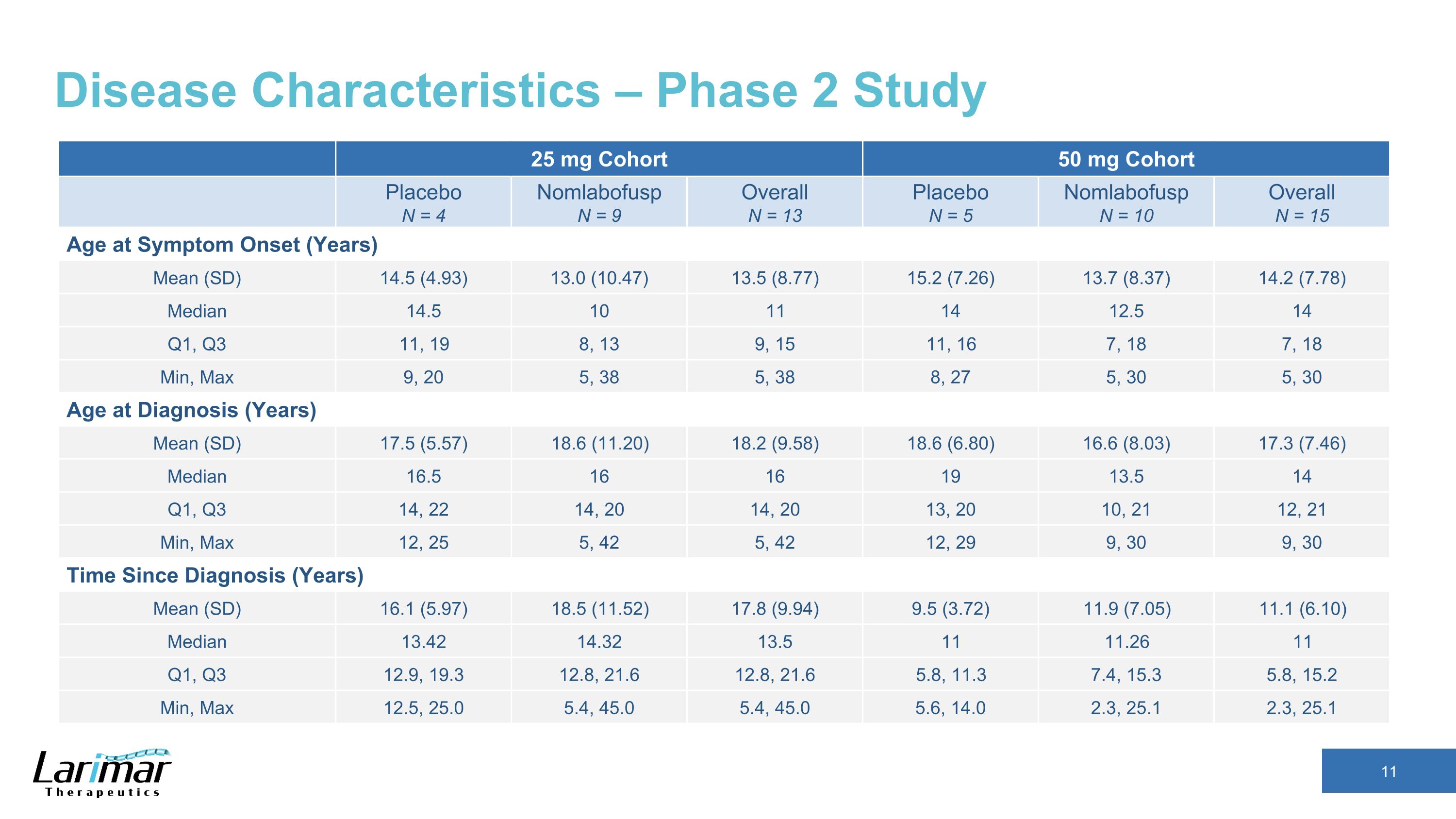
Disease Characteristics – Phase 2 Study 25 mg Cohort 50 mg Cohort Placebo N = 4 Nomlabofusp N = 9 Overall N = 13 Placebo N = 5 Nomlabofusp N = 10 Overall N = 15 Age at Symptom Onset (Years) Mean (SD) 14.5 (4.93) 13.0 (10.47) 13.5 (8.77) 15.2 (7.26) 13.7 (8.37) 14.2 (7.78) Median 14.5 10 11 14 12.5 14 Q1, Q3 11, 19 8, 13 9, 15 11, 16 7, 18 7, 18 Min, Max 9, 20 5, 38 5, 38 8, 27 5, 30 5, 30 Age at Diagnosis (Years) Mean (SD) 17.5 (5.57) 18.6 (11.20) 18.2 (9.58) 18.6 (6.80) 16.6 (8.03) 17.3 (7.46) Median 16.5 16 16 19 13.5 14 Q1, Q3 14, 22 14, 20 14, 20 13, 20 10, 21 12, 21 Min, Max 12, 25 5, 42 5, 42 12, 29 9, 30 9, 30 Time Since Diagnosis (Years) Mean (SD) 16.1 (5.97) 18.5 (11.52) 17.8 (9.94) 9.5 (3.72) 11.9 (7.05) 11.1 (6.10) Median 13.42 14.32 13.5 11 11.26 11 Q1, Q3 12.9, 19.3 12.8, 21.6 12.8, 21.6 5.8, 11.3 7.4, 15.3 5.8, 15.2 Min, Max 12.5, 25.0 5.4, 45.0 5.4, 45.0 5.6, 14.0 2.3, 25.1 2.3, 25.1
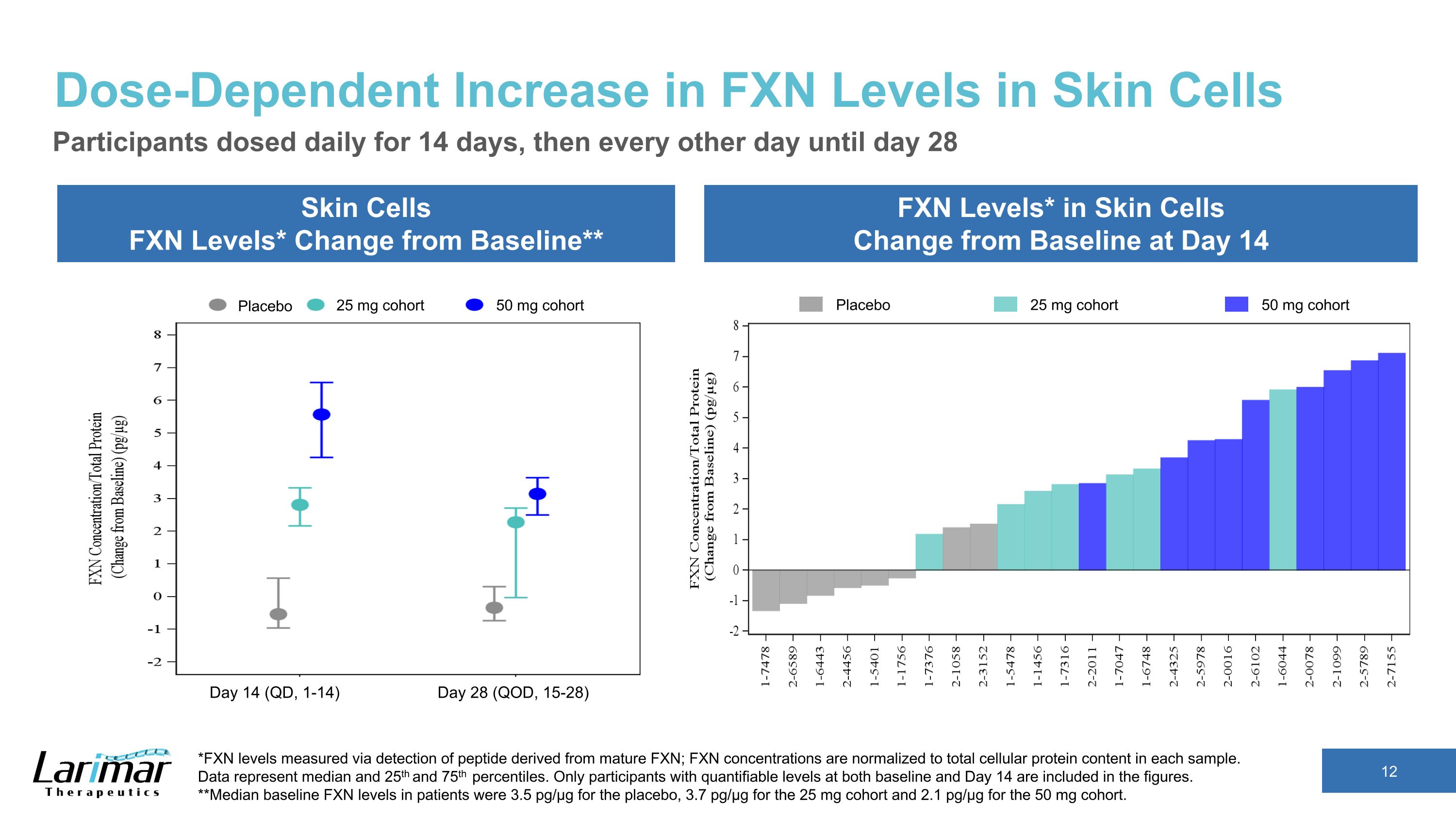
Dose-Dependent Increase in FXN Levels in Skin Cells Skin Cells FXN Levels* Change from Baseline** FXN Levels* in Skin Cells Change from Baseline at Day 14 Participants dosed daily for 14 days, then every other day until day 28 *FXN levels measured via detection of peptide derived from mature FXN; FXN concentrations are normalized to total cellular protein content in each sample.�Data represent median and 25th and 75th percentiles. Only participants with quantifiable levels at both baseline and Day 14 are included in the figures. **Median baseline FXN levels in patients were 3.5 pg/µg for the placebo, 3.7 pg/µg for the 25 mg cohort and 2.1 pg/µg for the 50 mg cohort. Placebo 25 mg cohort 50 mg cohort Placebo 25 mg cohort 50 mg cohort Day 14 (QD, 1-14) Day 28 (QOD, 15-28)
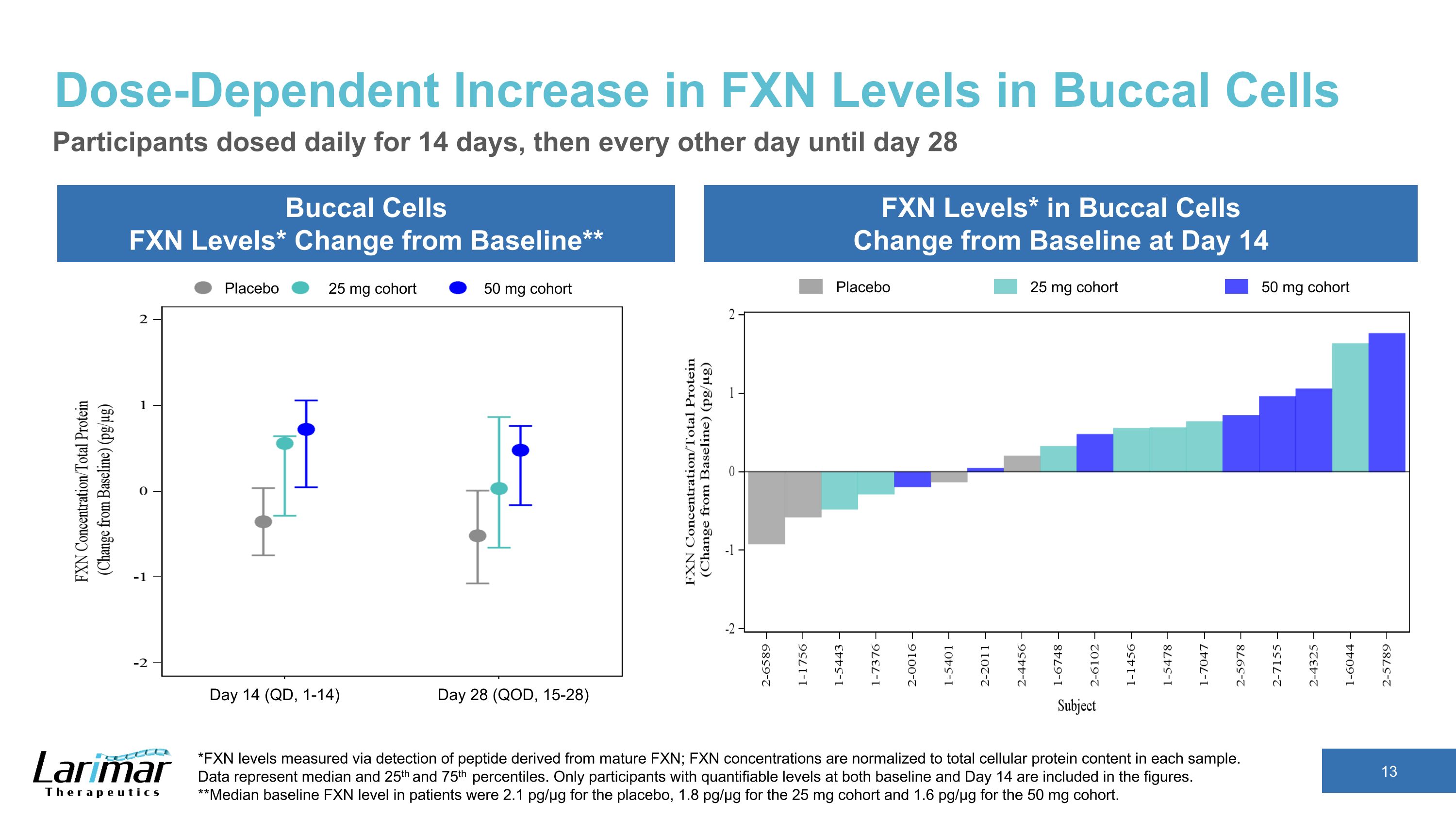
Dose-Dependent Increase in FXN Levels in Buccal Cells Buccal Cells FXN Levels* Change from Baseline** FXN Levels* in Buccal Cells Change from Baseline at Day 14 Participants dosed daily for 14 days, then every other day until day 28 *FXN levels measured via detection of peptide derived from mature FXN; FXN concentrations are normalized to total cellular protein content in each sample. �Data represent median and 25th and 75th percentiles. Only participants with quantifiable levels at both baseline and Day 14 are included in the figures. **Median baseline FXN level in patients were 2.1 pg/µg for the placebo, 1.8 pg/µg for the 25 mg cohort and 1.6 pg/µg for the 50 mg cohort. Placebo 25 mg cohort 50 mg cohort Placebo 25 mg cohort 50 mg cohort Day 14 (QD, 1-14) Day 28 (QOD, 15-28)
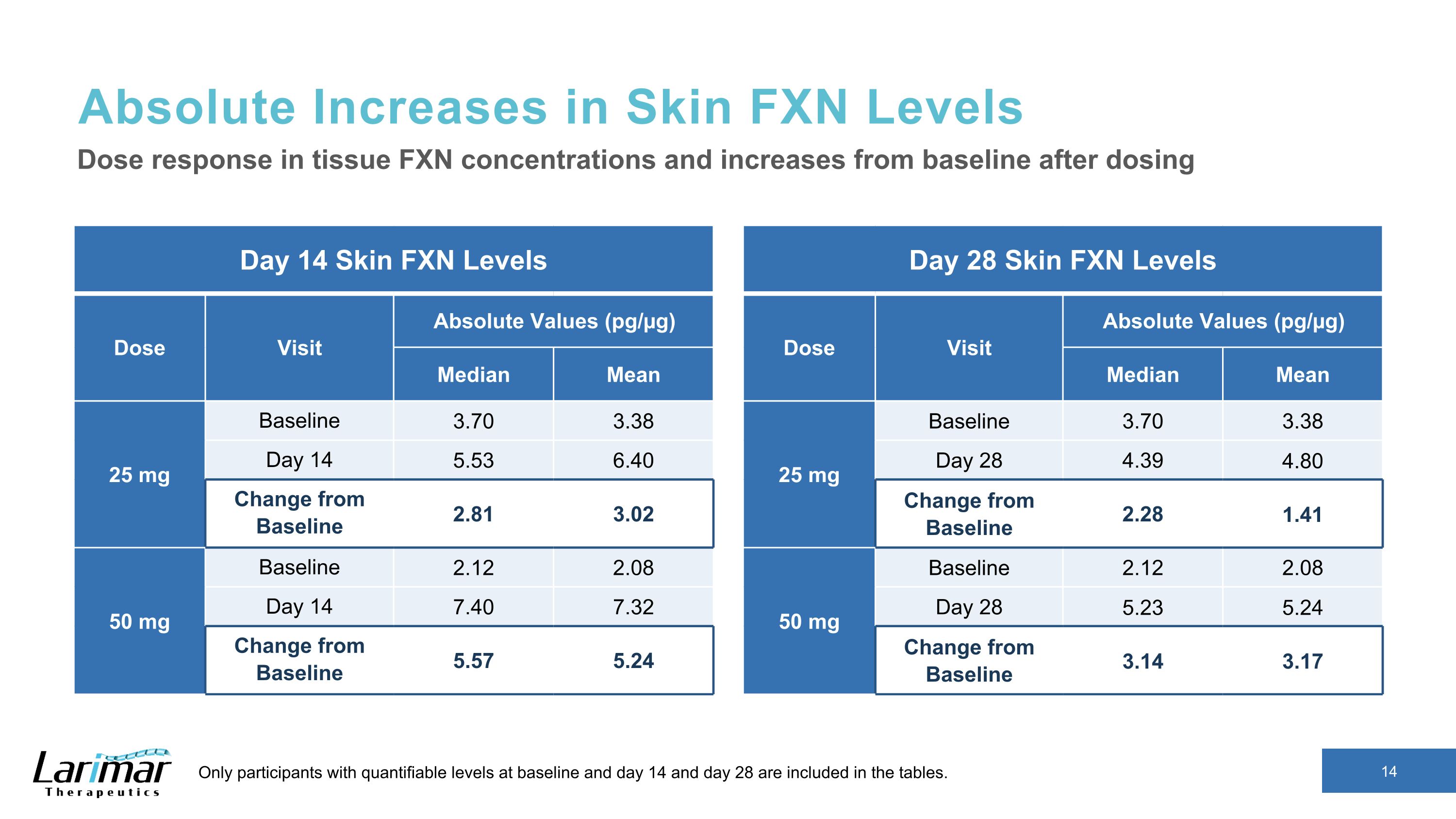
Absolute Increases in Skin FXN Levels Day 14 Skin FXN Levels Dose Visit Absolute Values (pg/µg) Median Mean 25 mg Baseline 3.70 3.38 Day 14 5.53 6.40 Change from Baseline 2.81 3.02 50 mg Baseline 2.12 2.08 Day 14 7.40 7.32 Change from Baseline 5.57 5.24 Dose response in tissue FXN concentrations and increases from baseline after dosing Only participants with quantifiable levels at baseline and day 14 and day 28 are included in the tables. Day 28 Skin FXN Levels Dose Visit Absolute Values (pg/µg) Median Mean 25 mg Baseline 3.70 3.38 Day 28 4.39 4.80 Change from Baseline 2.28 1.41 50 mg Baseline 2.12 2.08 Day 28 5.23 5.24 Change from Baseline 3.14 3.17
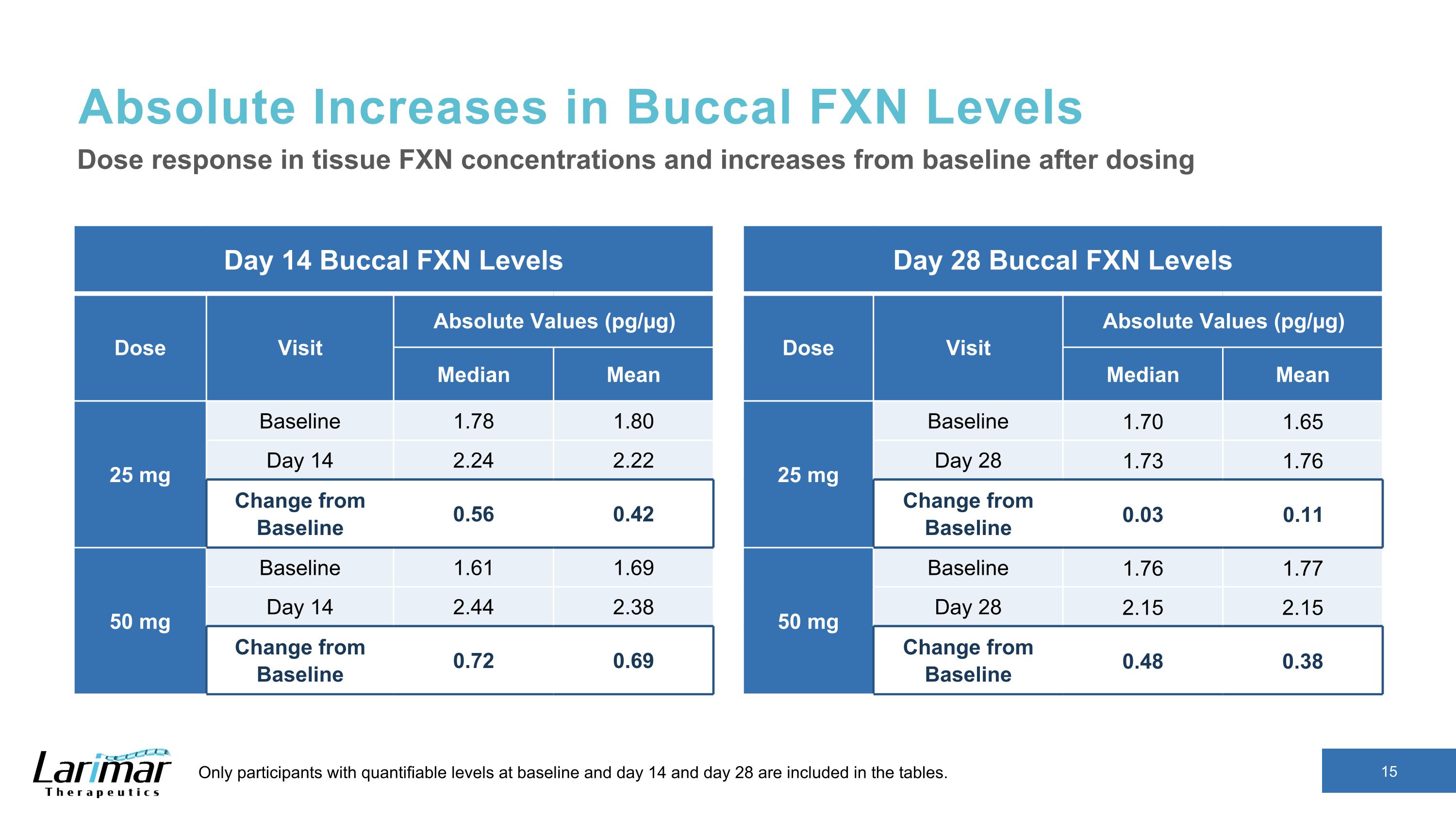
Absolute Increases in Buccal FXN Levels Day 14 Buccal FXN Levels Dose Visit Absolute Values (pg/µg) Median Mean 25 mg Baseline 1.78 1.80 Day 14 2.24 2.22 Change from Baseline 0.56 0.42 50 mg Baseline 1.61 1.69 Day 14 2.44 2.38 Change from Baseline 0.72 0.69 Dose response in tissue FXN concentrations and increases from baseline after dosing Only participants with quantifiable levels at baseline and day 14 and day 28 are included in the tables. Day 28 Buccal FXN Levels Dose Visit Absolute Values (pg/µg) Median Mean 25 mg Baseline 1.70 1.65 Day 28 1.73 1.76 Change from Baseline 0.03 0.11 50 mg Baseline 1.76 1.77 Day 28 2.15 2.15 Change from Baseline 0.48 0.38
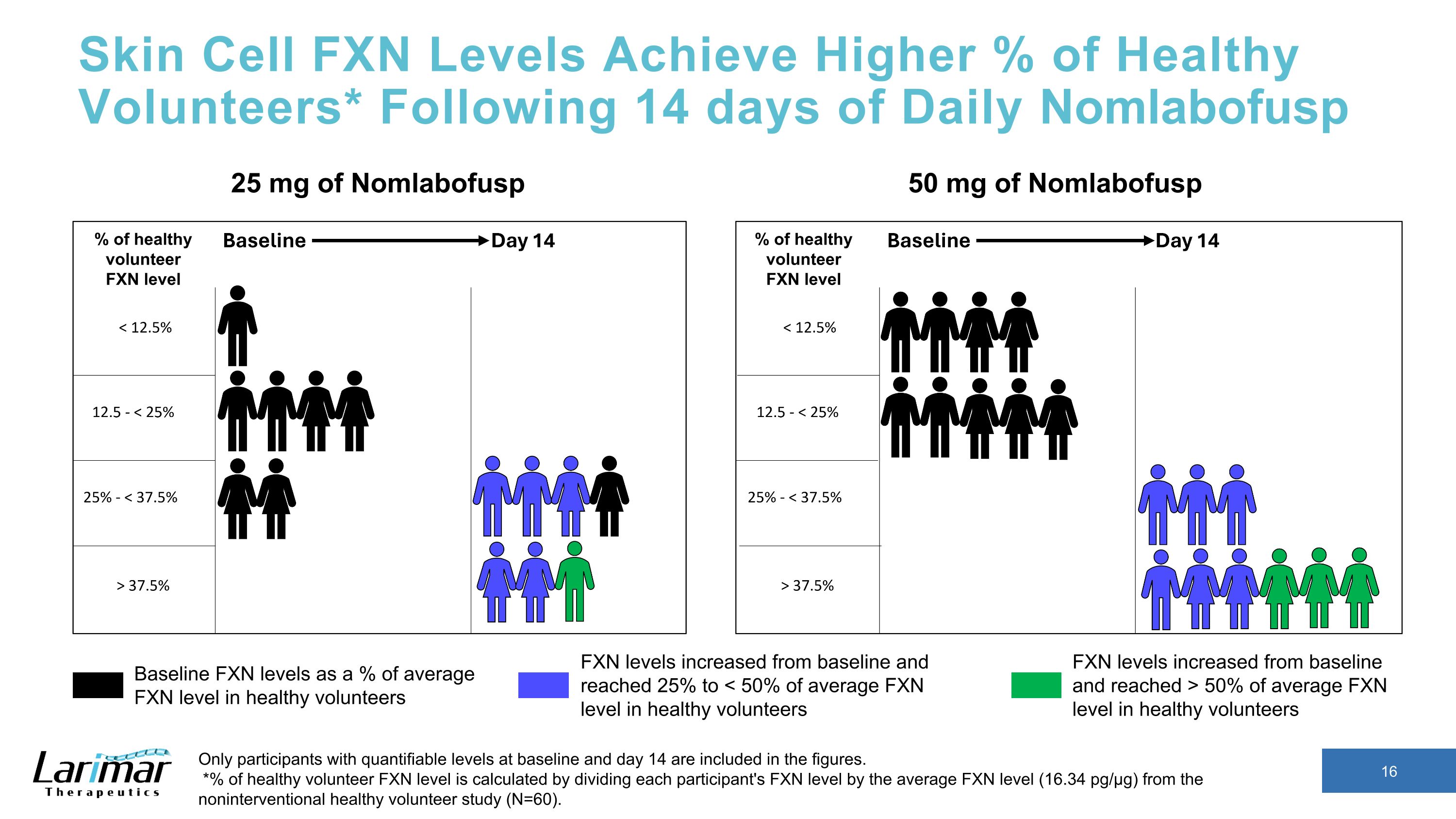
Skin Cell FXN Levels Achieve Higher % of Healthy Volunteers* Following 14 days of Daily Nomlabofusp Only participants with quantifiable levels at baseline and day 14 are included in the figures. *% of healthy volunteer FXN level is calculated by dividing each participant's FXN level by the average FXN level (16.34 pg/µg) from the noninterventional healthy volunteer study (N=60). 25 mg of Nomlabofusp 50 mg of Nomlabofusp Baseline FXN levels as a % of average FXN level in healthy volunteers FXN levels increased from baseline and reached > 50% of average FXN level in healthy volunteers FXN levels increased from baseline and reached 25% to < 50% of average FXN level in healthy volunteers % of healthy volunteer FXN level % of healthy volunteer FXN level

Buccal Cell FXN Levels Achieve Higher % of Healthy Volunteers* Following 14 days of Daily Nomlabofusp Only participants with quantifiable levels at baseline and day 14 are included in the figures. *% of healthy volunteer FXN level is calculated by dividing each participant's FXN level by the average FXN level (8.24 pg/µg) from Larimar’s noninterventional healthy volunteer study (N=60). 50 mg of Nomlabofusp Baseline FXN levels as a % of average FXN level in healthy volunteers FXN levels increased from baseline and reached 25% to �< 50% of average FXN level in healthy volunteers 25 mg of Nomlabofusp % of healthy volunteer FXN level % of healthy volunteer FXN level
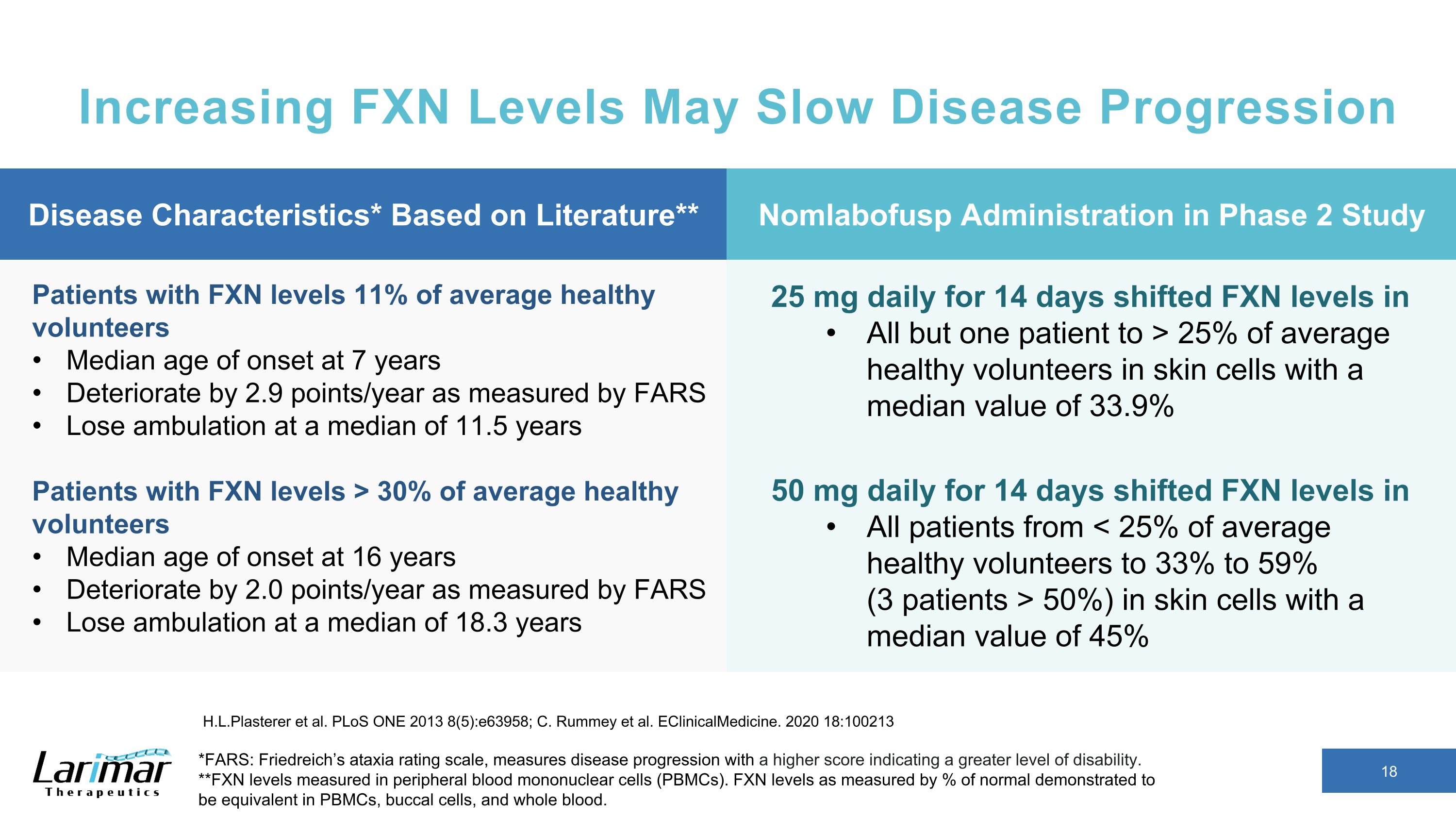
Increasing FXN Levels May Slow Disease Progression *FARS: Friedreich’s ataxia rating scale, measures disease progression with a higher score indicating a greater level of disability. **FXN levels measured in peripheral blood mononuclear cells (PBMCs). FXN levels as measured by % of normal demonstrated to be equivalent in PBMCs, buccal cells, and whole blood. H.L.Plasterer et al. PLoS ONE 2013 8(5):e63958; C. Rummey et al. EClinicalMedicine. 2020 18:100213 Patients with FXN levels 11% of average healthy volunteers Median age of onset at 7 years Deteriorate by 2.9 points/year as measured by FARS Lose ambulation at a median of 11.5 years Patients with FXN levels > 30% of average healthy volunteers Median age of onset at 16 years Deteriorate by 2.0 points/year as measured by FARS Lose ambulation at a median of 18.3 years 25 mg daily for 14 days shifted FXN levels in All but one patient to > 25% of average healthy volunteers in skin cells with a median value of 33.9% 50 mg daily for 14 days shifted FXN levels in All patients from < 25% of average healthy volunteers to 33% to 59% �(3 patients > 50%) in skin cells with a median value of 45% Disease Characteristics* Based on Literature** Nomlabofusp Administration in Phase 2 Study
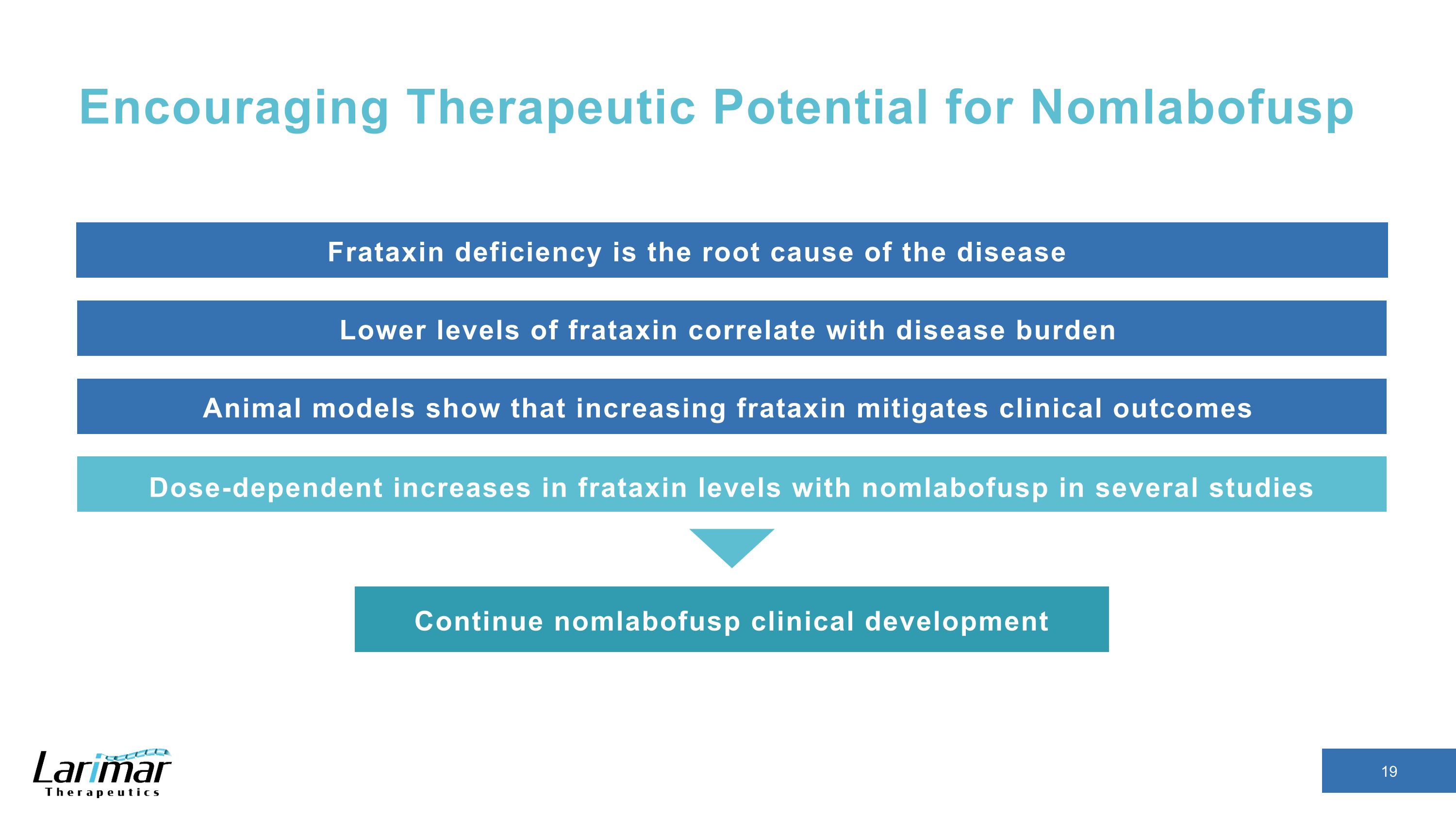
Encouraging Therapeutic Potential for Nomlabofusp Continue nomlabofusp clinical development Dose-dependent increases in frataxin levels with nomlabofusp in several studies Frataxin deficiency is the root cause of the disease Lower levels of frataxin correlate with disease burden Animal models show that increasing frataxin mitigates clinical outcomes
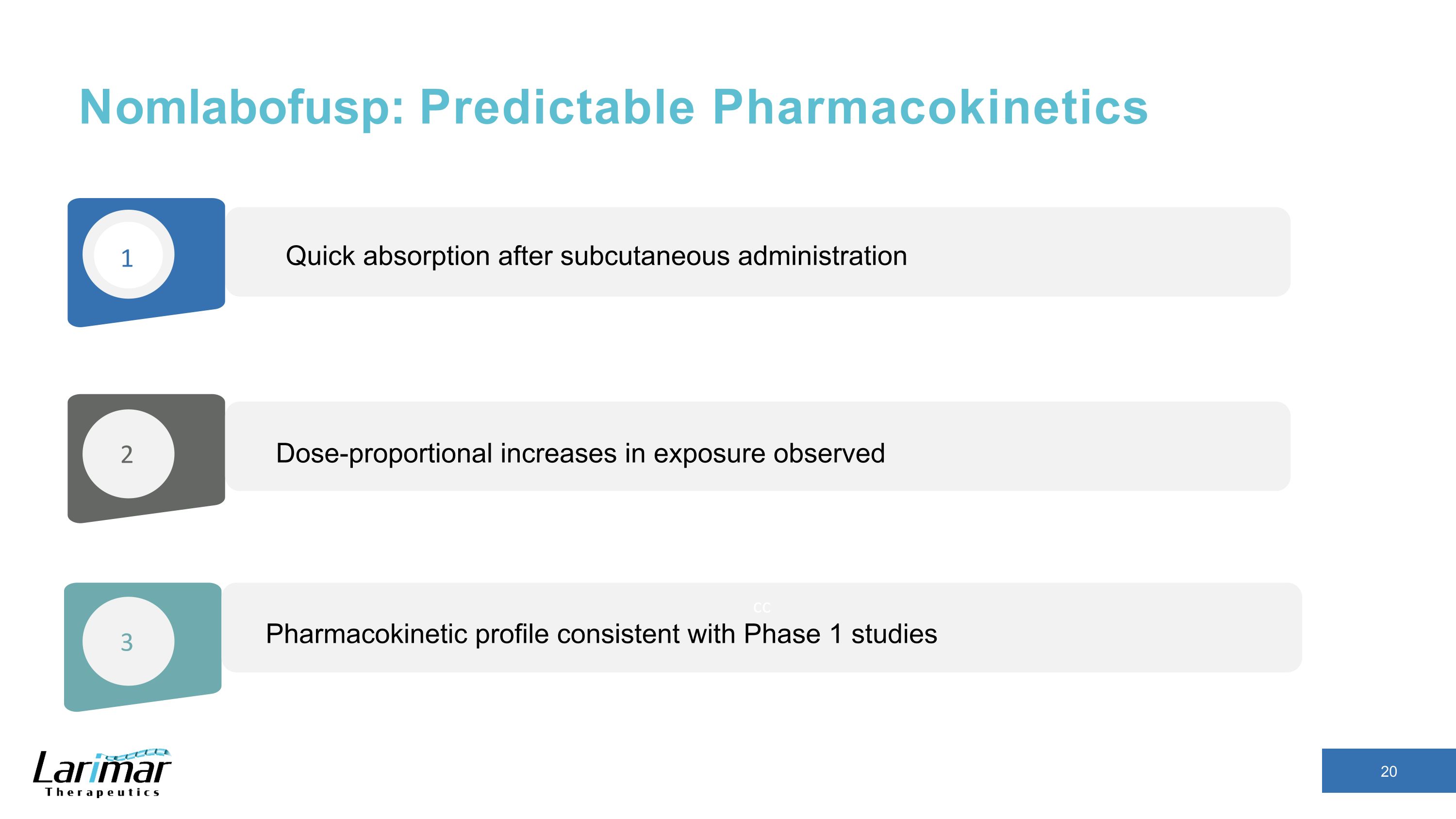
Nomlabofusp: Predictable Pharmacokinetics Quick absorption after subcutaneous administration 1 2 3 Dose-proportional increases in exposure observed cc Pharmacokinetic profile consistent with Phase 1 studies
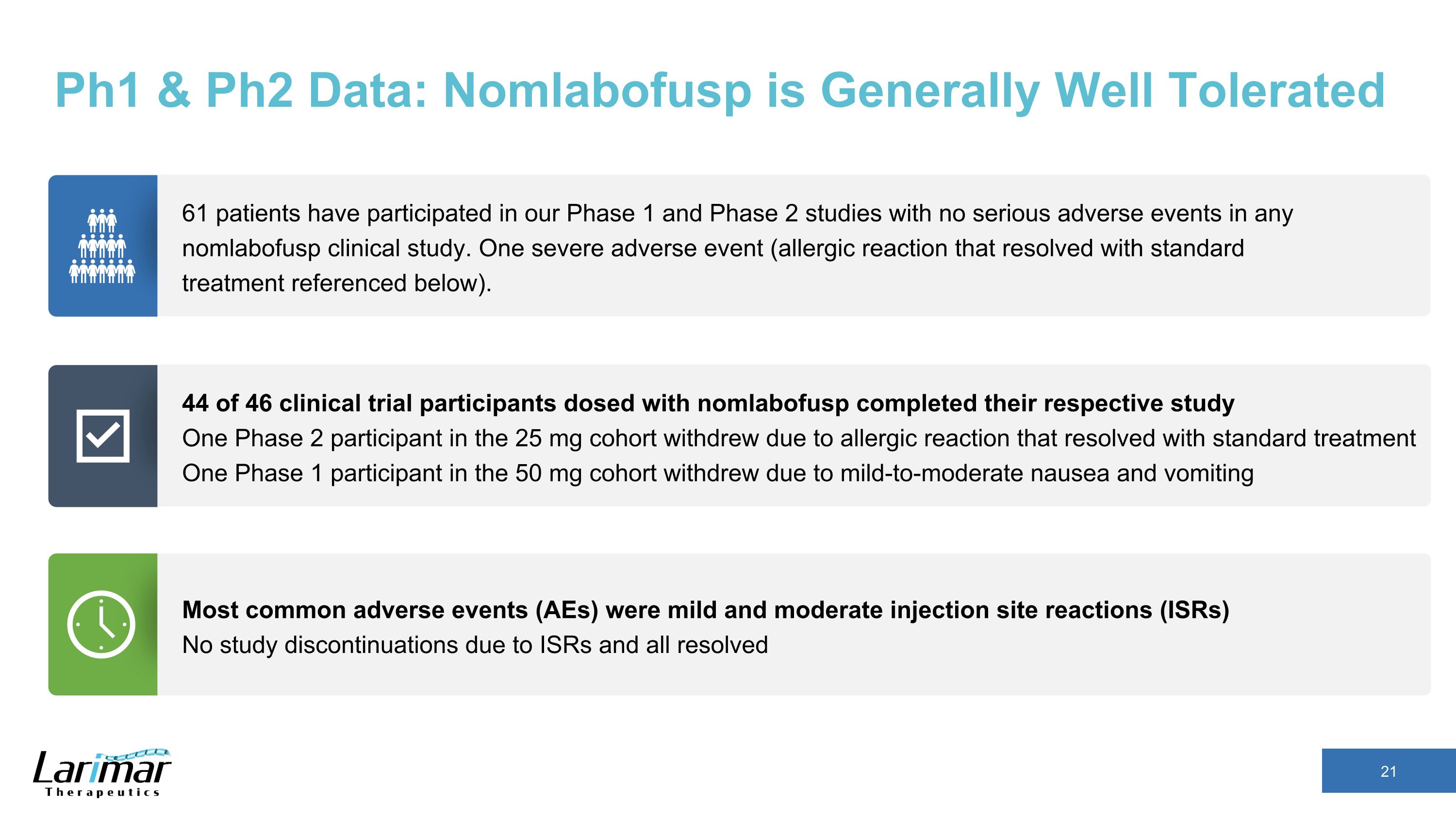
Ph1 & Ph2 Data: Nomlabofusp is Generally Well Tolerated 44 of 46 clinical trial participants dosed with nomlabofusp completed their respective study One Phase 2 participant in the 25 mg cohort withdrew due to allergic reaction that resolved with standard treatment One Phase 1 participant in the 50 mg cohort withdrew due to mild-to-moderate nausea and vomiting 61 patients have participated in our Phase 1 and Phase 2 studies with no serious adverse events in any nomlabofusp clinical study. One severe adverse event (allergic reaction that resolved with standard treatment referenced below). Most common adverse events (AEs) were mild and moderate injection site reactions (ISRs) No study discontinuations due to ISRs and all resolved
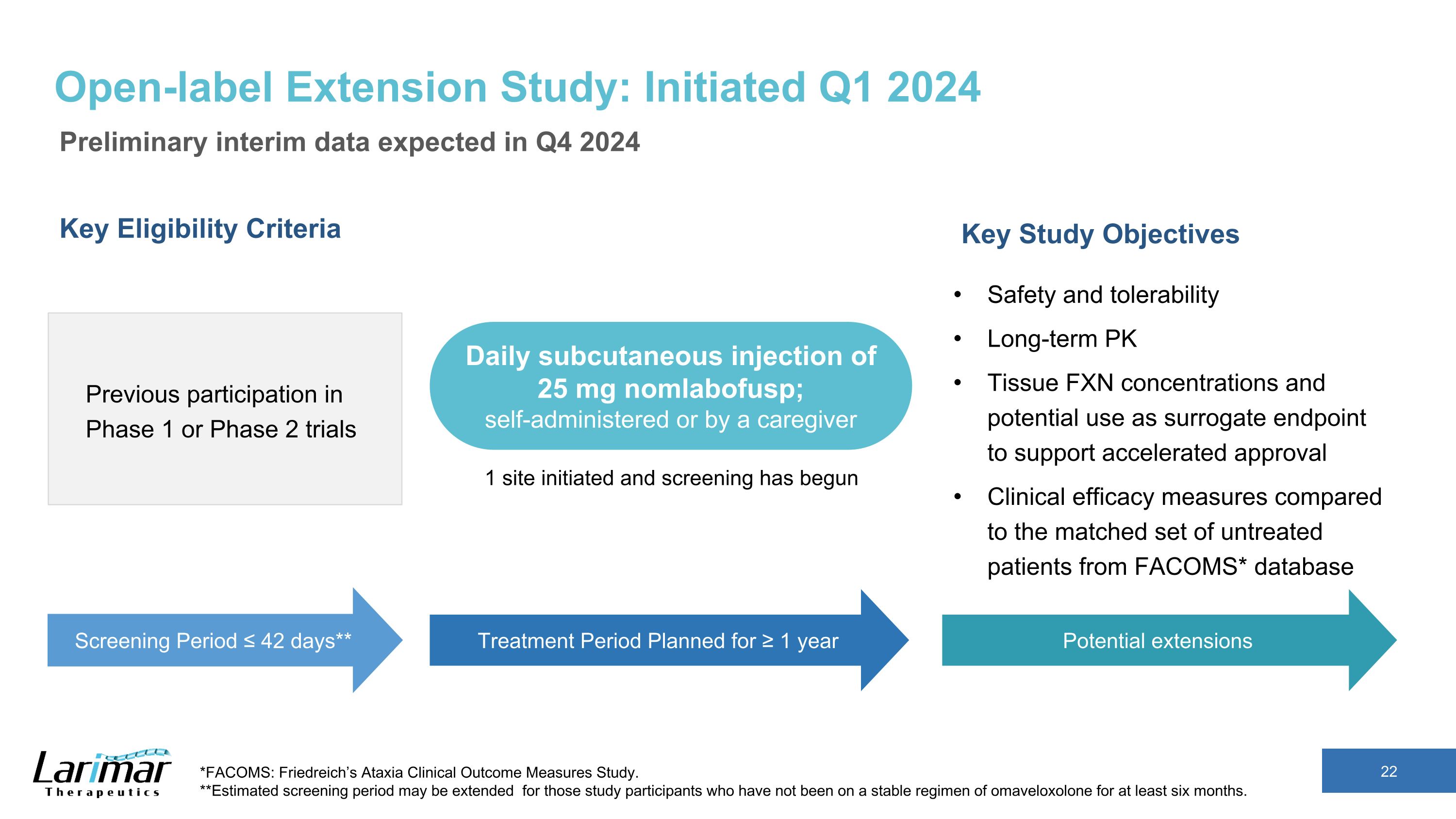
Open-label Extension Study: Initiated Q1 2024 Preliminary interim data expected in Q4 2024 Key Eligibility Criteria Previous participation in Phase 1 or Phase 2 trials Key Study Objectives Safety and tolerability Long-term PK Tissue FXN concentrations and potential use as surrogate endpoint to support accelerated approval Clinical efficacy measures compared to the matched set of untreated patients from FACOMS* database *FACOMS: Friedreich’s Ataxia Clinical Outcome Measures Study. **Estimated screening period may be extended for those study participants who have not been on a stable regimen of omaveloxolone for at least six months. Screening Period ≤ 42 days** Treatment Period Planned for ≥ 1 year Daily subcutaneous injection of 25 mg nomlabofusp; self-administered or by a caregiver 1 site initiated and screening has begun Potential extensions
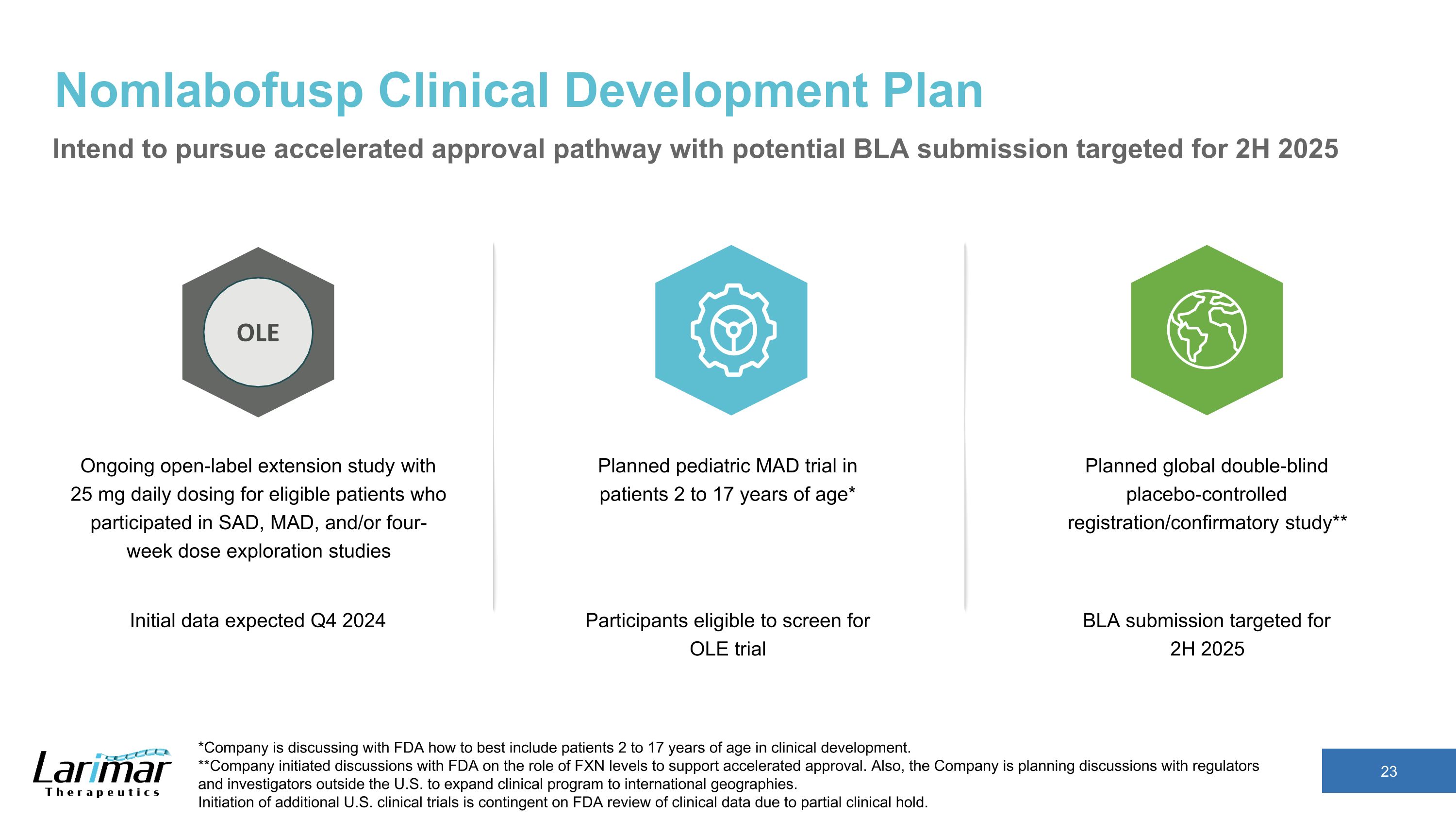
Nomlabofusp Clinical Development Plan Planned global double-blind placebo-controlled registration/confirmatory study** Planned pediatric MAD trial in patients 2 to 17 years of age* Intend to pursue accelerated approval pathway with potential BLA submission targeted for 2H 2025 *Company is discussing with FDA how to best include patients 2 to 17 years of age in clinical development. **Company initiated discussions with FDA on the role of FXN levels to support accelerated approval. Also, the Company is planning discussions with regulators and investigators outside the U.S. to expand clinical program to international geographies. Initiation of additional U.S. clinical trials is contingent on FDA review of clinical data due to partial clinical hold. Ongoing open-label extension study with 25 mg daily dosing for eligible patients who participated in SAD, MAD, and/or four-week dose exploration studies OLE BLA submission targeted for �2H 2025 Participants eligible to screen for OLE trial Initial data expected Q4 2024
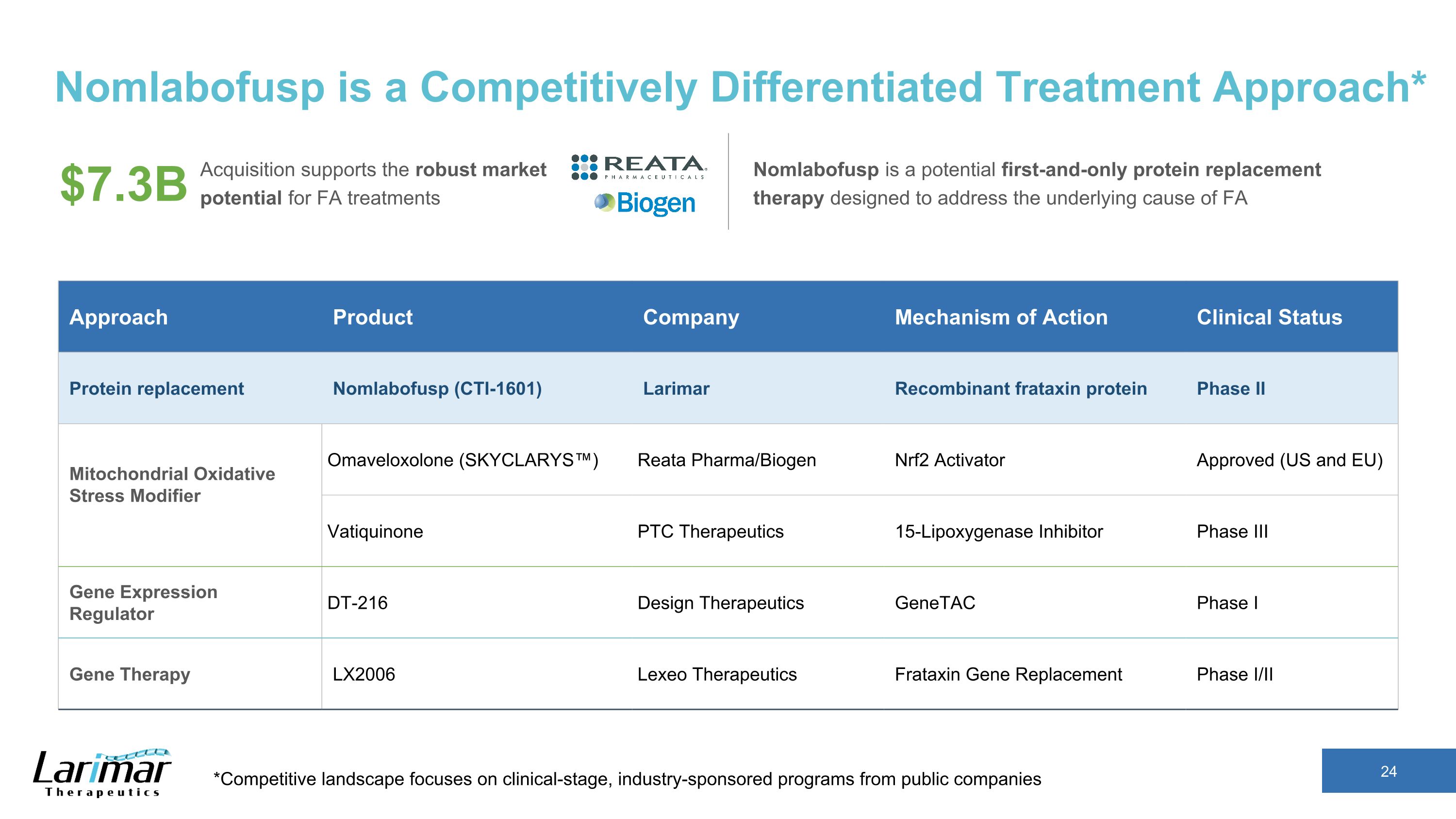
Nomlabofusp is a Competitively Differentiated Treatment Approach* *Competitive landscape focuses on clinical-stage, industry-sponsored programs from public companies Acquisition supports the robust market potential for FA treatments Nomlabofusp is a potential first-and-only protein replacement therapy designed to address the underlying cause of FA $7.3B Approach Product Company Mechanism of Action Clinical Status Protein replacement Nomlabofusp (CTI-1601) Larimar Recombinant frataxin protein Phase II Mitochondrial Oxidative Stress Modifier Omaveloxolone (SKYCLARYS™) Reata Pharma/Biogen Nrf2 Activator Approved (US and EU) Vatiquinone PTC Therapeutics 15-Lipoxygenase Inhibitor Phase III Gene Expression Regulator DT-216 Design Therapeutics GeneTAC Phase I Gene Therapy LX2006 Lexeo Therapeutics Frataxin Gene Replacement Phase I/II
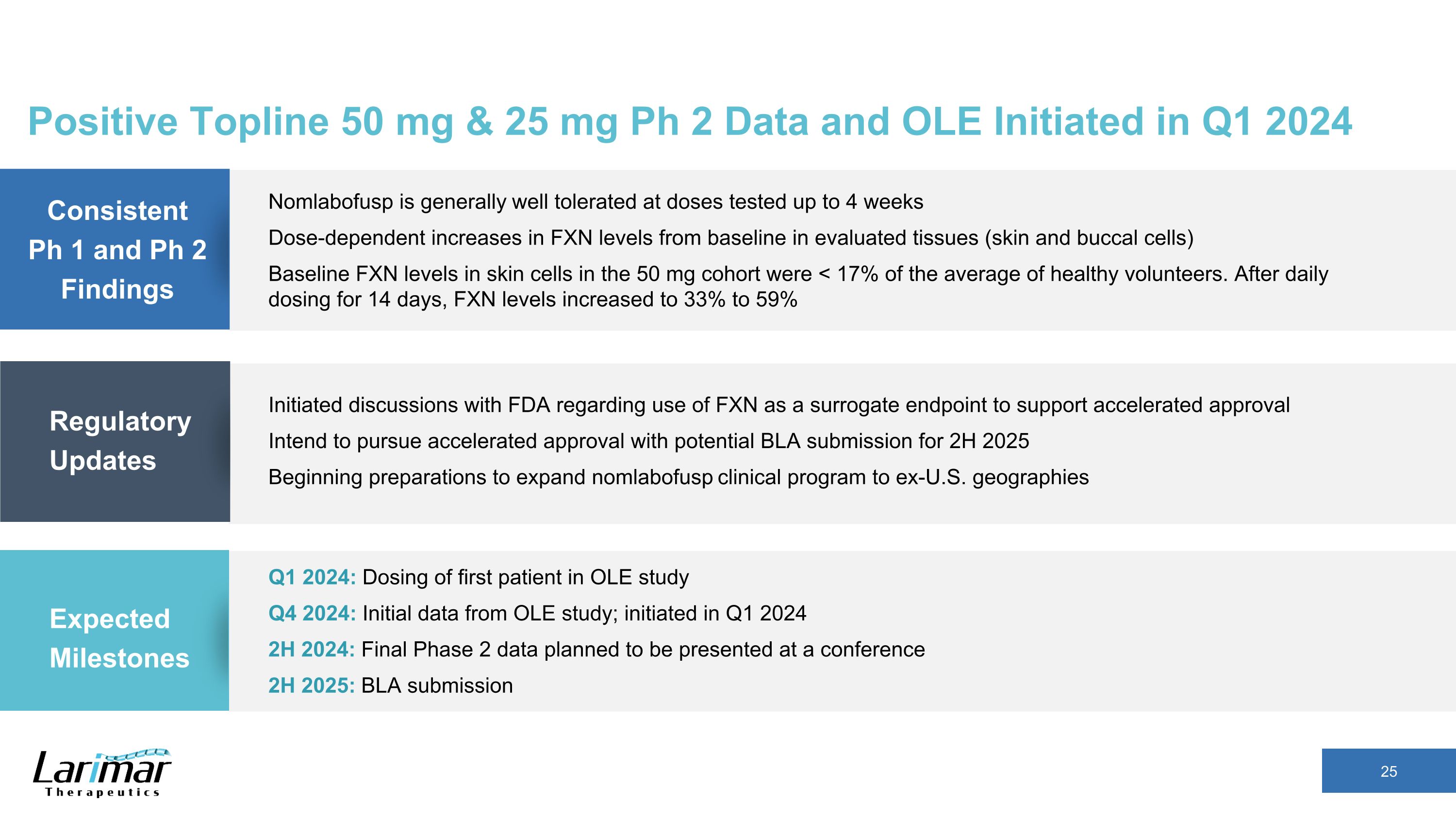
Regulatory Updates Q1 2024: Dosing of first patient in OLE study Q4 2024: Initial data from OLE study; initiated in Q1 2024 2H 2024: Final Phase 2 data planned to be presented at a conference 2H 2025: BLA submission Expected Milestones Consistent Ph 1 and Ph 2 Findings Initiated discussions with FDA regarding use of FXN as a surrogate endpoint to support accelerated approval Intend to pursue accelerated approval with potential BLA submission for 2H 2025 Beginning preparations to expand nomlabofusp clinical program to ex-U.S. geographies Nomlabofusp is generally well tolerated at doses tested up to 4 weeks Dose-dependent increases in FXN levels from baseline in evaluated tissues (skin and buccal cells) Baseline FXN levels in skin cells in the 50 mg cohort were < 17% of the average of healthy volunteers. After daily dosing for 14 days, FXN levels increased to 33% to 59% Positive Topline 50 mg & 25 mg Ph 2 Data and OLE Initiated in Q1 2024
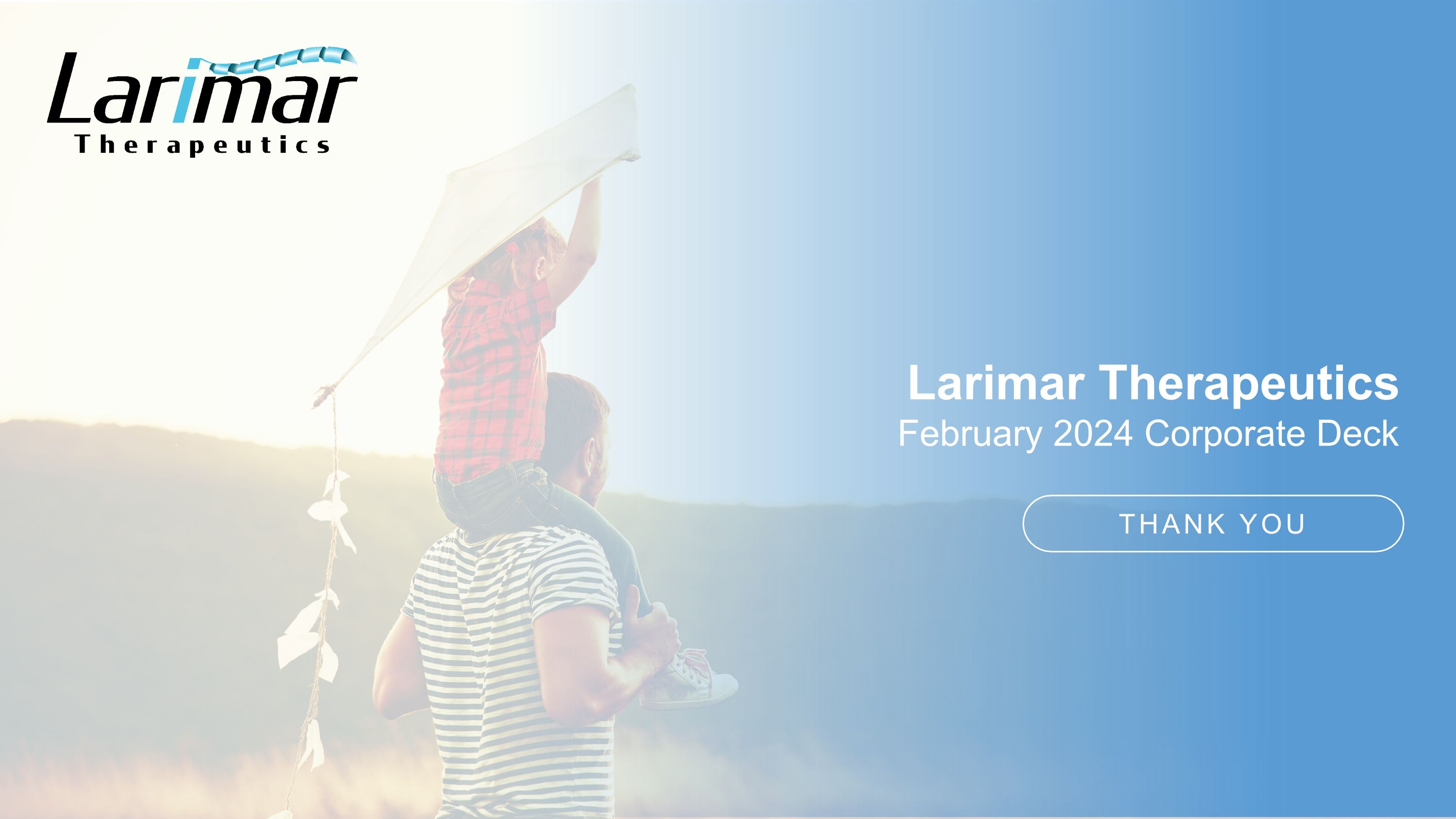
THANK YOU Larimar Therapeutics February 2024 Corporate Deck
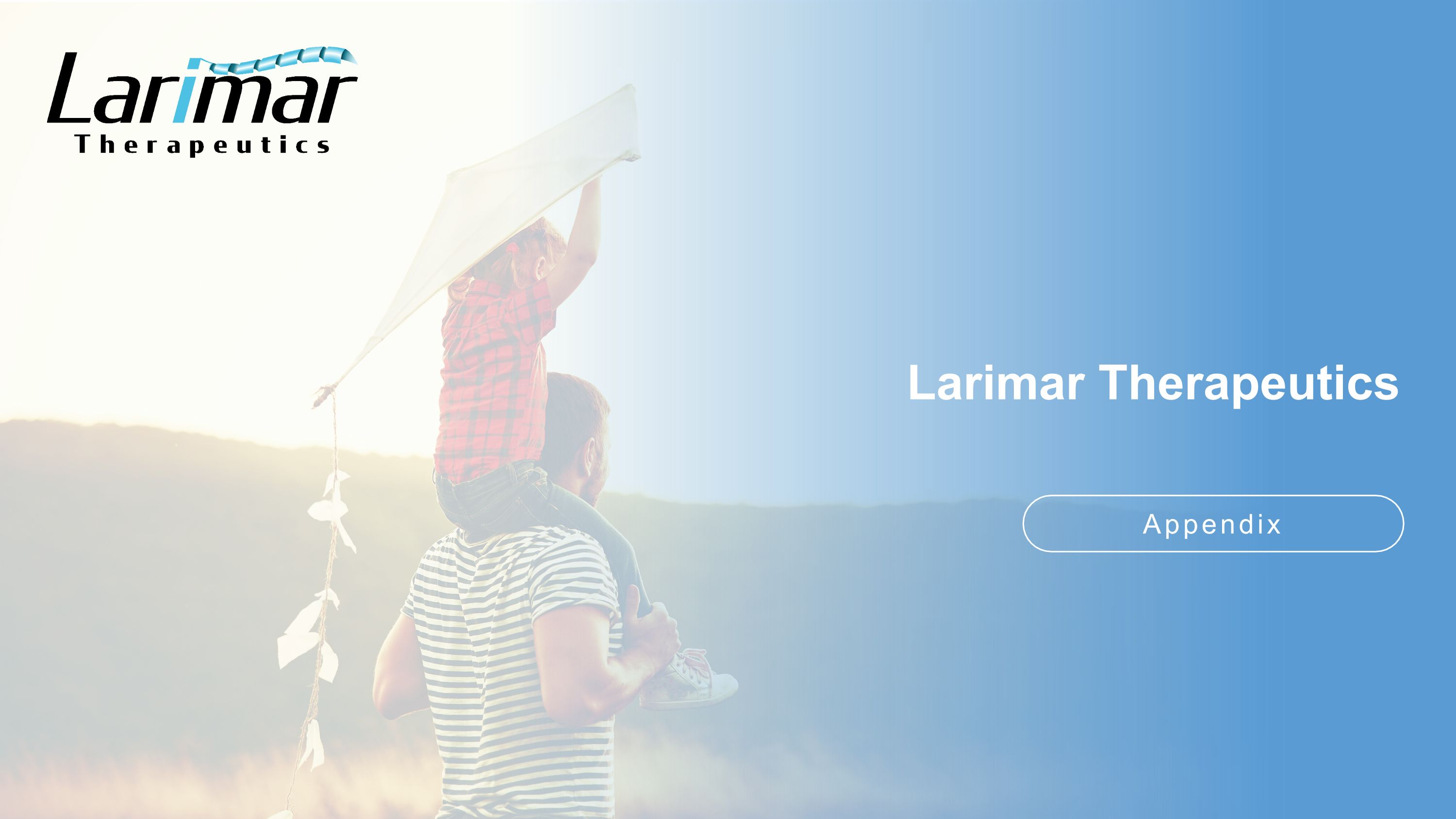
Appendix Larimar Therapeutics

Scientific Advisory Board Co-founder of Chondrial Therapeutics, which became Larimar Therapeutics, Inc. Professor of Pediatrics at Indiana University School of Medicine Mark Payne, MD Executive Director of the Mitochondrial Medicine Frontier Program at The Children’s Hospital of Philadelphia (CHOP) Professor in the Division of Human Genetics, Department of Pediatrics at University of Pennsylvania Perelman School of Medicine Marni J. Falk, MD Medical Director and Division Chief of the University of California San Francisco (UCSF) Movement Disorders and Neuromodulation Center. Carlin and Ellen Wiegner Endowed Professor of Neurology Jill Ostrem, MD Giovanni Manfredi, MD, PhD Finbar and Marianne Kenny Professor in Clinical and Research Neurology at Weill Cornell Medicine. Professor of Neuroscience at Weill Cornell Medicine.
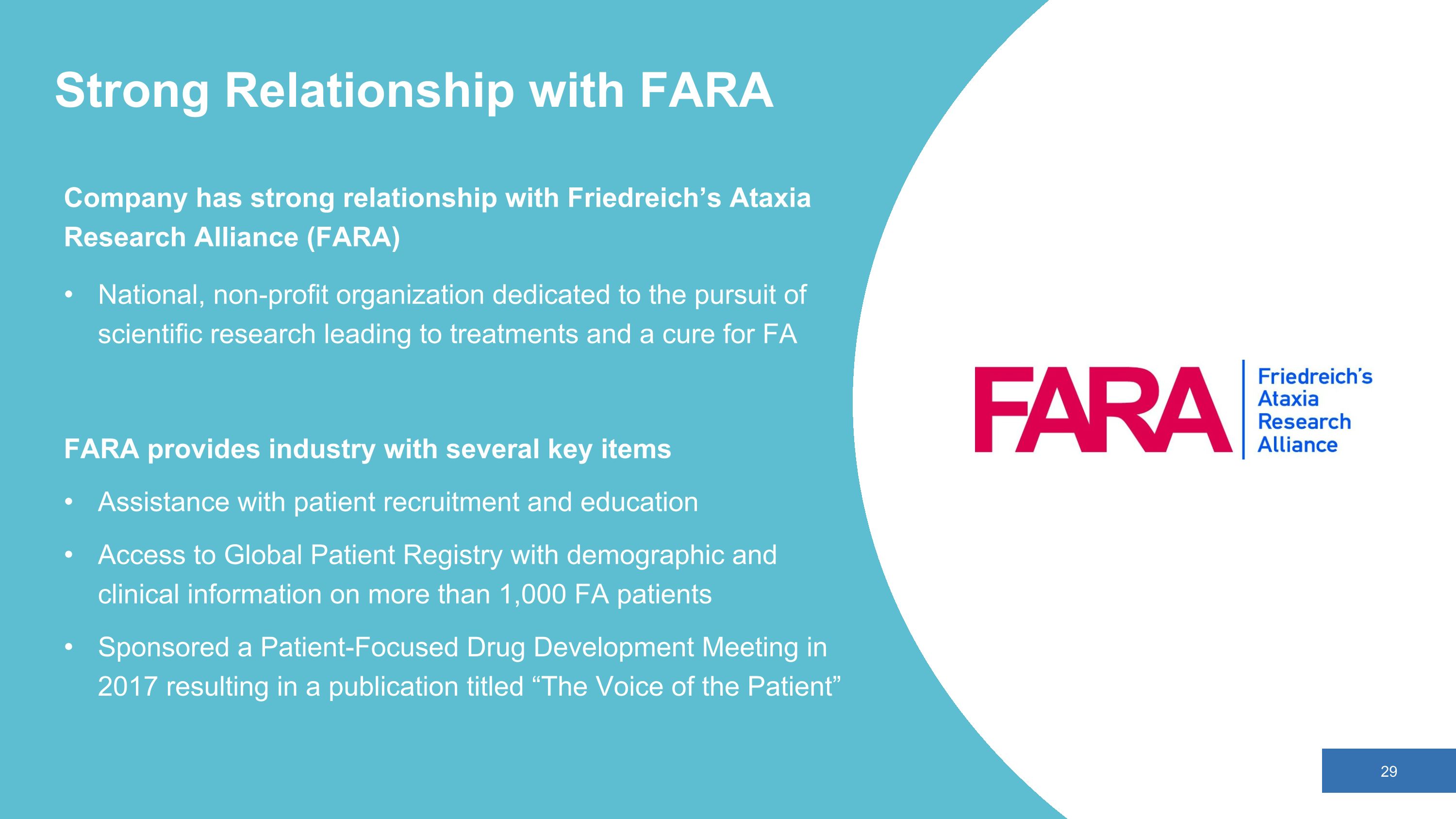
Company has strong relationship with Friedreich’s Ataxia Research Alliance (FARA) National, non-profit organization dedicated to the pursuit of scientific research leading to treatments and a cure for FA FARA provides industry with several key items Assistance with patient recruitment and education Access to Global Patient Registry with demographic and clinical information on more than 1,000 FA patients Sponsored a Patient-Focused Drug Development Meeting in 2017 resulting in a publication titled “The Voice of the Patient” Strong Relationship with FARA
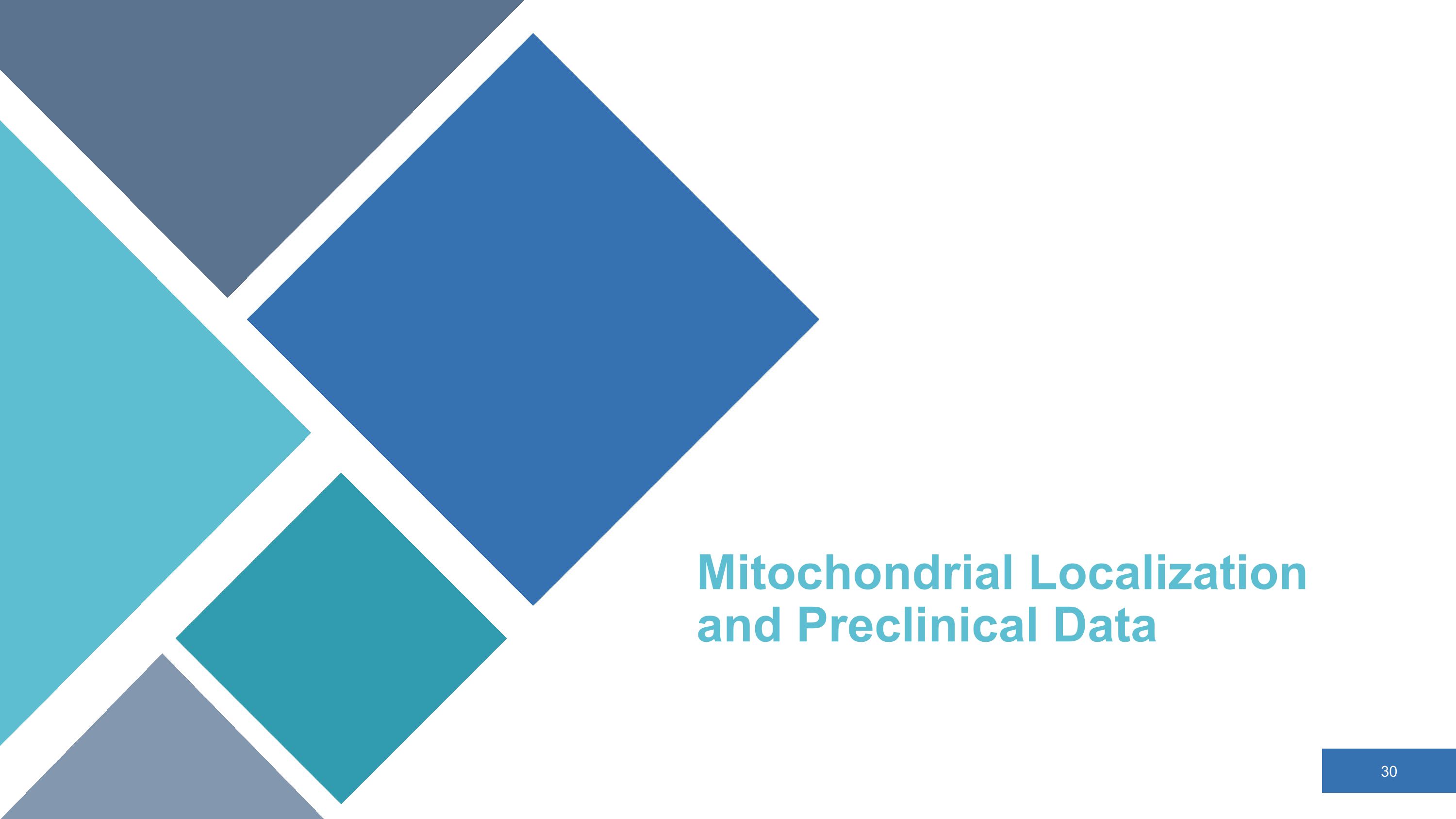
Mitochondrial Localization and Preclinical Data
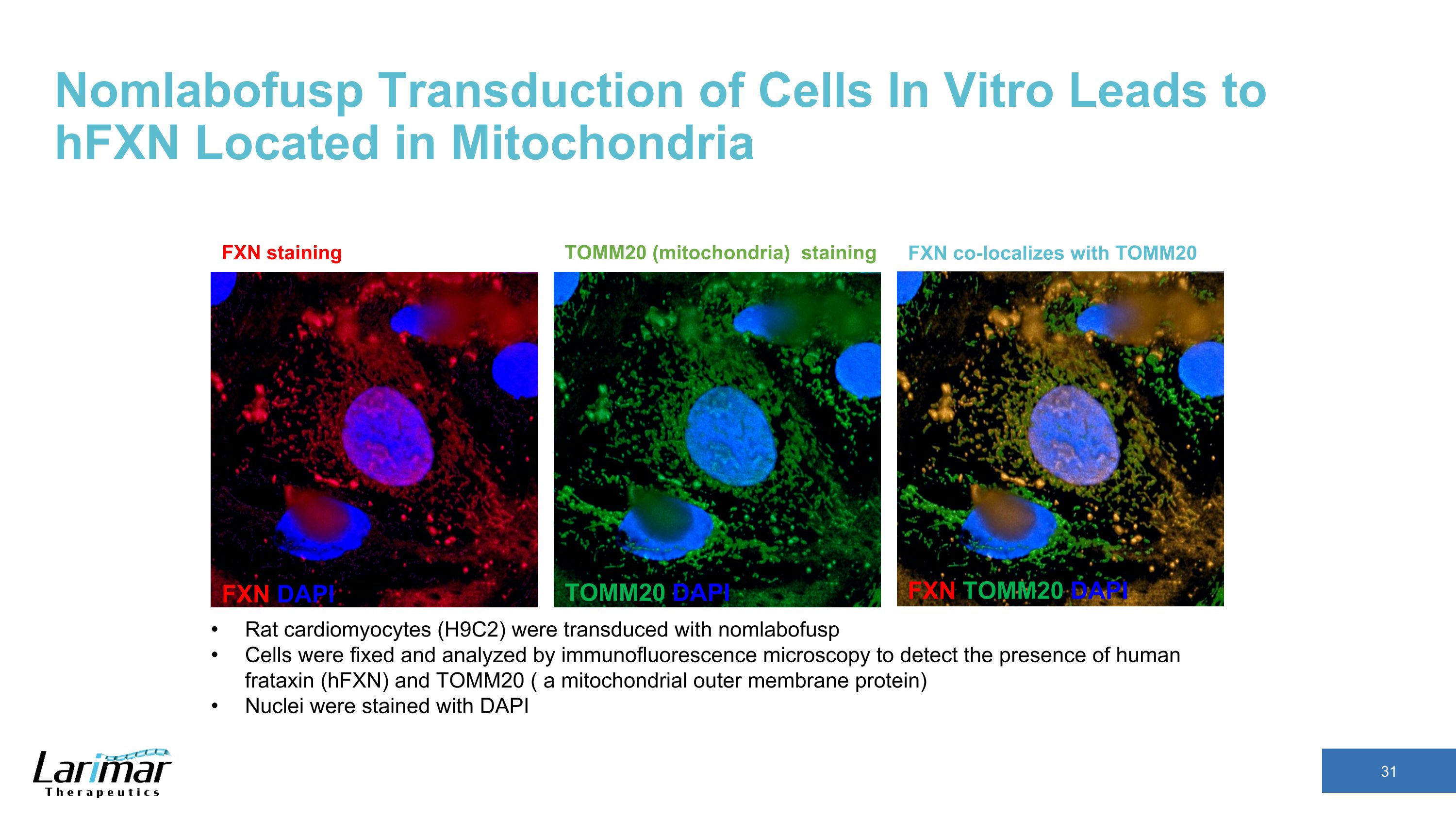
Nomlabofusp Transduction of Cells In Vitro Leads to �hFXN Located in Mitochondria FXN DAPI TOMM20 DAPI FXN TOMM20 DAPI FXN co-localizes with TOMM20 FXN staining TOMM20 (mitochondria) staining Rat cardiomyocytes (H9C2) were transduced with nomlabofusp Cells were fixed and analyzed by immunofluorescence microscopy to detect the presence of human frataxin (hFXN) and TOMM20 ( a mitochondrial outer membrane protein) Nuclei were stained with DAPI
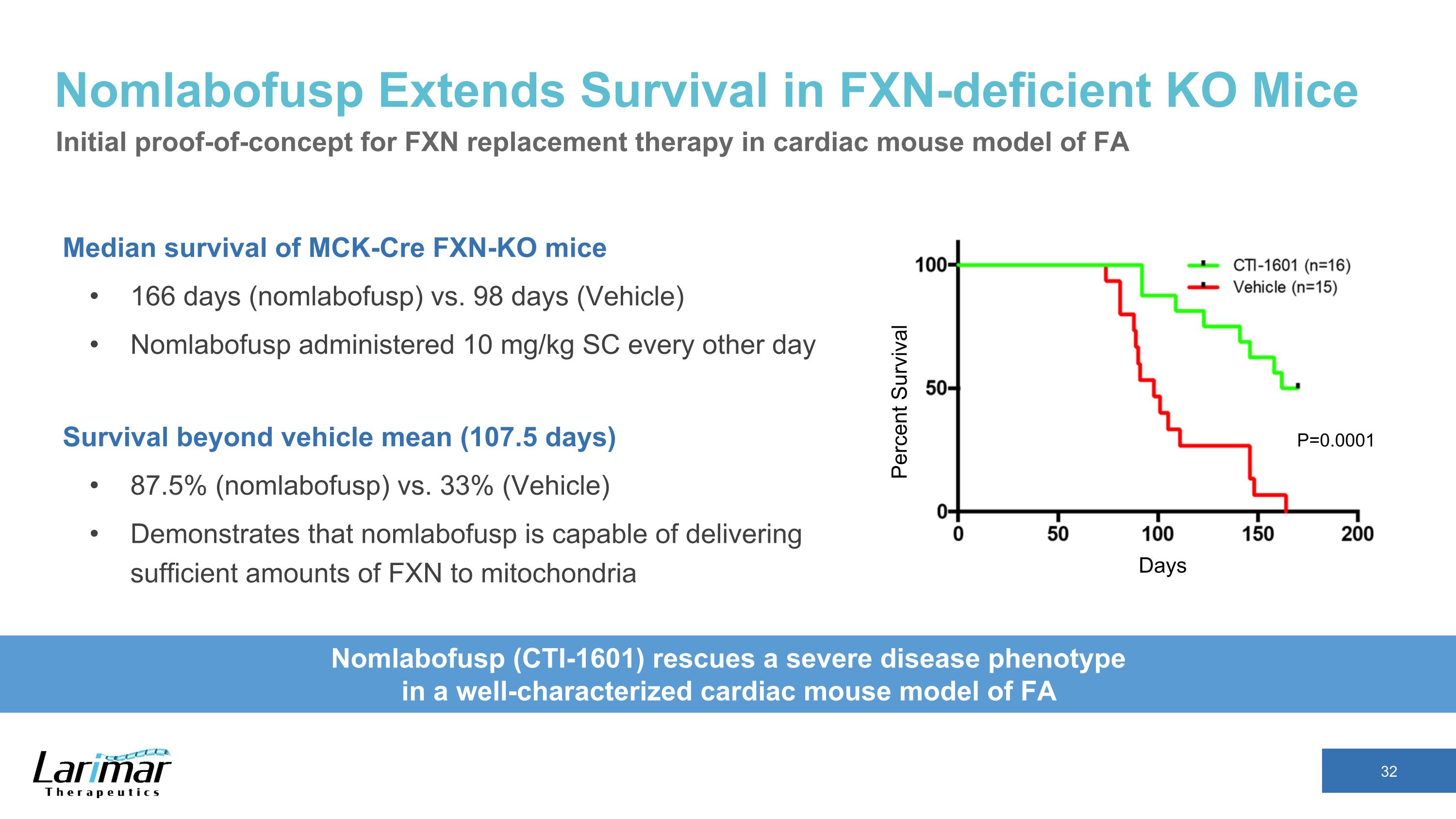
Nomlabofusp Extends Survival in FXN-deficient KO Mice Median survival of MCK-Cre FXN-KO mice 166 days (nomlabofusp) vs. 98 days (Vehicle) Nomlabofusp administered 10 mg/kg SC every other day Survival beyond vehicle mean (107.5 days) 87.5% (nomlabofusp) vs. 33% (Vehicle) Demonstrates that nomlabofusp is capable of delivering sufficient amounts of FXN to mitochondria Days Percent Survival Nomlabofusp (CTI-1601) rescues a severe disease phenotype �in a well-characterized cardiac mouse model of FA P=0.0001 Initial proof-of-concept for FXN replacement therapy in cardiac mouse model of FA
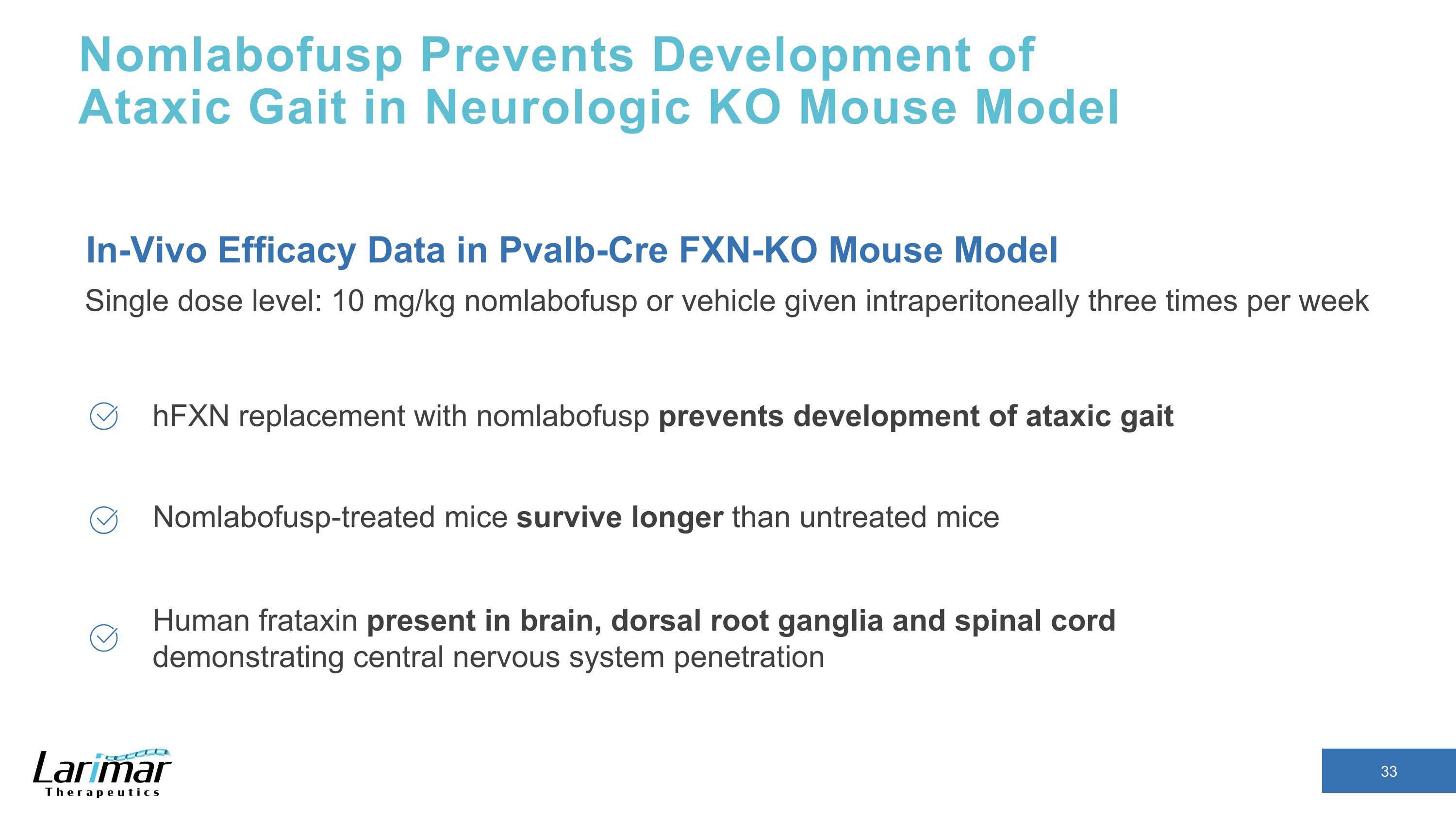
Nomlabofusp Prevents Development of �Ataxic Gait in Neurologic KO Mouse Model hFXN replacement with nomlabofusp prevents development of ataxic gait Nomlabofusp-treated mice survive longer than untreated mice Human frataxin present in brain, dorsal root ganglia and spinal cord demonstrating central nervous system penetration In-Vivo Efficacy Data in Pvalb-Cre FXN-KO Mouse Model Single dose level: 10 mg/kg nomlabofusp or vehicle given intraperitoneally three times per week
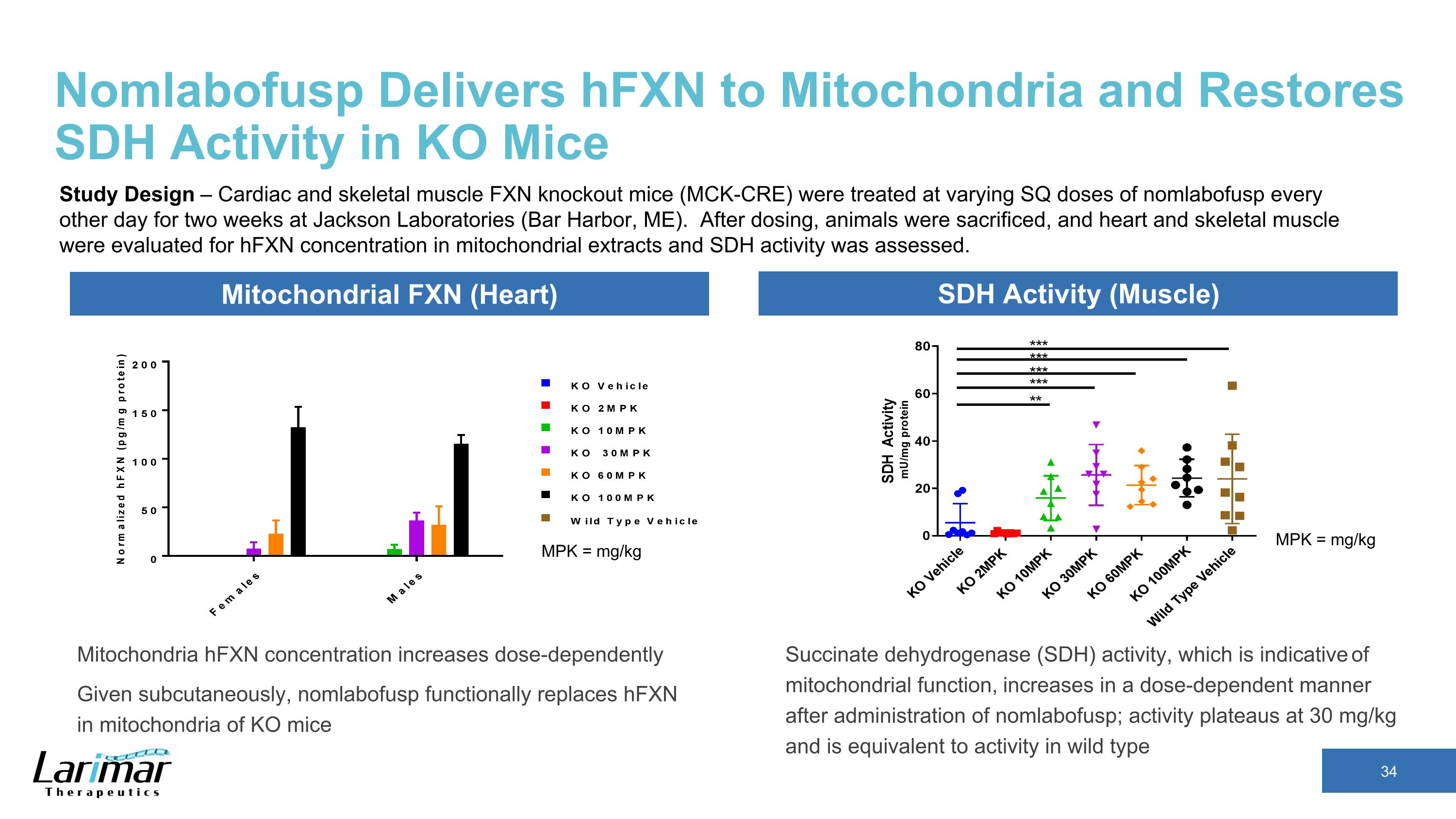
Nomlabofusp Delivers hFXN to Mitochondria and Restores SDH Activity in KO Mice Mitochondria hFXN concentration increases dose-dependently Given subcutaneously, nomlabofusp functionally replaces hFXN in mitochondria of KO mice MPK = mg/kg MPK = mg/kg Mitochondrial FXN (Heart) SDH Activity (Muscle) Succinate dehydrogenase (SDH) activity, which is indicative of mitochondrial function, increases in a dose-dependent manner after administration of nomlabofusp; activity plateaus at 30 mg/kg and is equivalent to activity in wild type Study Design – Cardiac and skeletal muscle FXN knockout mice (MCK-CRE) were treated at varying SQ doses of nomlabofusp every other day for two weeks at Jackson Laboratories (Bar Harbor, ME). After dosing, animals were sacrificed, and heart and skeletal muscle were evaluated for hFXN concentration in mitochondrial extracts and SDH activity was assessed.
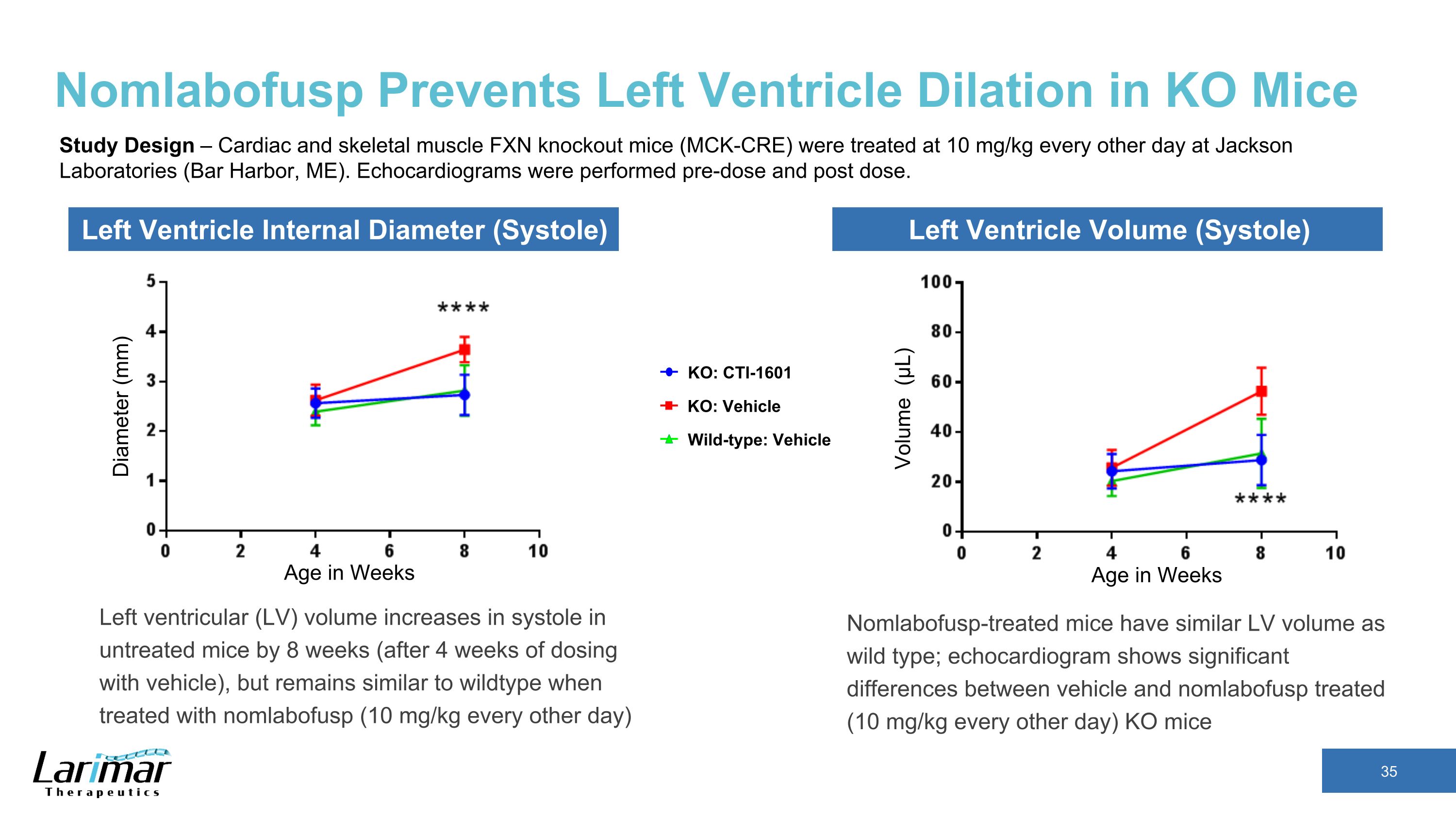
Nomlabofusp Prevents Left Ventricle Dilation in KO Mice Left ventricular (LV) volume increases in systole in untreated mice by 8 weeks (after 4 weeks of dosing with vehicle), but remains similar to wildtype when treated with nomlabofusp (10 mg/kg every other day) Diameter (mm) Age in Weeks Age in Weeks Volume (μL) KO: CTI-1601 Wild-type: Vehicle KO: Vehicle Left Ventricle Internal Diameter (Systole) Left Ventricle Volume (Systole) Study Design – Cardiac and skeletal muscle FXN knockout mice (MCK-CRE) were treated at 10 mg/kg every other day at Jackson Laboratories (Bar Harbor, ME). Echocardiograms were performed pre-dose and post dose. Nomlabofusp-treated mice have similar LV volume as wild type; echocardiogram shows significant differences between vehicle and nomlabofusp treated (10 mg/kg every other day) KO mice
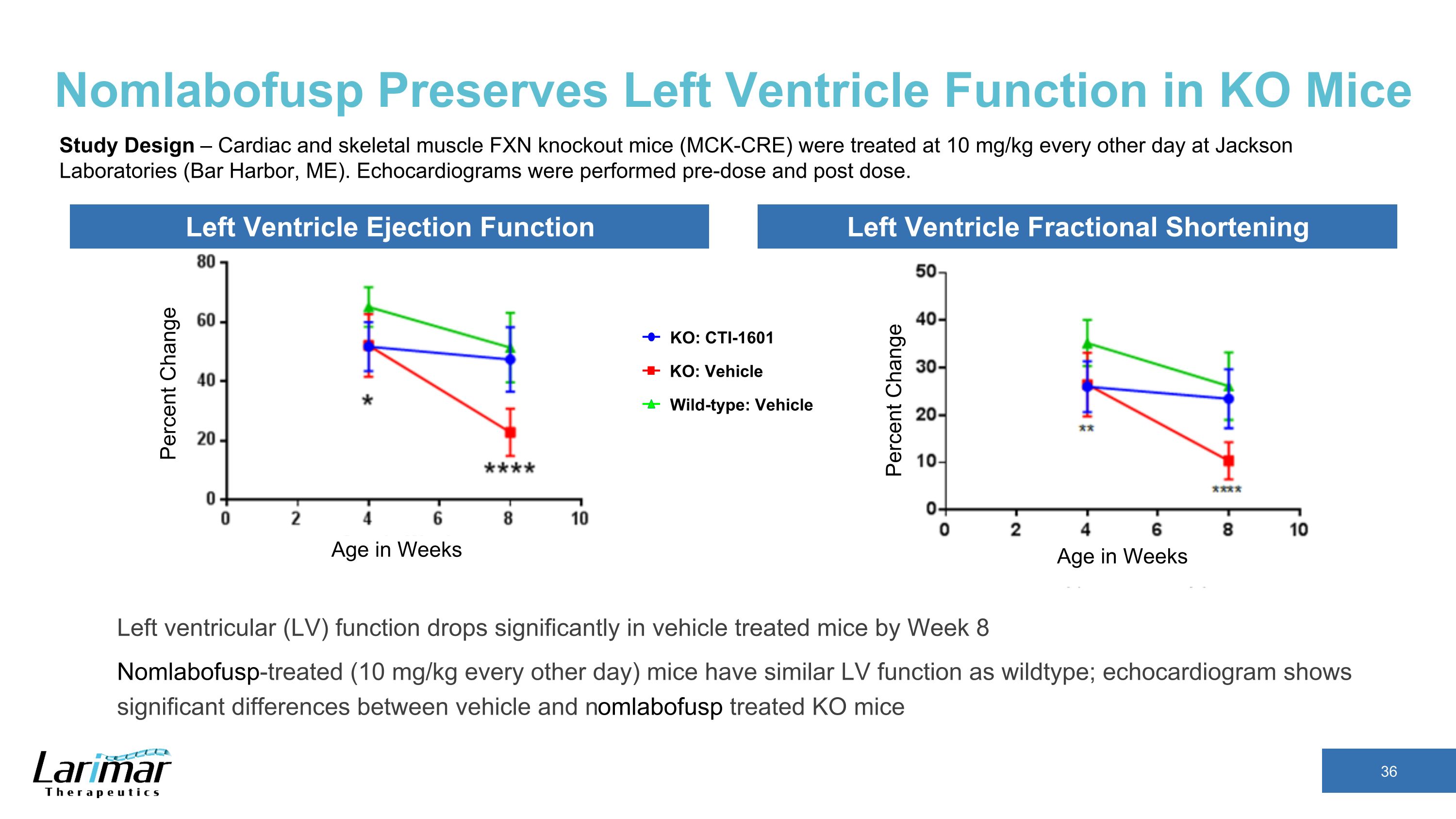
Nomlabofusp Preserves Left Ventricle Function in KO Mice Percent Change Age in Weeks Left Ventricle Ejection Function Left Ventricle Fractional Shortening Percent Change Age in Weeks KO: CTI-1601 Wild-type: Vehicle KO: Vehicle Study Design – Cardiac and skeletal muscle FXN knockout mice (MCK-CRE) were treated at 10 mg/kg every other day at Jackson Laboratories (Bar Harbor, ME). Echocardiograms were performed pre-dose and post dose. Left ventricular (LV) function drops significantly in vehicle treated mice by Week 8 Nomlabofusp-treated (10 mg/kg every other day) mice have similar LV function as wildtype; echocardiogram shows significant differences between vehicle and nomlabofusp treated KO mice
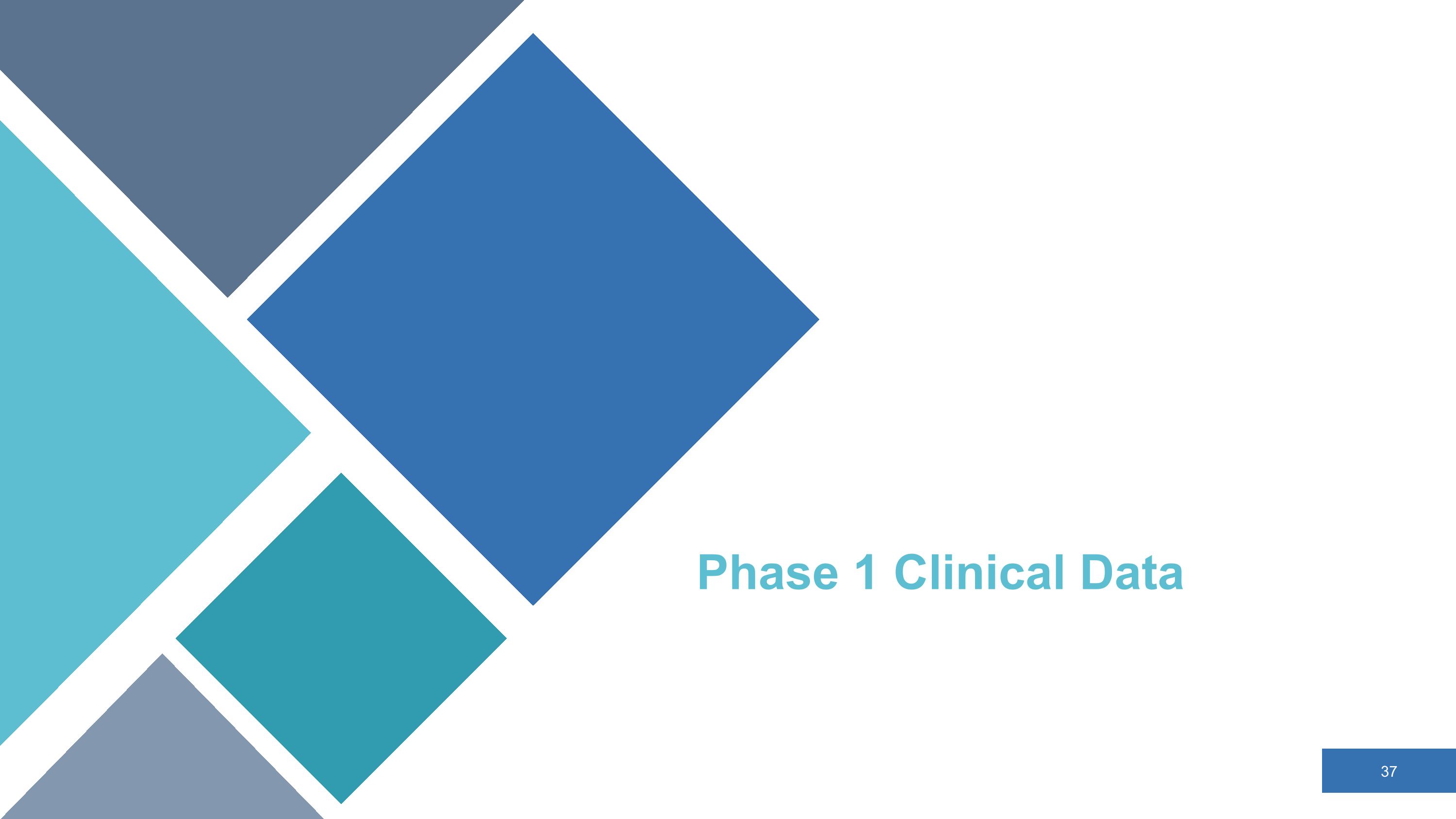
Phase 1 Clinical Data
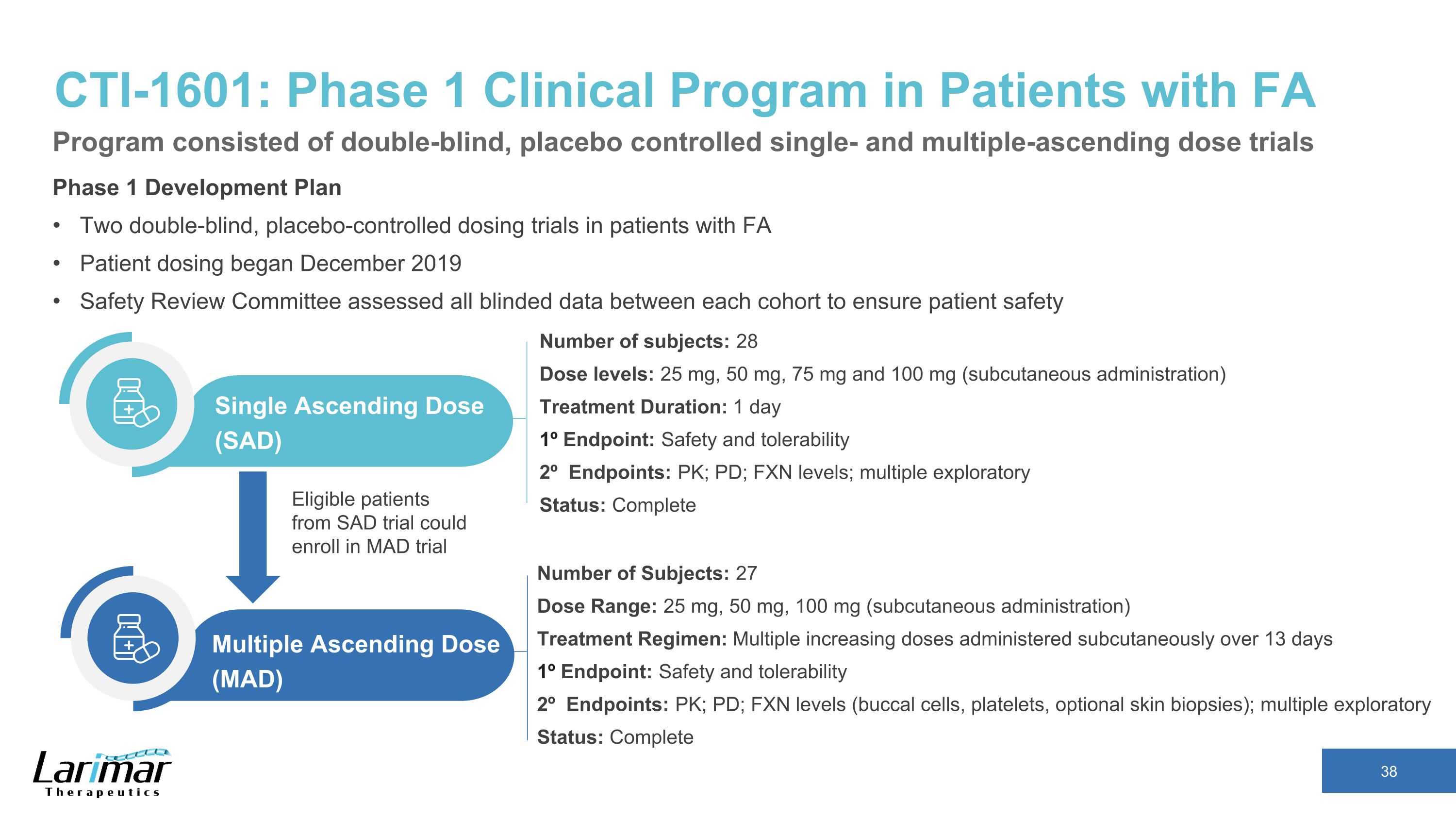
CTI-1601: Phase 1 Clinical Program in Patients with FA Phase 1 Development Plan Two double-blind, placebo-controlled dosing trials in patients with FA Patient dosing began December 2019 Safety Review Committee assessed all blinded data between each cohort to ensure patient safety Number of subjects: 28 Dose levels: 25 mg, 50 mg, 75 mg and 100 mg (subcutaneous administration) Treatment Duration: 1 day 1º Endpoint: Safety and tolerability 2º Endpoints: PK; PD; FXN levels; multiple exploratory Status: Complete Single Ascending Dose (SAD) Number of Subjects: 27 Dose Range: 25 mg, 50 mg, 100 mg (subcutaneous administration) Treatment Regimen: Multiple increasing doses administered subcutaneously over 13 days 1º Endpoint: Safety and tolerability 2º Endpoints: PK; PD; FXN levels (buccal cells, platelets, optional skin biopsies); multiple exploratory Status: Complete Multiple Ascending Dose (MAD) Eligible patients from SAD trial could enroll in MAD trial Program consisted of double-blind, placebo controlled single- and multiple-ascending dose trials
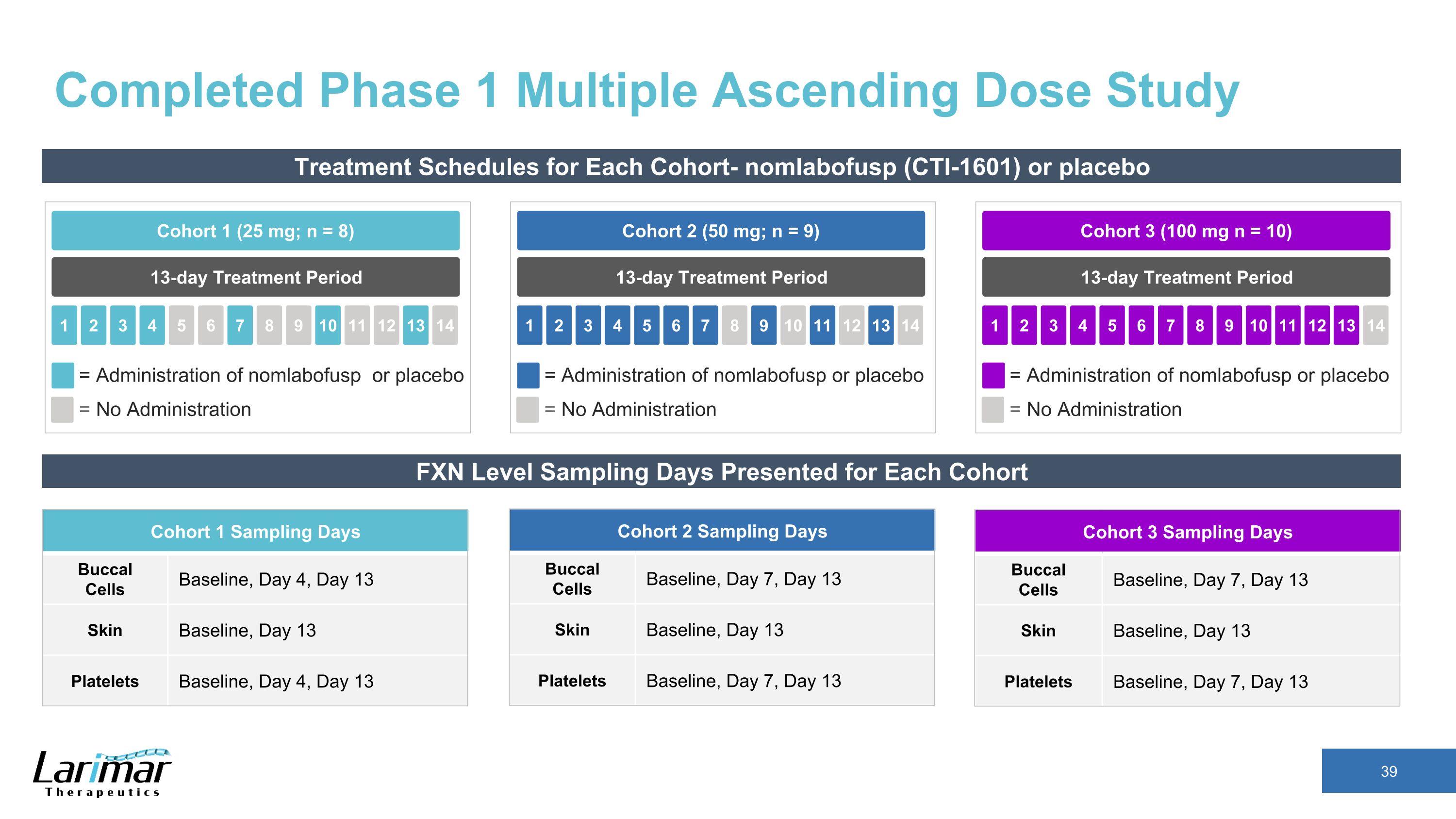
Completed Phase 1 Multiple Ascending Dose Study Treatment Schedules for Each Cohort- nomlabofusp (CTI-1601) or placebo 13-day Treatment Period Cohort 2 (50 mg; n = 9) 2 3 4 5 1 6 7 8 9 10 11 12 13 14 = Administration of nomlabofusp or placebo = No Administration 13-day Treatment Period Cohort 1 (25 mg; n = 8) 2 3 4 5 1 6 7 8 9 10 11 12 13 14 = Administration of nomlabofusp or placebo = No Administration 13-day Treatment Period Cohort 3 (100 mg n = 10) 2 3 4 5 1 6 7 8 9 10 11 12 13 14 = Administration of nomlabofusp or placebo = No Administration FXN Level Sampling Days Presented for Each Cohort Cohort 1 Sampling Days Buccal Cells Baseline, Day 4, Day 13 Skin Baseline, Day 13 Platelets Baseline, Day 4, Day 13 Cohort 2 Sampling Days Buccal Cells Baseline, Day 7, Day 13 Skin Baseline, Day 13 Platelets Baseline, Day 7, Day 13 Cohort 3 Sampling Days Buccal Cells Baseline, Day 7, Day 13 Skin Baseline, Day 13 Platelets Baseline, Day 7, Day 13
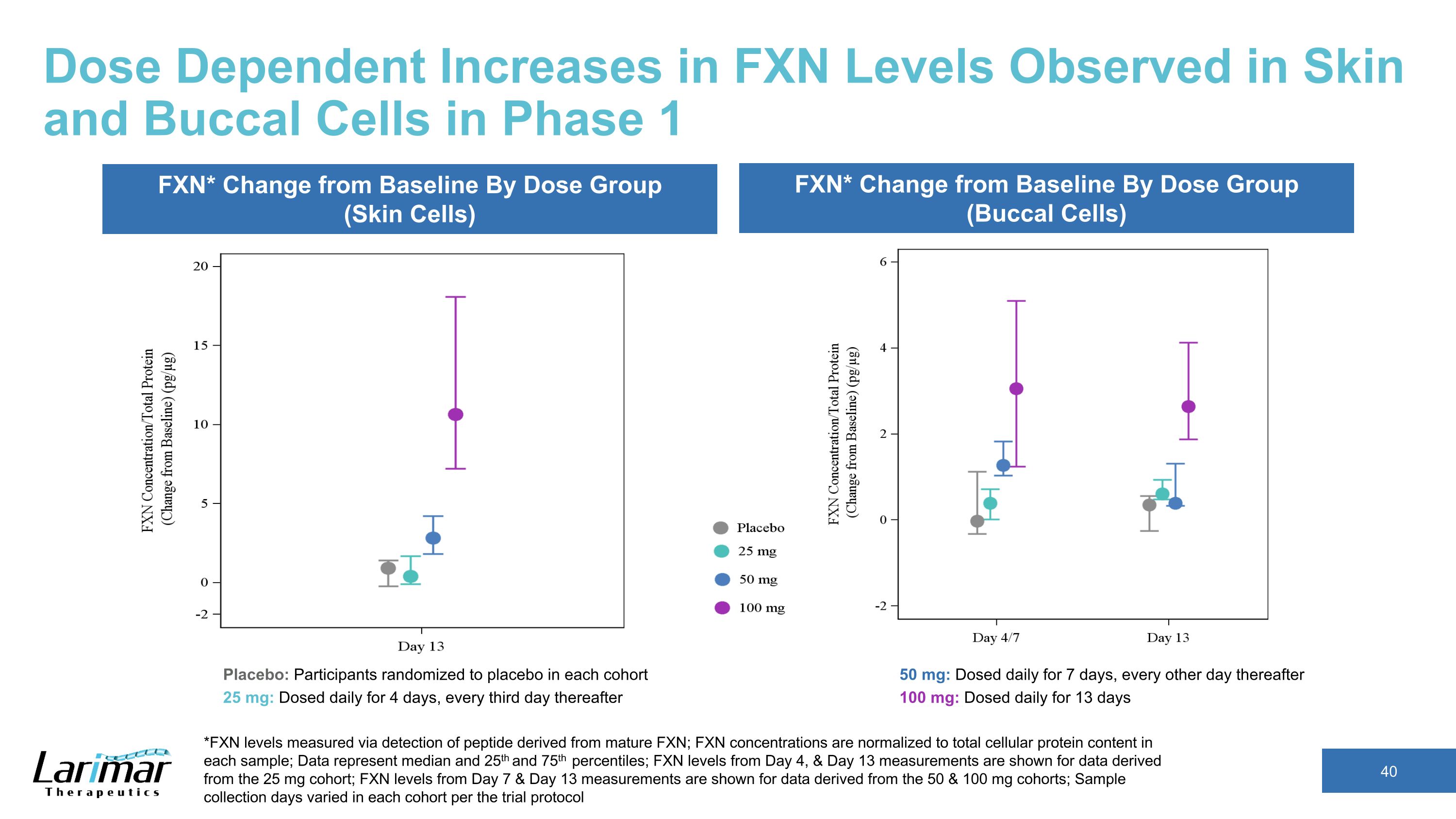
Dose Dependent Increases in FXN Levels Observed in Skin and Buccal Cells in Phase 1 *FXN levels measured via detection of peptide derived from mature FXN; FXN concentrations are normalized to total cellular protein content in each sample; Data represent median and 25th and 75th percentiles; FXN levels from Day 4, & Day 13 measurements are shown for data derived from the 25 mg cohort; FXN levels from Day 7 & Day 13 measurements are shown for data derived from the 50 & 100 mg cohorts; Sample collection days varied in each cohort per the trial protocol FXN* Change from Baseline By Dose Group (Skin Cells) FXN* Change from Baseline By Dose Group (Buccal Cells) Placebo: Participants randomized to placebo in each cohort 25 mg: Dosed daily for 4 days, every third day thereafter 50 mg: Dosed daily for 7 days, every other day thereafter 100 mg: Dosed daily for 13 days
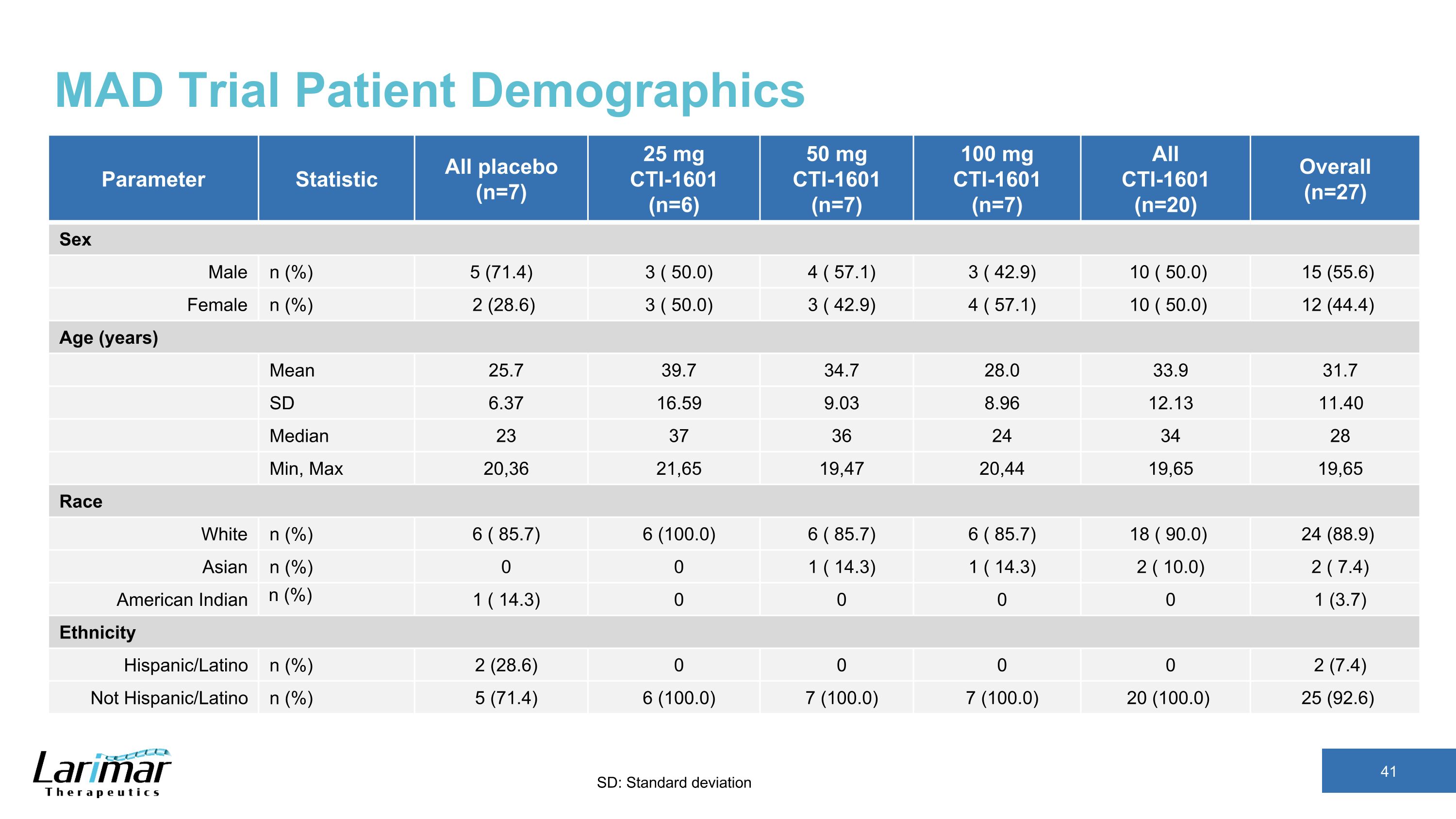
MAD Trial Patient Demographics Parameter Statistic All placebo (n=7) 25 mg CTI-1601 (n=6) 50 mg CTI-1601 (n=7) 100 mg CTI-1601 (n=7) All CTI-1601 (n=20) Overall (n=27) Sex Male n (%) 5 (71.4) 3 ( 50.0) 4 ( 57.1) 3 ( 42.9) 10 ( 50.0) 15 (55.6) Female n (%) 2 (28.6) 3 ( 50.0) 3 ( 42.9) 4 ( 57.1) 10 ( 50.0) 12 (44.4) Age (years) Mean 25.7 39.7 34.7 28.0 33.9 31.7 SD 6.37 16.59 9.03 8.96 12.13 11.40 Median 23 37 36 24 34 28 Min, Max 20,36 21,65 19,47 20,44 19,65 19,65 Race White n (%) 6 ( 85.7) 6 (100.0) 6 ( 85.7) 6 ( 85.7) 18 ( 90.0) 24 (88.9) Asian n (%) 0 0 1 ( 14.3) 1 ( 14.3) 2 ( 10.0) 2 ( 7.4) American Indian n (%) 1 ( 14.3) 0 0 0 0 1 (3.7) Ethnicity Hispanic/Latino n (%) 2 (28.6) 0 0 0 0 2 (7.4) Not Hispanic/Latino n (%) 5 (71.4) 6 (100.0) 7 (100.0) 7 (100.0) 20 (100.0) 25 (92.6) SD: Standard deviation
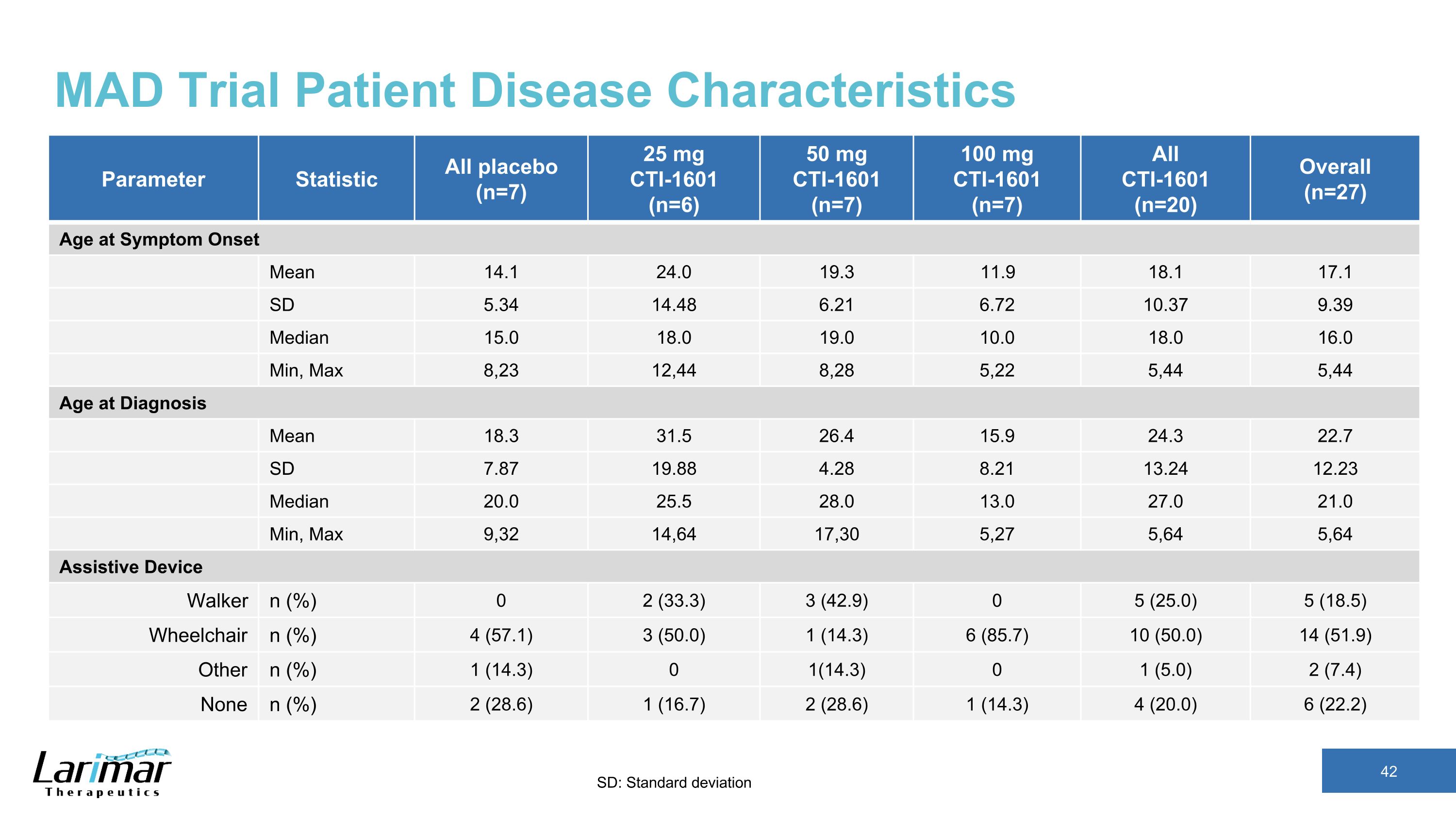
MAD Trial Patient Disease Characteristics Parameter Statistic All placebo (n=7) 25 mg CTI-1601 (n=6) 50 mg CTI-1601 (n=7) 100 mg CTI-1601 (n=7) All CTI-1601 (n=20) Overall (n=27) Age at Symptom Onset Mean 14.1 24.0 19.3 11.9 18.1 17.1 SD 5.34 14.48 6.21 6.72 10.37 9.39 Median 15.0 18.0 19.0 10.0 18.0 16.0 Min, Max 8,23 12,44 8,28 5,22 5,44 5,44 Age at Diagnosis Mean 18.3 31.5 26.4 15.9 24.3 22.7 SD 7.87 19.88 4.28 8.21 13.24 12.23 Median 20.0 25.5 28.0 13.0 27.0 21.0 Min, Max 9,32 14,64 17,30 5,27 5,64 5,64 Assistive Device Walker n (%) 0 2 (33.3) 3 (42.9) 0 5 (25.0) 5 (18.5) Wheelchair n (%) 4 (57.1) 3 (50.0) 1 (14.3) 6 (85.7) 10 (50.0) 14 (51.9) Other n (%) 1 (14.3) 0 1(14.3) 0 1 (5.0) 2 (7.4) None n (%) 2 (28.6) 1 (16.7) 2 (28.6) 1 (14.3) 4 (20.0) 6 (22.2) SD: Standard deviation
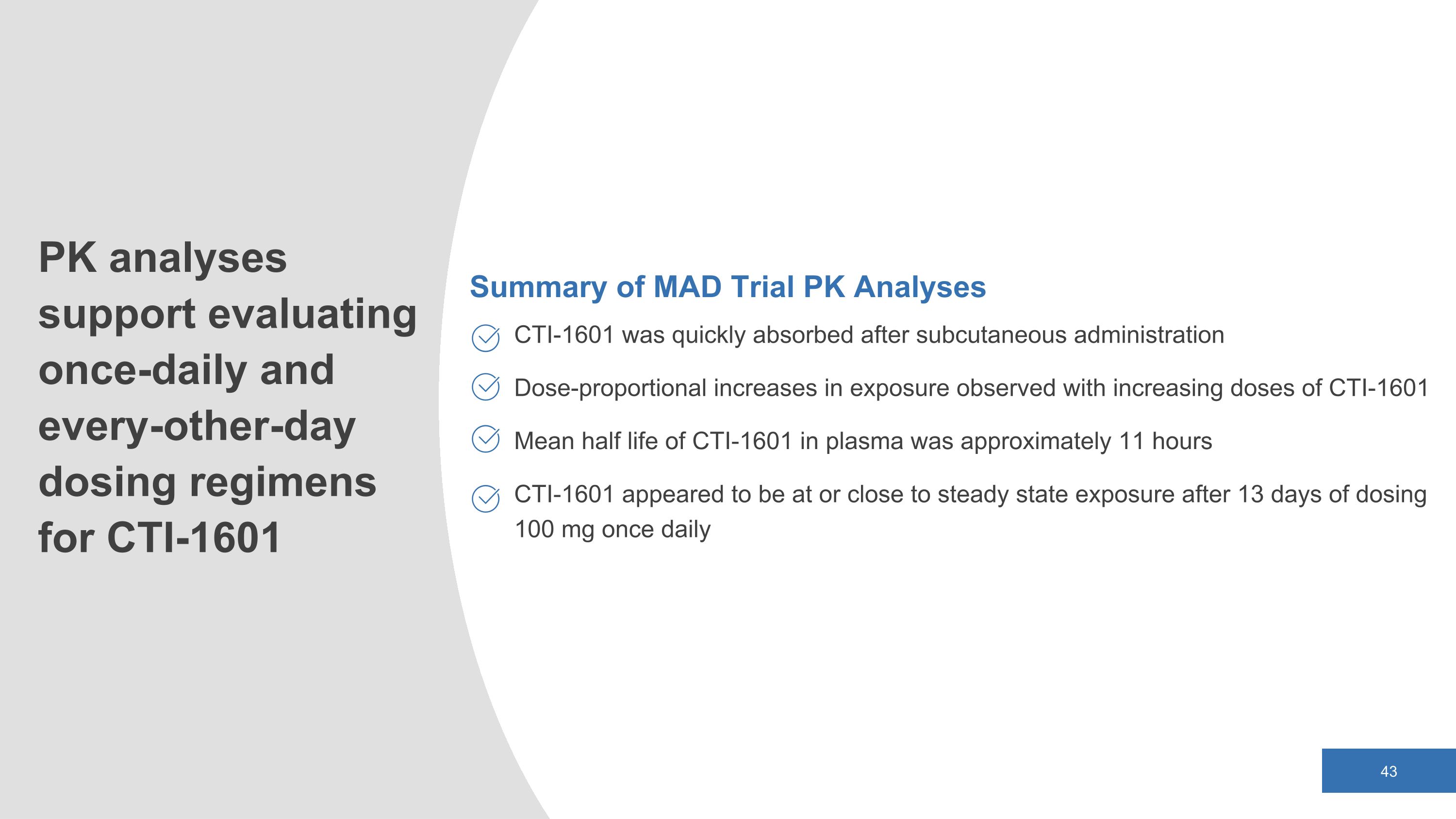
Summary of MAD Trial PK Analyses CTI-1601 was quickly absorbed after subcutaneous administration Dose-proportional increases in exposure observed with increasing doses of CTI-1601 Mean half life of CTI-1601 in plasma was approximately 11 hours CTI-1601 appeared to be at or close to steady state exposure after 13 days of dosing 100 mg once daily PK analyses support evaluating once-daily and every-other-day dosing regimens for CTI-1601
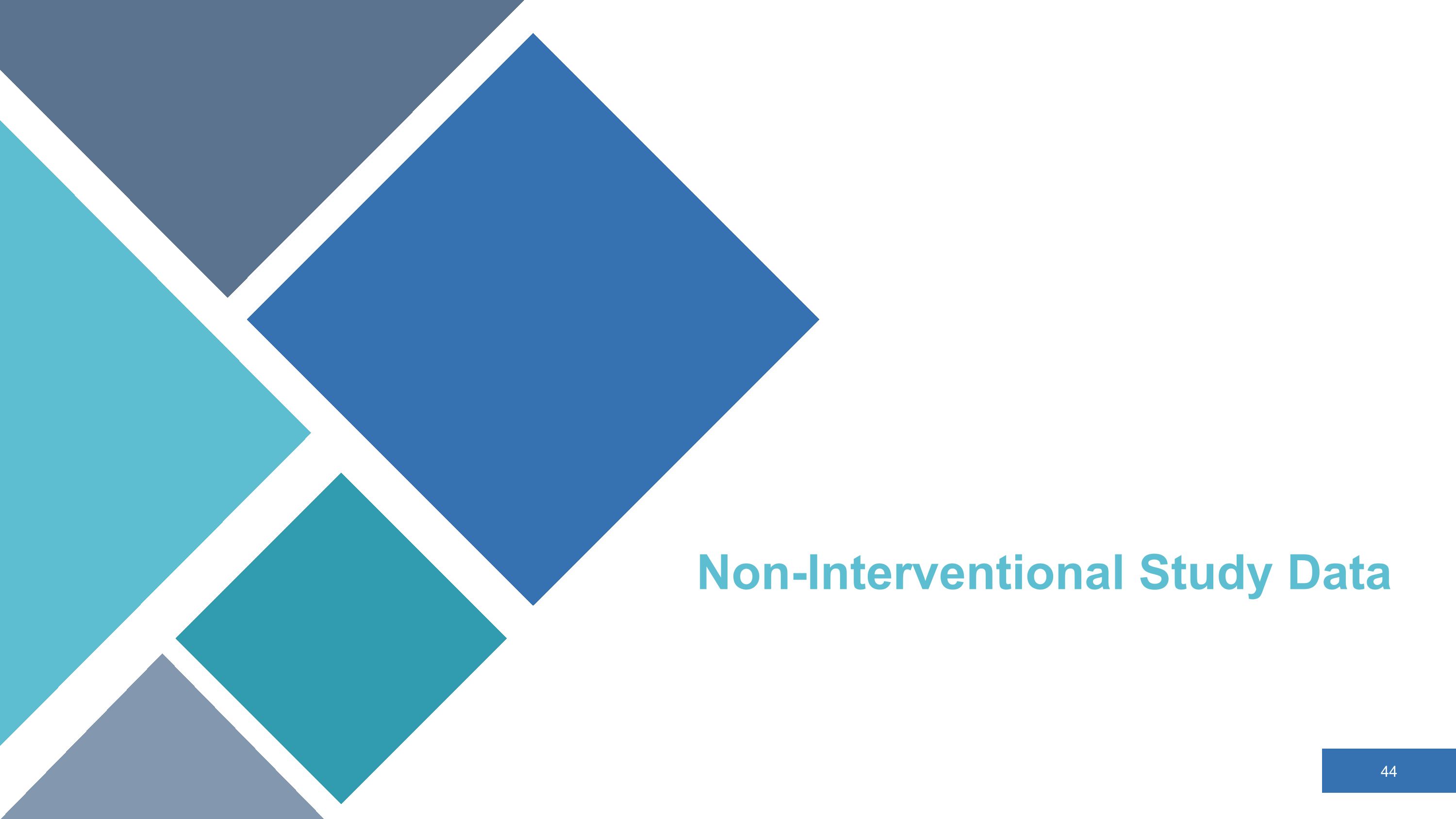
Non-Interventional Study Data
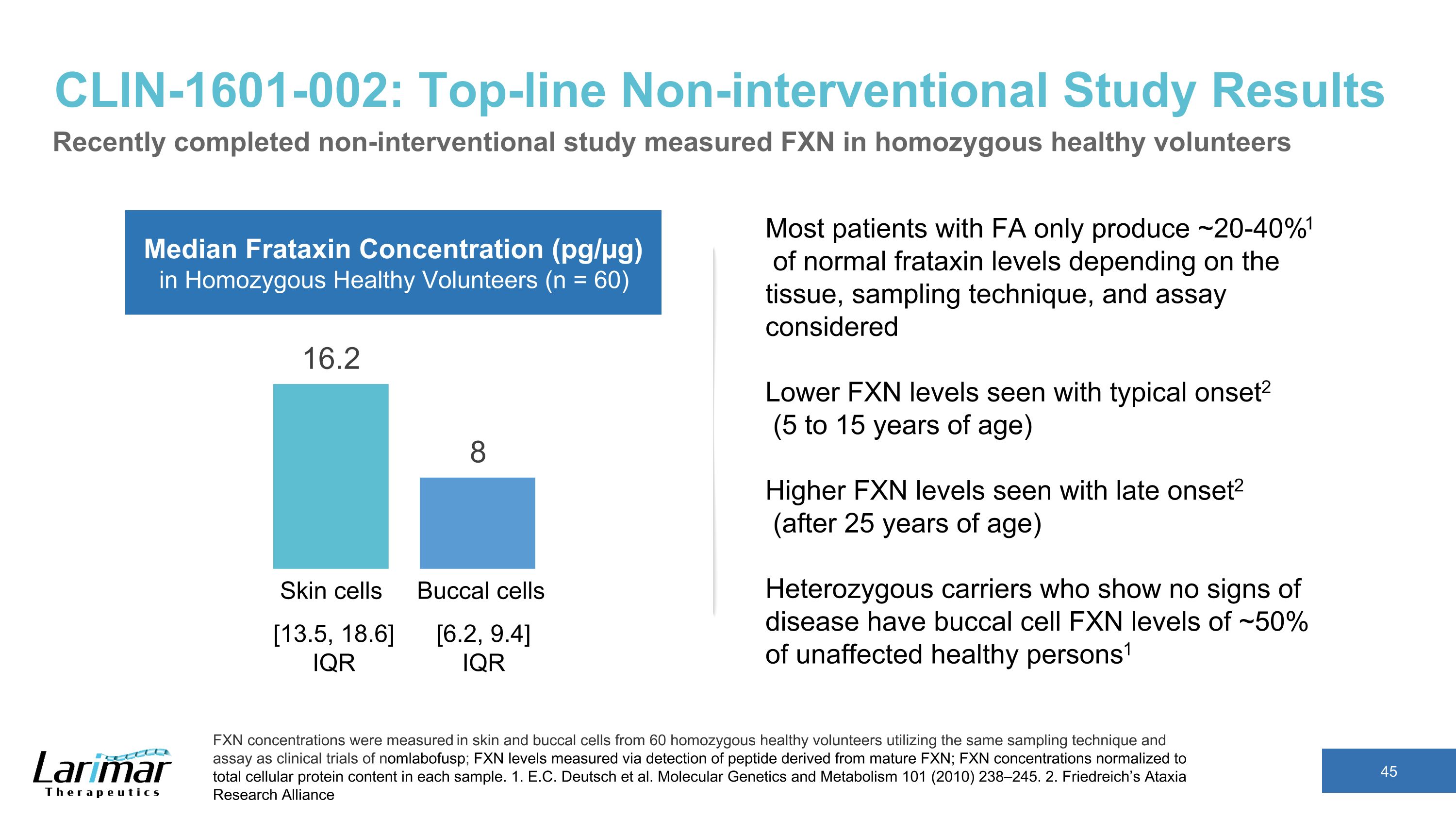
CLIN-1601-002: Top-line Non-interventional Study Results Recently completed non-interventional study measured FXN in homozygous healthy volunteers FXN concentrations were measured in skin and buccal cells from 60 homozygous healthy volunteers utilizing the same sampling technique and assay as clinical trials of nomlabofusp; FXN levels measured via detection of peptide derived from mature FXN; FXN concentrations normalized to total cellular protein content in each sample. 1. E.C. Deutsch et al. Molecular Genetics and Metabolism 101 (2010) 238–245. 2. Friedreich’s Ataxia Research Alliance Skin cells Buccal cells Median Frataxin Concentration (pg/µg) in Homozygous Healthy Volunteers (n = 60) Most patients with FA only produce ~20-40%1 of normal frataxin levels depending on the tissue, sampling technique, and assay considered Lower FXN levels seen with typical onset2 (5 to 15 years of age) Higher FXN levels seen with late onset2 (after 25 years of age) Heterozygous carriers who show no signs of disease have buccal cell FXN levels of ~50% of unaffected healthy persons1 [13.5, 18.6] IQR [6.2, 9.4] IQR
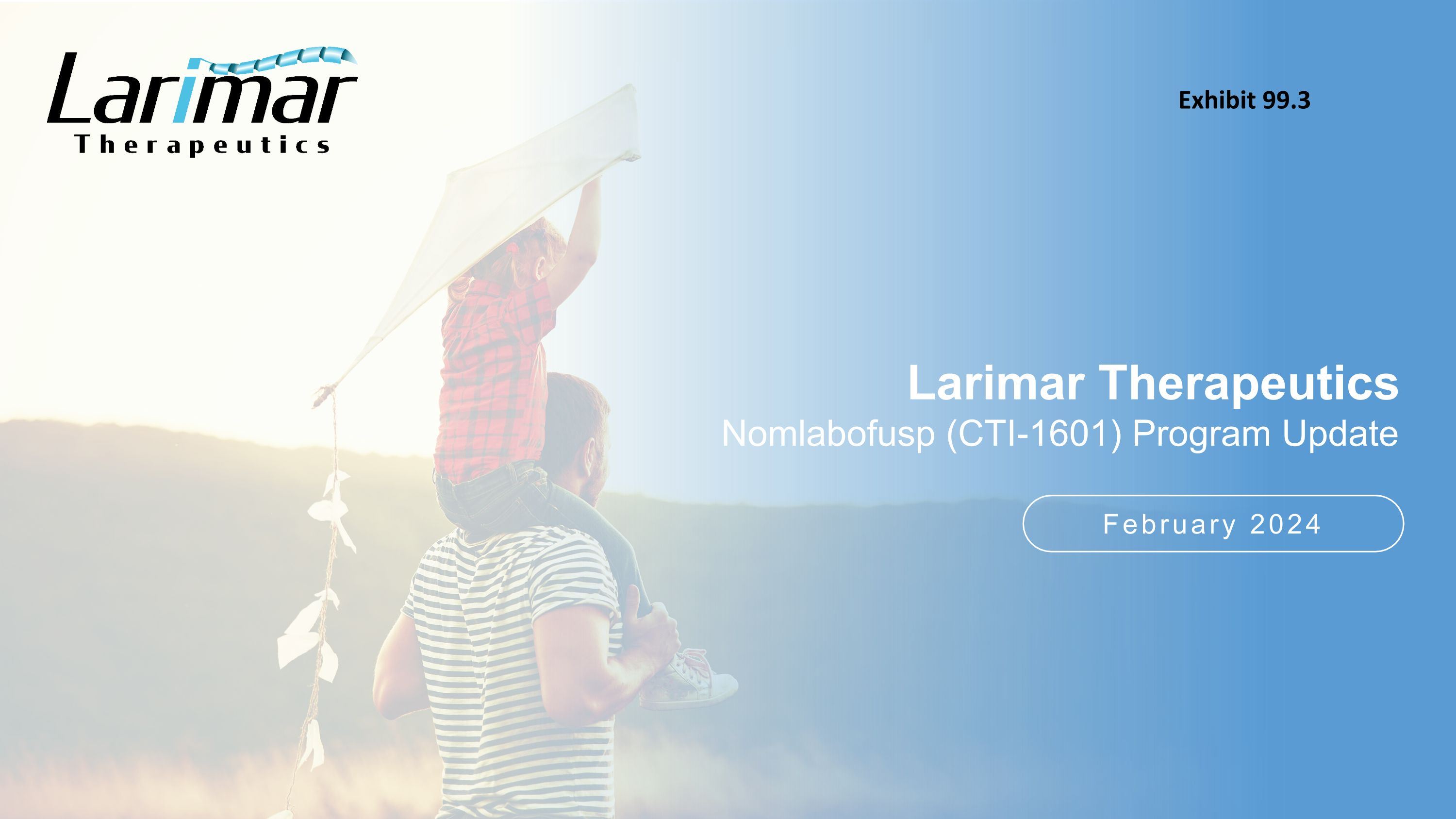
February 2024 Larimar Therapeutics Nomlabofusp (CTI-1601) Program Update Exhibit 99.3
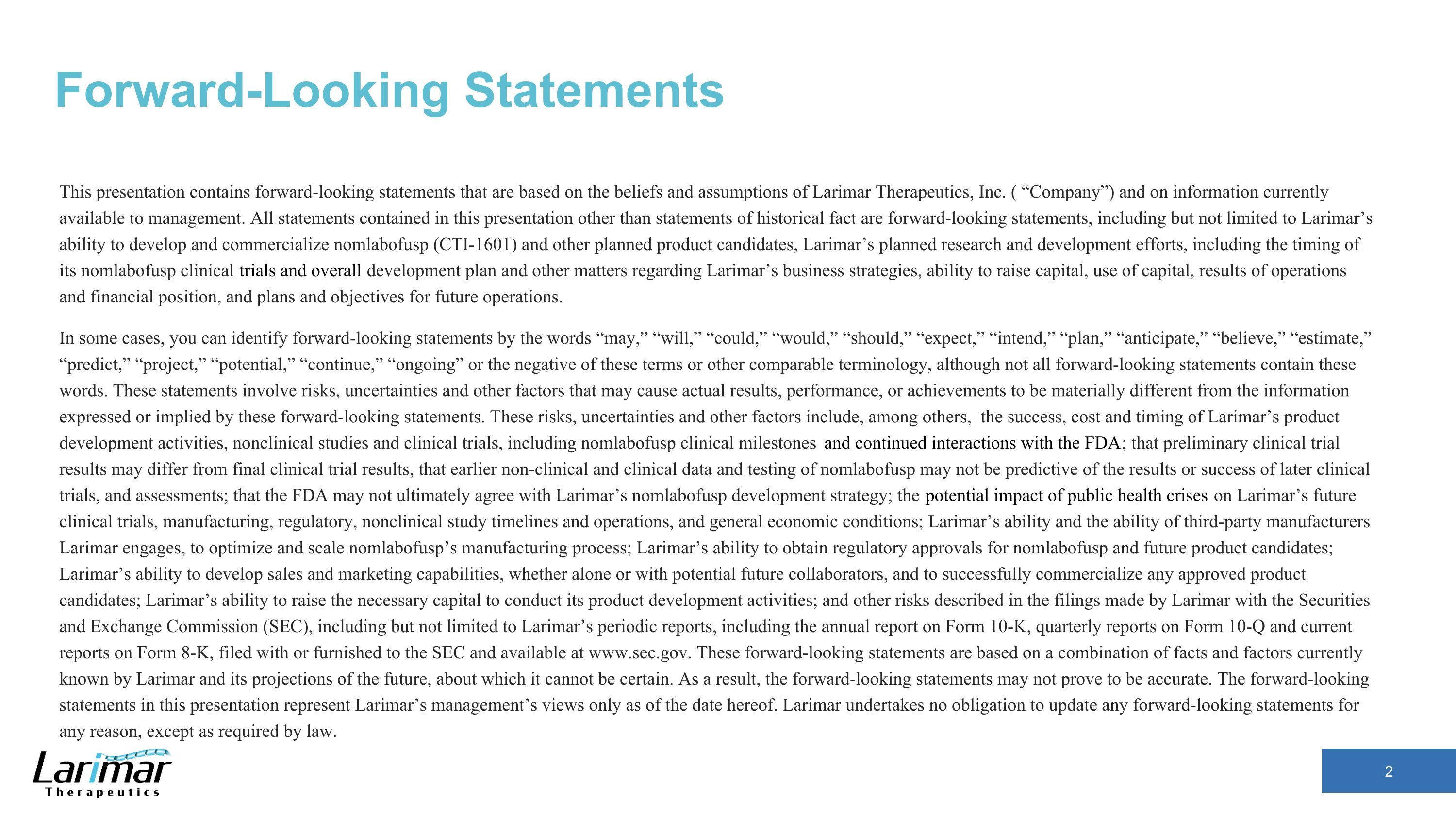
This presentation contains forward-looking statements that are based on the beliefs and assumptions of Larimar Therapeutics, Inc. ( “Company”) and on information currently available to management. All statements contained in this presentation other than statements of historical fact are forward-looking statements, including but not limited to Larimar’s ability to develop and commercialize nomlabofusp (CTI-1601) and other planned product candidates, Larimar’s planned research and development efforts, including the timing of its nomlabofusp clinical trials and overall development plan and other matters regarding Larimar’s business strategies, ability to raise capital, use of capital, results of operations and financial position, and plans and objectives for future operations. In some cases, you can identify forward-looking statements by the words “may,” “will,” “could,” “would,” “should,” “expect,” “intend,” “plan,” “anticipate,” “believe,” “estimate,” “predict,” “project,” “potential,” “continue,” “ongoing” or the negative of these terms or other comparable terminology, although not all forward-looking statements contain these words. These statements involve risks, uncertainties and other factors that may cause actual results, performance, or achievements to be materially different from the information expressed or implied by these forward-looking statements. These risks, uncertainties and other factors include, among others, the success, cost and timing of Larimar’s product development activities, nonclinical studies and clinical trials, including nomlabofusp clinical milestones and continued interactions with the FDA; that preliminary clinical trial results may differ from final clinical trial results, that earlier non-clinical and clinical data and testing of nomlabofusp may not be predictive of the results or success of later clinical trials, and assessments; that the FDA may not ultimately agree with Larimar’s nomlabofusp development strategy; the potential impact of public health crises on Larimar’s future clinical trials, manufacturing, regulatory, nonclinical study timelines and operations, and general economic conditions; Larimar’s ability and the ability of third-party manufacturers Larimar engages, to optimize and scale nomlabofusp’s manufacturing process; Larimar’s ability to obtain regulatory approvals for nomlabofusp and future product candidates; Larimar’s ability to develop sales and marketing capabilities, whether alone or with potential future collaborators, and to successfully commercialize any approved product candidates; Larimar’s ability to raise the necessary capital to conduct its product development activities; and other risks described in the filings made by Larimar with the Securities and Exchange Commission (SEC), including but not limited to Larimar’s periodic reports, including the annual report on Form 10-K, quarterly reports on Form 10-Q and current reports on Form 8-K, filed with or furnished to the SEC and available at www.sec.gov. These forward-looking statements are based on a combination of facts and factors currently known by Larimar and its projections of the future, about which it cannot be certain. As a result, the forward-looking statements may not prove to be accurate. The forward-looking statements in this presentation represent Larimar’s management’s views only as of the date hereof. Larimar undertakes no obligation to update any forward-looking statements for any reason, except as required by law. Forward-Looking Statements
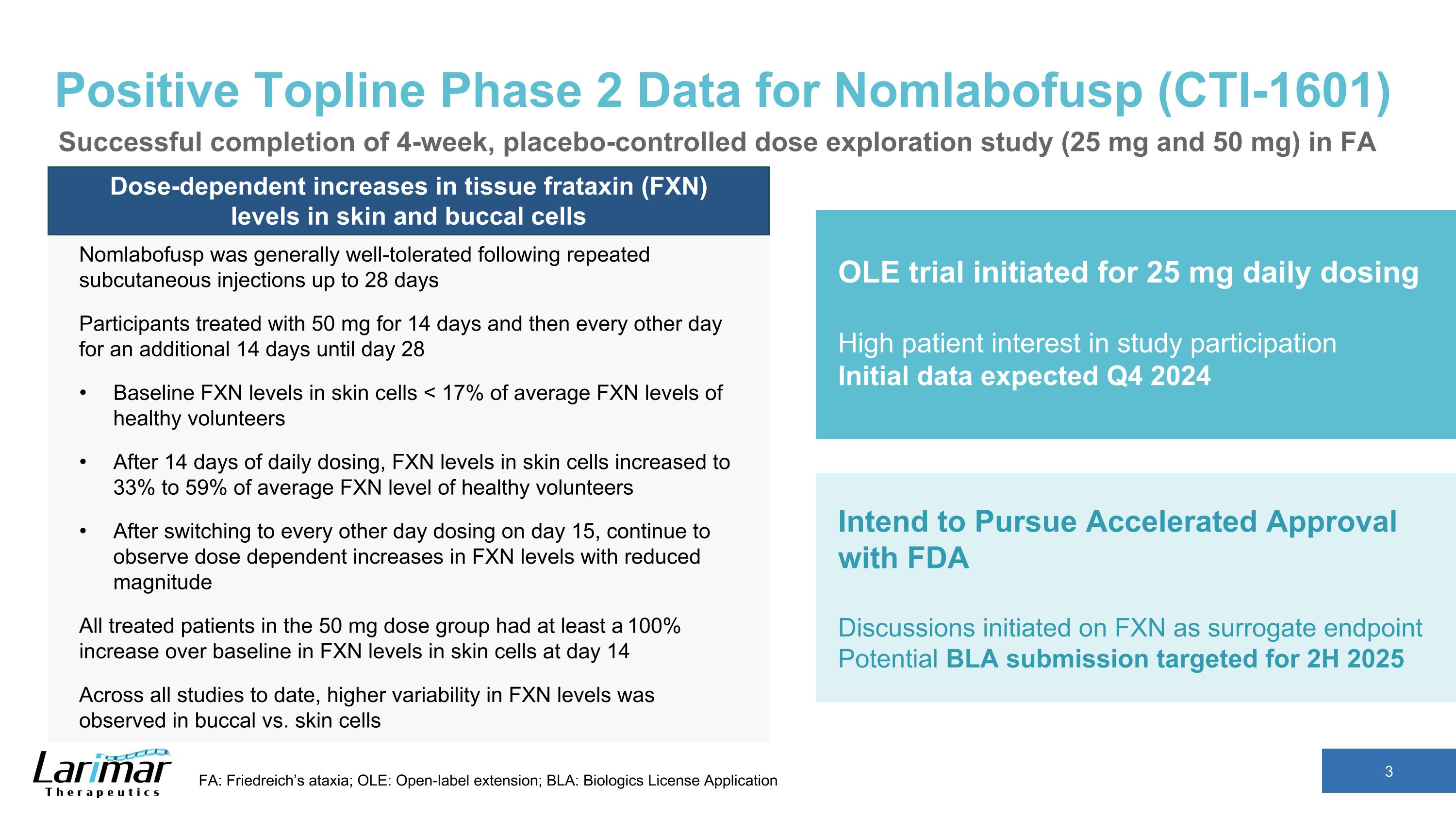
Positive Topline Phase 2 Data for Nomlabofusp (CTI-1601) Dose-dependent increases in tissue frataxin (FXN) levels in skin and buccal cells Nomlabofusp was generally well-tolerated following repeated subcutaneous injections up to 28 days Participants treated with 50 mg for 14 days and then every other day for an additional 14 days until day 28 Baseline FXN levels in skin cells < 17% of average FXN levels of healthy volunteers After 14 days of daily dosing, FXN levels in skin cells increased to 33% to 59% of average FXN level of healthy volunteers After switching to every other day dosing on day 15, continue to observe dose dependent increases in FXN levels with reduced magnitude All treated patients in the 50 mg dose group had at least a 100% increase over baseline in FXN levels in skin cells at day 14 Across all studies to date, higher variability in FXN levels was observed in buccal vs. skin cells FA: Friedreich’s ataxia; OLE: Open-label extension; BLA: Biologics License Application OLE trial initiated for 25 mg daily dosing High patient interest in study participation Initial data expected Q4 2024 Intend to Pursue Accelerated Approval with FDA Discussions initiated on FXN as surrogate endpoint Potential BLA submission targeted for 2H 2025 Successful completion of 4-week, placebo-controlled dose exploration study (25 mg and 50 mg) in FA
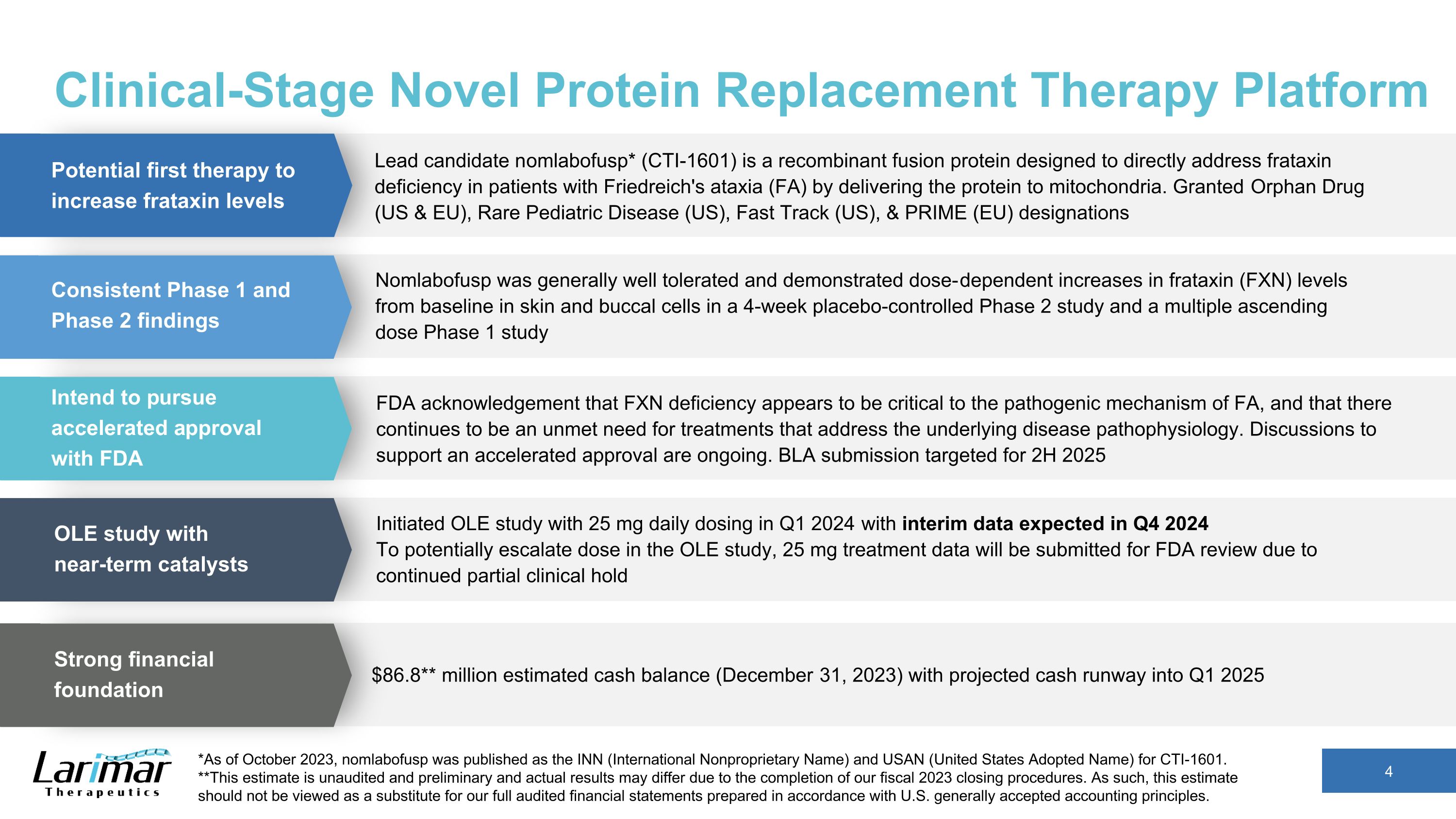
Clinical-Stage Novel Protein Replacement Therapy Platform Lead candidate nomlabofusp* (CTI-1601) is a recombinant fusion protein designed to directly address frataxin deficiency in patients with Friedreich's ataxia (FA) by delivering the protein to mitochondria. Granted Orphan Drug (US & EU), Rare Pediatric Disease (US), Fast Track (US), & PRIME (EU) designations Nomlabofusp was generally well tolerated and demonstrated dose-dependent increases in frataxin (FXN) levels from baseline in skin and buccal cells in a 4-week placebo-controlled Phase 2 study and a multiple ascending dose Phase 1 study Initiated OLE study with 25 mg daily dosing in Q1 2024 with interim data expected in Q4 2024 To potentially escalate dose in the OLE study, 25 mg treatment data will be submitted for FDA review due to continued partial clinical hold $86.8** million estimated cash balance (December 31, 2023) with projected cash runway into Q1 2025 Potential first therapy to increase frataxin levels Consistent Phase 1 and Phase 2 findings Intend to pursue accelerated approval with FDA OLE study with near-term catalysts Strong financial foundation *As of October 2023, nomlabofusp was published as the INN (International Nonproprietary Name) and USAN (United States Adopted Name) for CTI-1601. **This estimate is unaudited and preliminary and actual results may differ due to the completion of our fiscal 2023 closing procedures. As such, this estimate should not be viewed as a substitute for our full audited financial statements prepared in accordance with U.S. generally accepted accounting principles. FDA acknowledgement that FXN deficiency appears to be critical to the pathogenic mechanism of FA, and that there continues to be an unmet need for treatments that address the underlying disease pathophysiology. Discussions to support an accelerated approval are ongoing. BLA submission targeted for 2H 2025
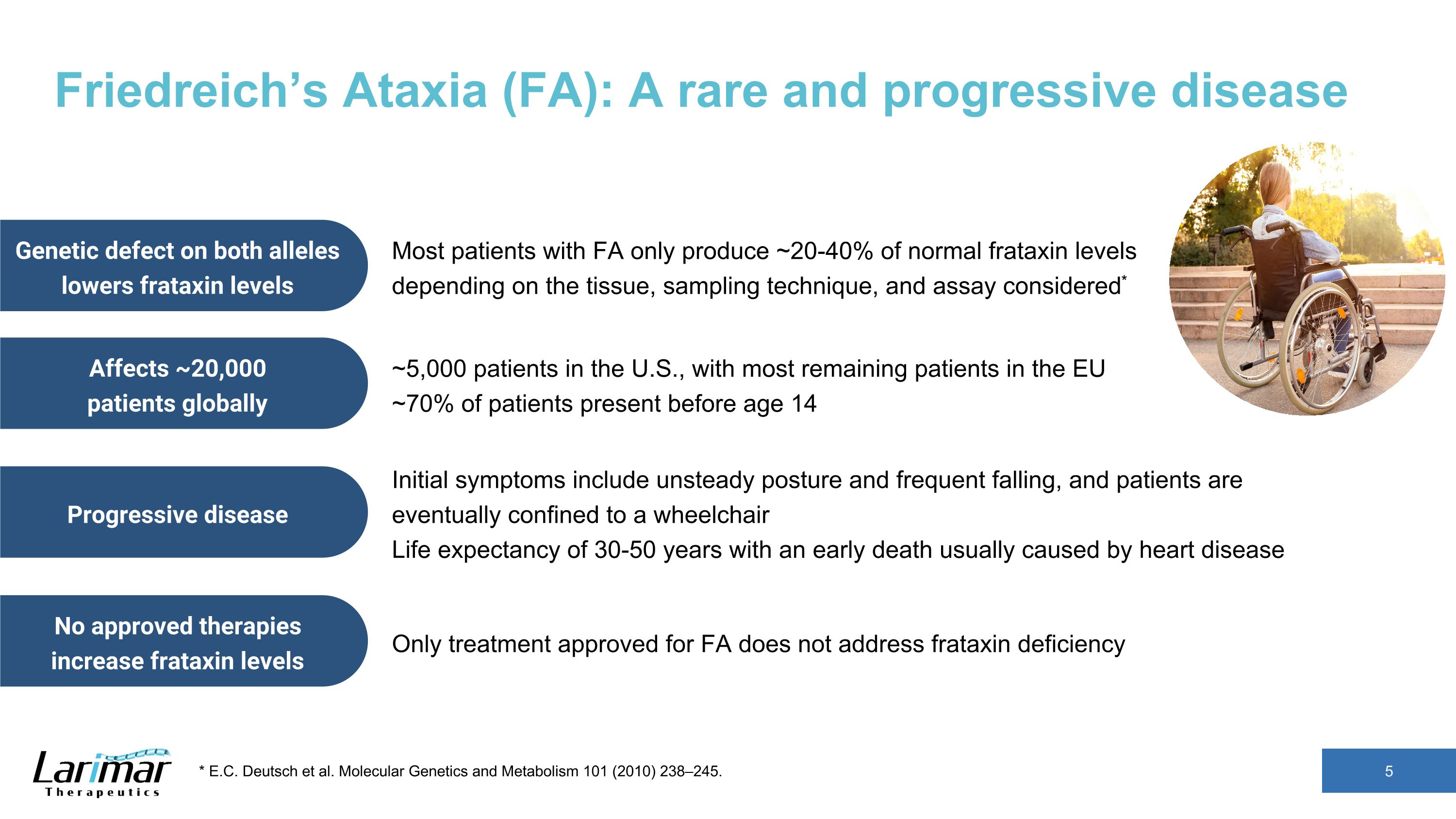
Friedreich’s Ataxia (FA): A rare and progressive disease 5 * E.C. Deutsch et al. Molecular Genetics and Metabolism 101 (2010) 238–245. Most patients with FA only produce ~20-40% of normal frataxin levels depending on the tissue, sampling technique, and assay considered* Genetic defect on both alleles lowers frataxin levels Progressive disease Initial symptoms include unsteady posture and frequent falling, and patients are eventually confined to a wheelchair�Life expectancy of 30-50 years with an early death usually caused by heart disease Affects ~20,000 patients globally ~5,000 patients in the U.S., with most remaining patients in the EU�~70% of patients present before age 14 No approved therapies increase frataxin levels Only treatment approved for FA does not address frataxin deficiency
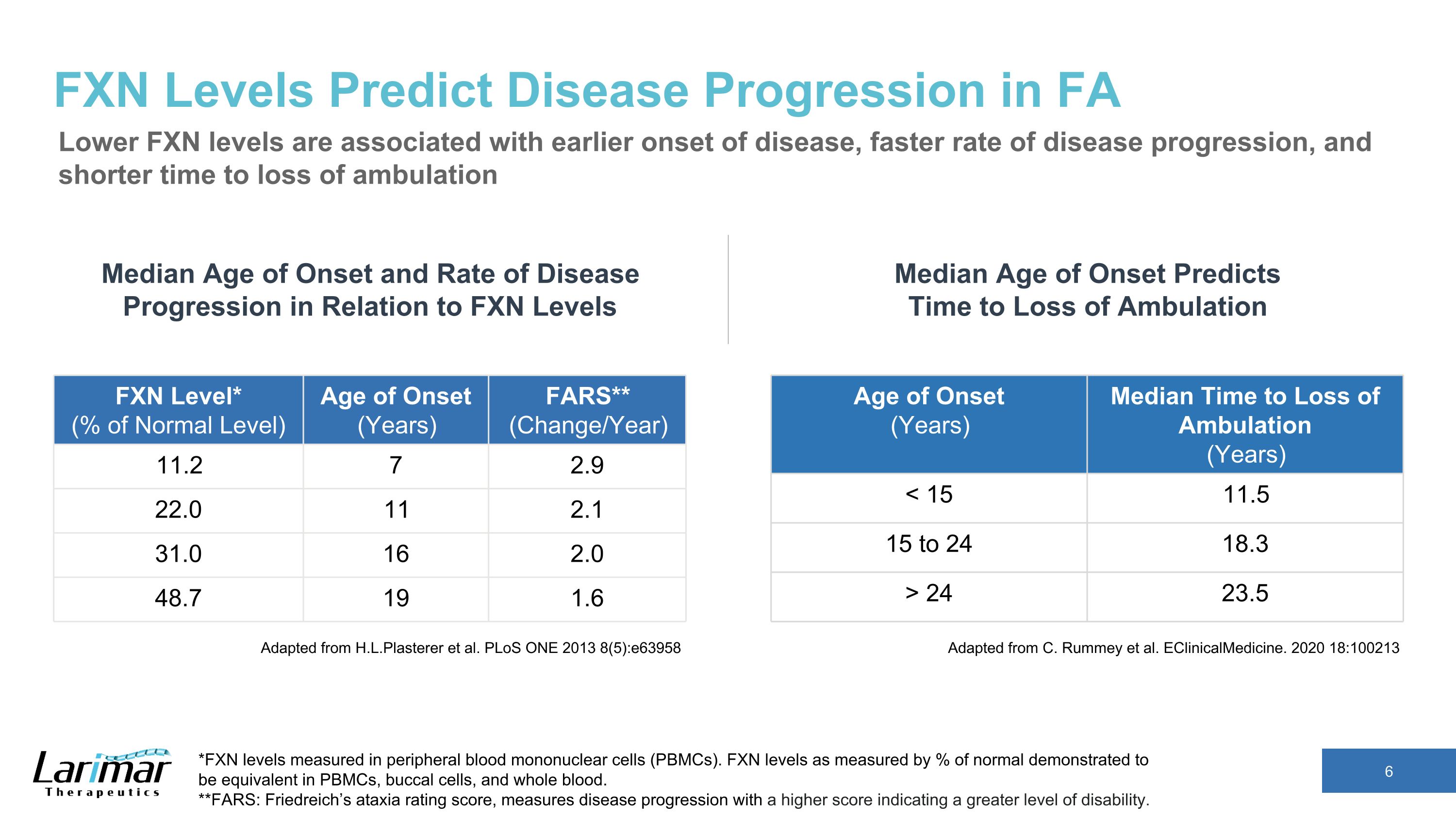
FXN Levels Predict Disease Progression in FA Lower FXN levels are associated with earlier onset of disease, faster rate of disease progression, and shorter time to loss of ambulation Adapted from H.L.Plasterer et al. PLoS ONE 2013 8(5):e63958 Age of Onset (Years) Median Time to Loss of Ambulation (Years) < 15 11.5 15 to 24 18.3 > 24 23.5 Median Age of Onset and Rate of Disease Progression in Relation to FXN Levels *FXN levels measured in peripheral blood mononuclear cells (PBMCs). FXN levels as measured by % of normal demonstrated to be equivalent in PBMCs, buccal cells, and whole blood. **FARS: Friedreich’s ataxia rating score, measures disease progression with a higher score indicating a greater level of disability. FXN Level* (% of Normal Level) Age of Onset (Years) FARS** (Change/Year) 11.2 7 2.9 22.0 11 2.1 31.0 16 2.0 48.7 19 1.6 Adapted from C. Rummey et al. EClinicalMedicine. 2020 18:100213 Median Age of Onset Predicts Time to Loss of Ambulation
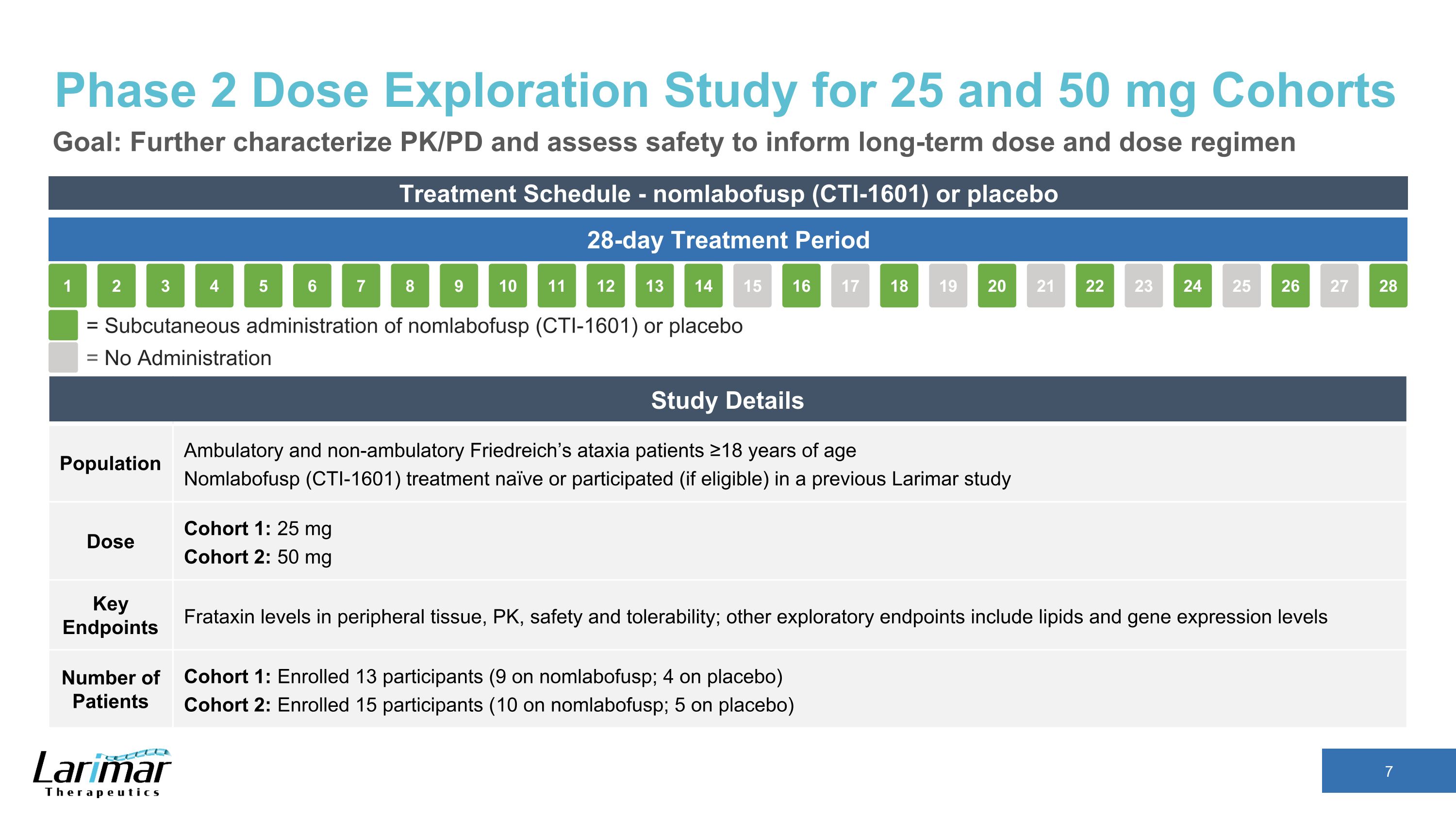
Phase 2 Dose Exploration Study for 25 and 50 mg Cohorts Goal: Further characterize PK/PD and assess safety to inform long-term dose and dose regimen Treatment Schedule - nomlabofusp (CTI-1601) or placebo 28-day Treatment Period 16 17 18 19 15 20 21 22 23 24 25 26 27 28 2 3 4 5 1 6 7 8 9 10 11 12 13 14 = Subcutaneous administration of nomlabofusp (CTI-1601) or placebo = No Administration Study Details Population Ambulatory and non-ambulatory Friedreich’s ataxia patients ≥18 years of age Nomlabofusp (CTI-1601) treatment naïve or participated (if eligible) in a previous Larimar study Dose Cohort 1: 25 mg Cohort 2: 50 mg Key Endpoints Frataxin levels in peripheral tissue, PK, safety and tolerability; other exploratory endpoints include lipids and gene expression levels Number of Patients Cohort 1: Enrolled 13 participants (9 on nomlabofusp; 4 on placebo) Cohort 2: Enrolled 15 participants (10 on nomlabofusp; 5 on placebo)
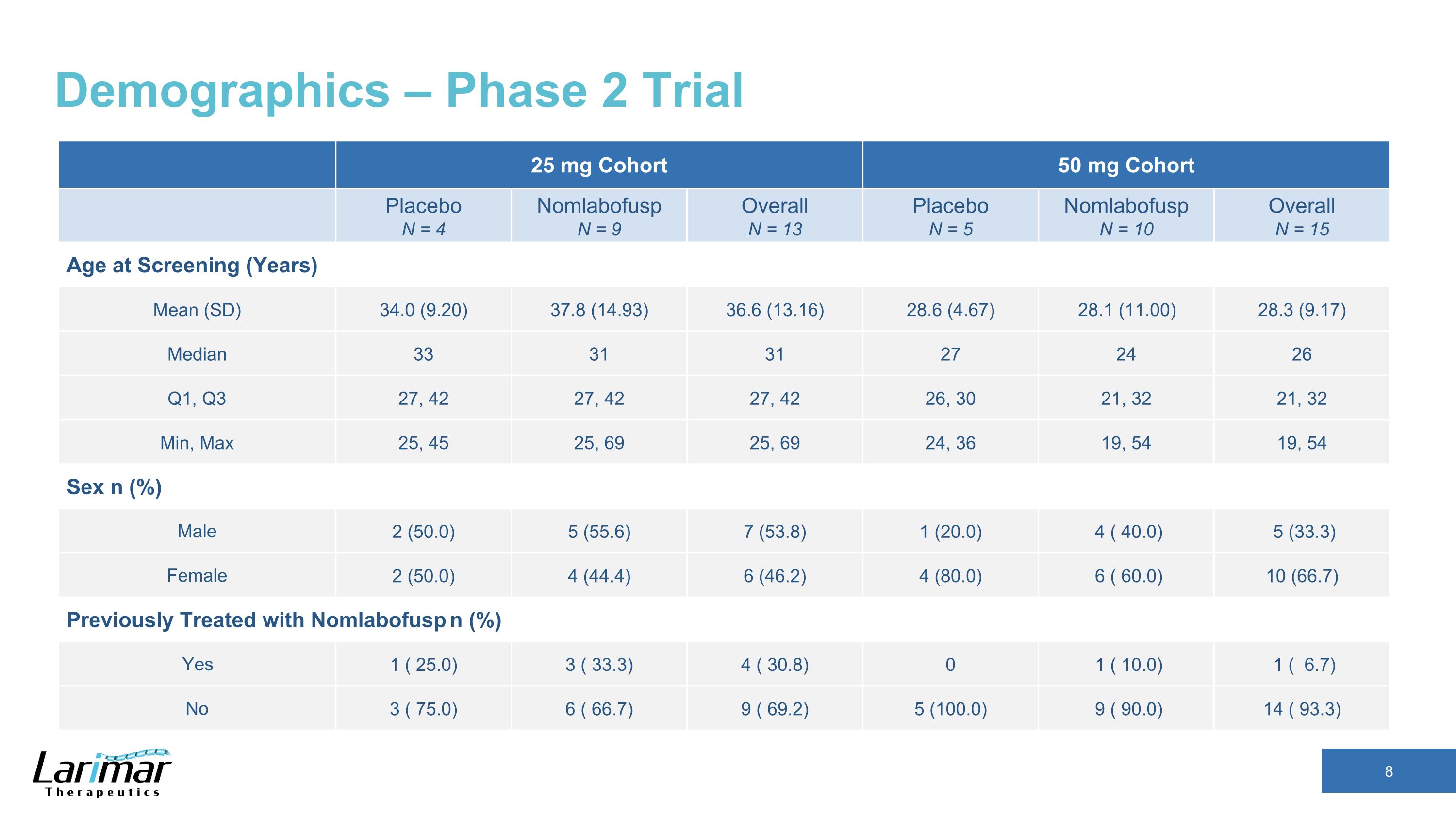
Demographics – Phase 2 Trial 25 mg Cohort 50 mg Cohort Placebo N = 4 Nomlabofusp N = 9 Overall N = 13 Placebo N = 5 Nomlabofusp N = 10 Overall N = 15 Age at Screening (Years) Mean (SD) 34.0 (9.20) 37.8 (14.93) 36.6 (13.16) 28.6 (4.67) 28.1 (11.00) 28.3 (9.17) Median 33 31 31 27 24 26 Q1, Q3 27, 42 27, 42 27, 42 26, 30 21, 32 21, 32 Min, Max 25, 45 25, 69 25, 69 24, 36 19, 54 19, 54 Sex n (%) Male 2 (50.0) 5 (55.6) 7 (53.8) 1 (20.0) 4 ( 40.0) 5 (33.3) Female 2 (50.0) 4 (44.4) 6 (46.2) 4 (80.0) 6 ( 60.0) 10 (66.7) Previously Treated with Nomlabofusp n (%) Yes 1 ( 25.0) 3 ( 33.3) 4 ( 30.8) 0 1 ( 10.0) 1 ( 6.7) No 3 ( 75.0) 6 ( 66.7) 9 ( 69.2) 5 (100.0) 9 ( 90.0) 14 ( 93.3)
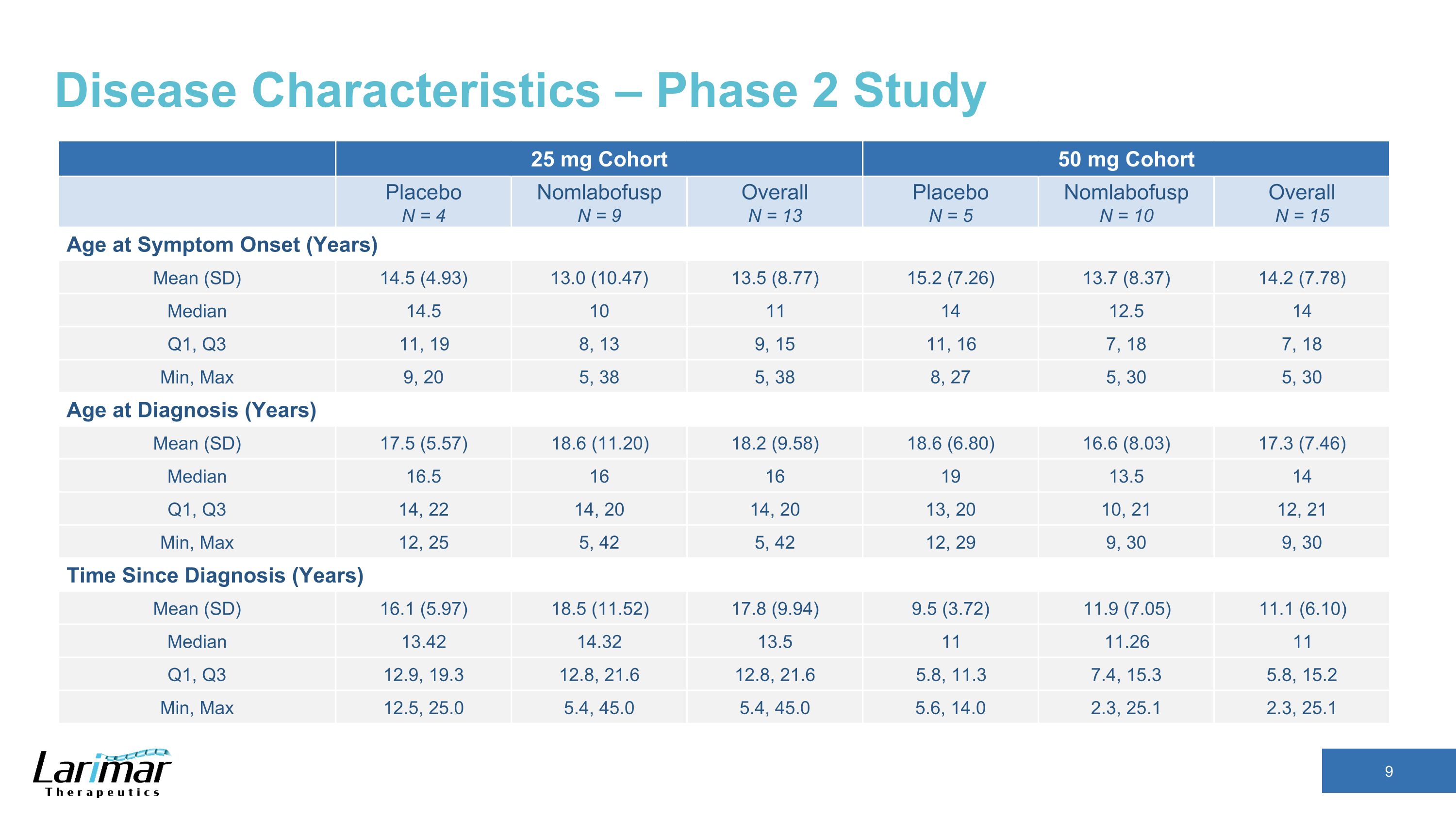
Disease Characteristics – Phase 2 Study 25 mg Cohort 50 mg Cohort Placebo N = 4 Nomlabofusp N = 9 Overall N = 13 Placebo N = 5 Nomlabofusp N = 10 Overall N = 15 Age at Symptom Onset (Years) Mean (SD) 14.5 (4.93) 13.0 (10.47) 13.5 (8.77) 15.2 (7.26) 13.7 (8.37) 14.2 (7.78) Median 14.5 10 11 14 12.5 14 Q1, Q3 11, 19 8, 13 9, 15 11, 16 7, 18 7, 18 Min, Max 9, 20 5, 38 5, 38 8, 27 5, 30 5, 30 Age at Diagnosis (Years) Mean (SD) 17.5 (5.57) 18.6 (11.20) 18.2 (9.58) 18.6 (6.80) 16.6 (8.03) 17.3 (7.46) Median 16.5 16 16 19 13.5 14 Q1, Q3 14, 22 14, 20 14, 20 13, 20 10, 21 12, 21 Min, Max 12, 25 5, 42 5, 42 12, 29 9, 30 9, 30 Time Since Diagnosis (Years) Mean (SD) 16.1 (5.97) 18.5 (11.52) 17.8 (9.94) 9.5 (3.72) 11.9 (7.05) 11.1 (6.10) Median 13.42 14.32 13.5 11 11.26 11 Q1, Q3 12.9, 19.3 12.8, 21.6 12.8, 21.6 5.8, 11.3 7.4, 15.3 5.8, 15.2 Min, Max 12.5, 25.0 5.4, 45.0 5.4, 45.0 5.6, 14.0 2.3, 25.1 2.3, 25.1
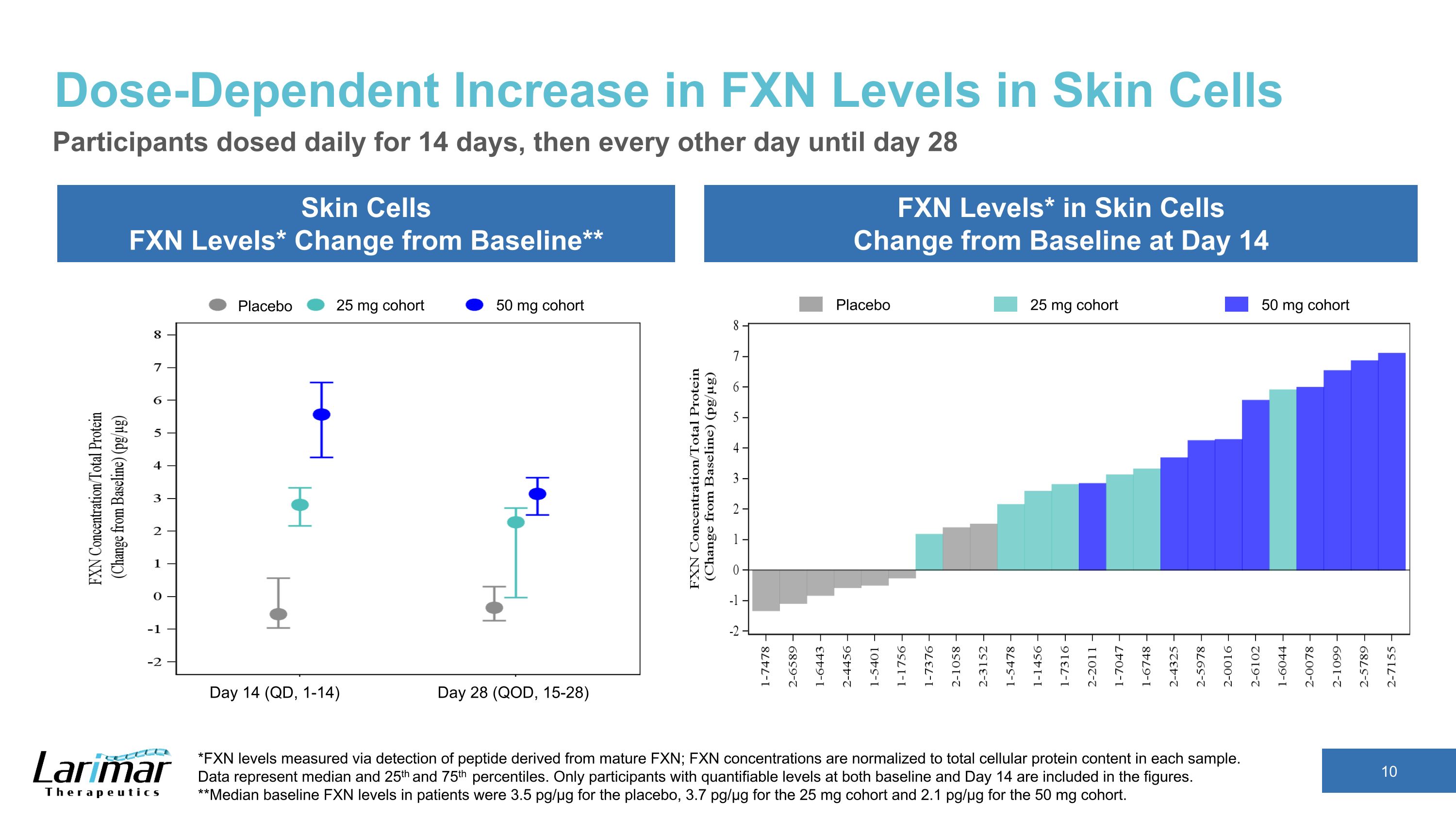
Dose-Dependent Increase in FXN Levels in Skin Cells Skin Cells FXN Levels* Change from Baseline** FXN Levels* in Skin Cells Change from Baseline at Day 14 Participants dosed daily for 14 days, then every other day until day 28 *FXN levels measured via detection of peptide derived from mature FXN; FXN concentrations are normalized to total cellular protein content in each sample.�Data represent median and 25th and 75th percentiles. Only participants with quantifiable levels at both baseline and Day 14 are included in the figures. **Median baseline FXN levels in patients were 3.5 pg/µg for the placebo, 3.7 pg/µg for the 25 mg cohort and 2.1 pg/µg for the 50 mg cohort. Placebo 25 mg cohort 50 mg cohort Placebo 25 mg cohort 50 mg cohort Day 14 (QD, 1-14) Day 28 (QOD, 15-28)
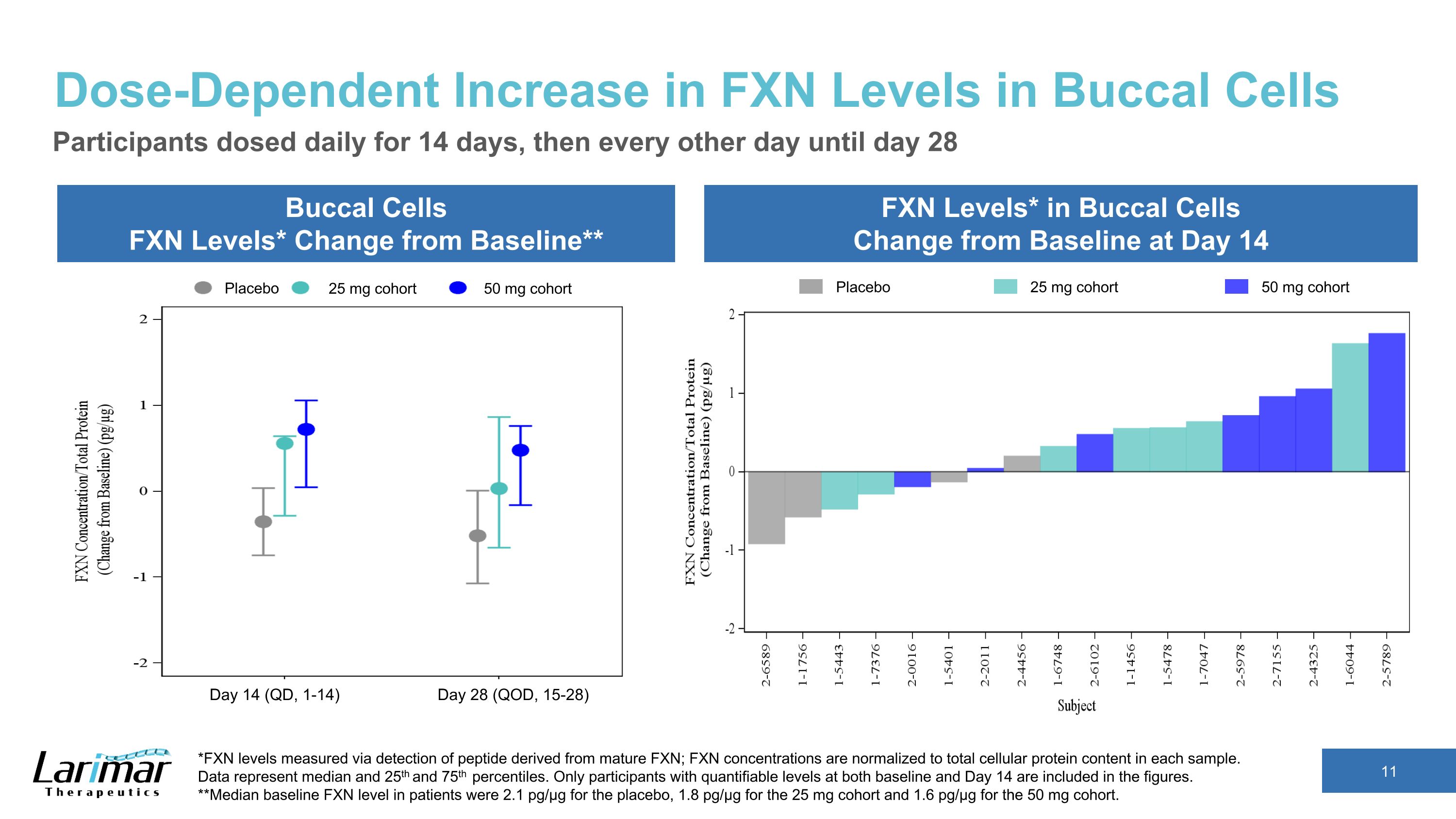
Dose-Dependent Increase in FXN Levels in Buccal Cells Buccal Cells FXN Levels* Change from Baseline** FXN Levels* in Buccal Cells Change from Baseline at Day 14 Participants dosed daily for 14 days, then every other day until day 28 *FXN levels measured via detection of peptide derived from mature FXN; FXN concentrations are normalized to total cellular protein content in each sample. �Data represent median and 25th and 75th percentiles. Only participants with quantifiable levels at both baseline and Day 14 are included in the figures. **Median baseline FXN level in patients were 2.1 pg/µg for the placebo, 1.8 pg/µg for the 25 mg cohort and 1.6 pg/µg for the 50 mg cohort. Placebo 25 mg cohort 50 mg cohort Placebo 25 mg cohort 50 mg cohort Day 14 (QD, 1-14) Day 28 (QOD, 15-28)
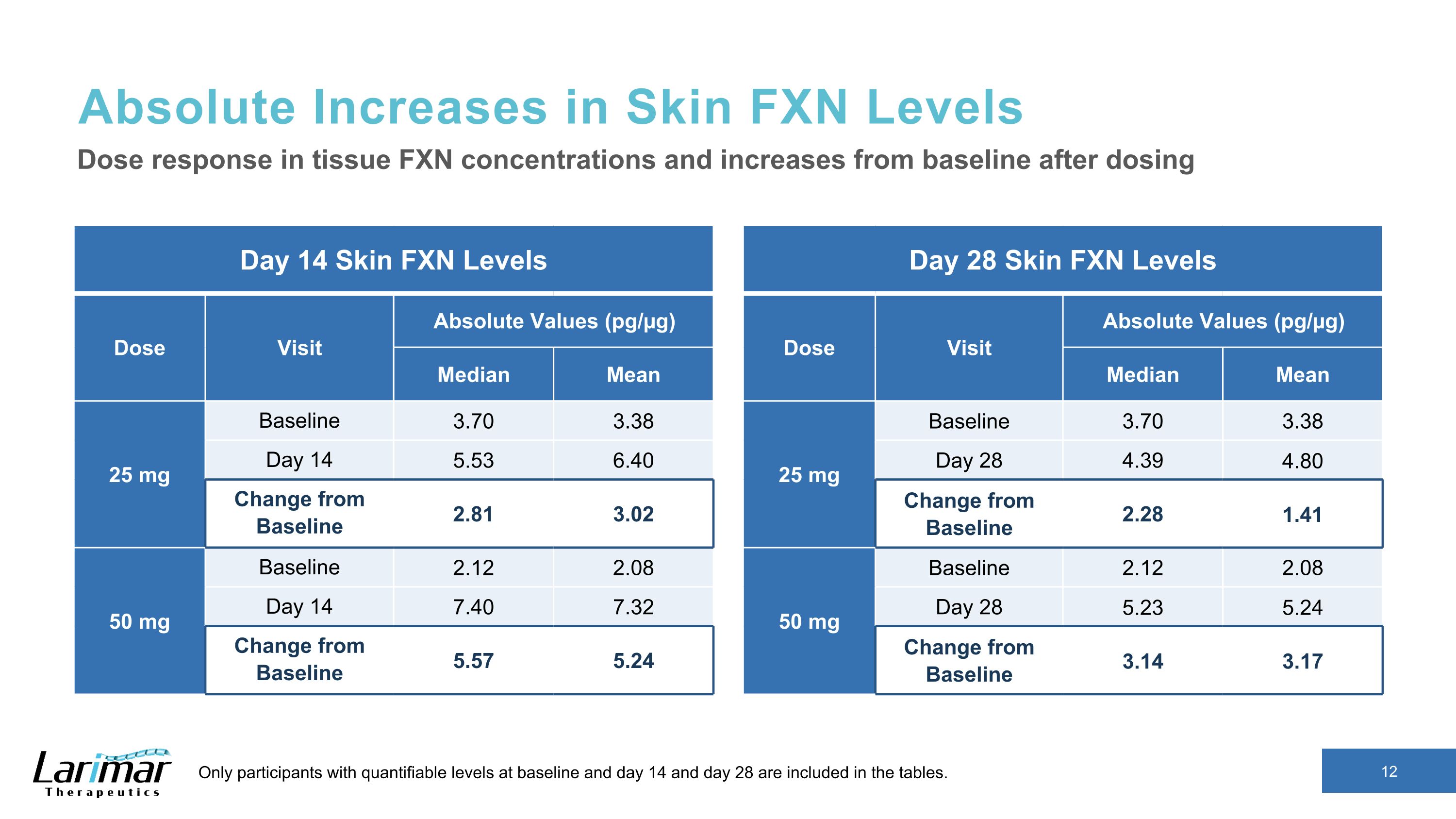
Absolute Increases in Skin FXN Levels Day 14 Skin FXN Levels Dose Visit Absolute Values (pg/µg) Median Mean 25 mg Baseline 3.70 3.38 Day 14 5.53 6.40 Change from Baseline 2.81 3.02 50 mg Baseline 2.12 2.08 Day 14 7.40 7.32 Change from Baseline 5.57 5.24 Dose response in tissue FXN concentrations and increases from baseline after dosing Only participants with quantifiable levels at baseline and day 14 and day 28 are included in the tables. Day 28 Skin FXN Levels Dose Visit Absolute Values (pg/µg) Median Mean 25 mg Baseline 3.70 3.38 Day 28 4.39 4.80 Change from Baseline 2.28 1.41 50 mg Baseline 2.12 2.08 Day 28 5.23 5.24 Change from Baseline 3.14 3.17
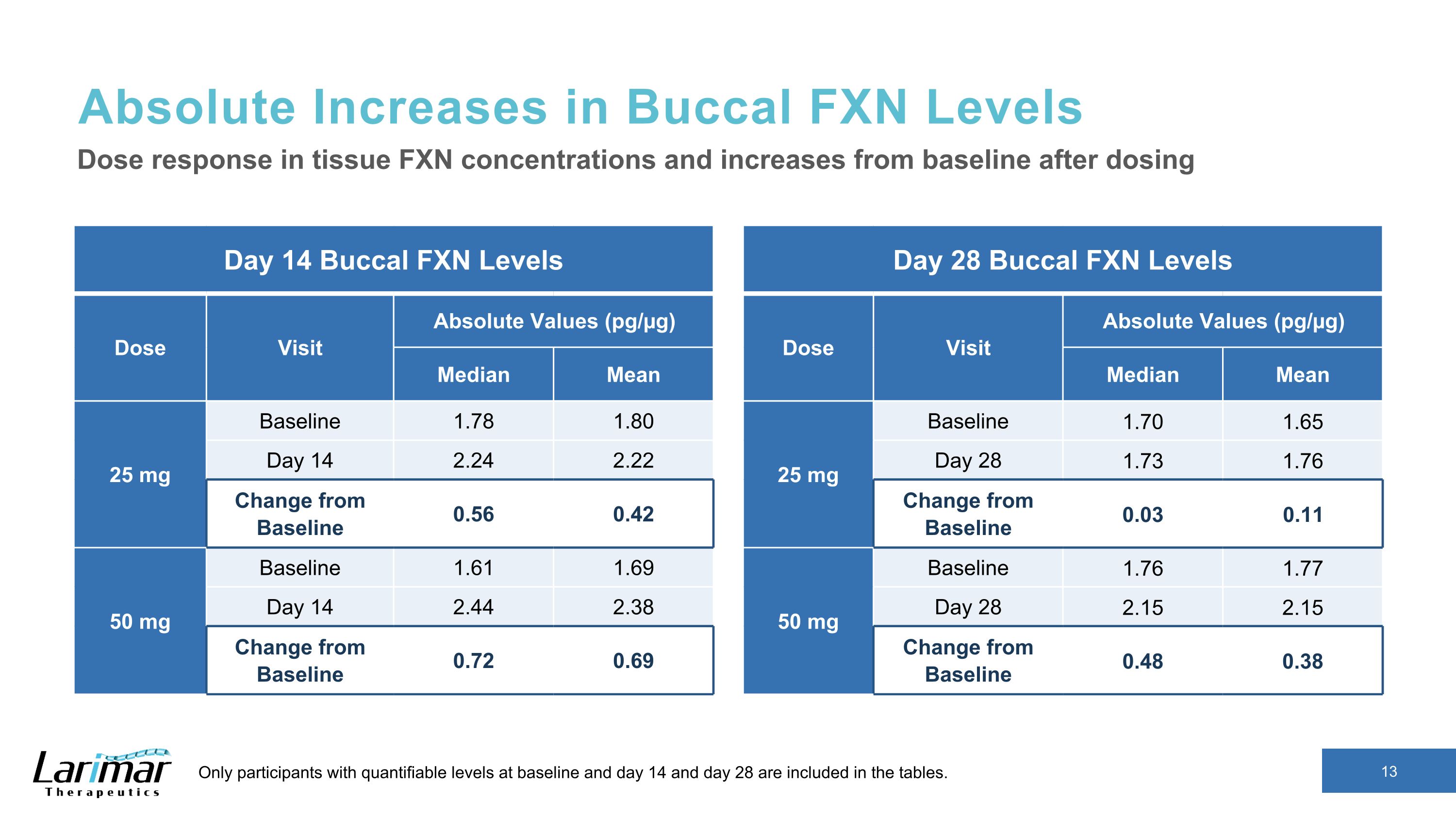
Absolute Increases in Buccal FXN Levels Day 14 Buccal FXN Levels Dose Visit Absolute Values (pg/µg) Median Mean 25 mg Baseline 1.78 1.80 Day 14 2.24 2.22 Change from Baseline 0.56 0.42 50 mg Baseline 1.61 1.69 Day 14 2.44 2.38 Change from Baseline 0.72 0.69 Dose response in tissue FXN concentrations and increases from baseline after dosing Only participants with quantifiable levels at baseline and day 14 and day 28 are included in the tables. Day 28 Buccal FXN Levels Dose Visit Absolute Values (pg/µg) Median Mean 25 mg Baseline 1.70 1.65 Day 28 1.73 1.76 Change from Baseline 0.03 0.11 50 mg Baseline 1.76 1.77 Day 28 2.15 2.15 Change from Baseline 0.48 0.38
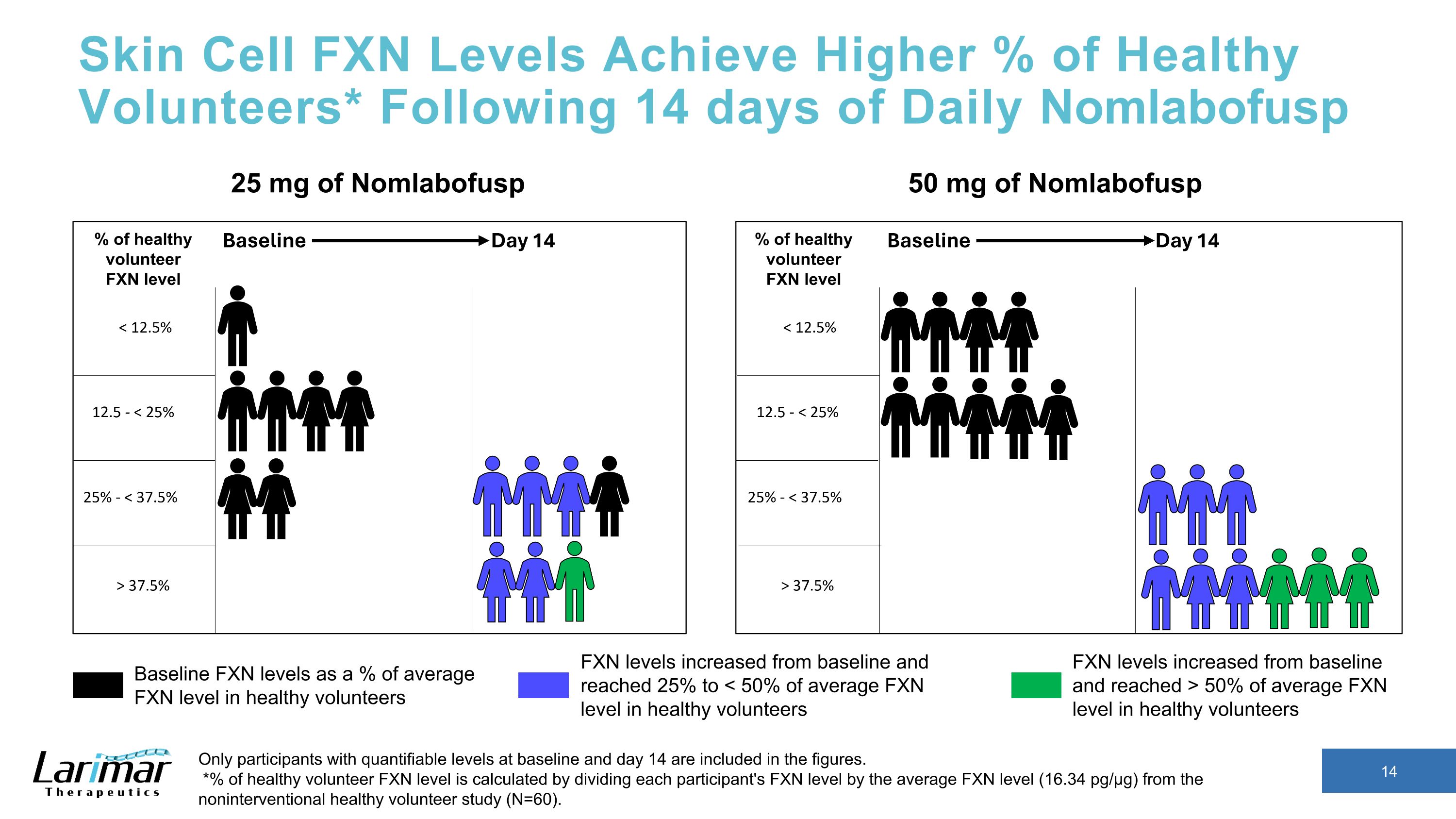
Skin Cell FXN Levels Achieve Higher % of Healthy Volunteers* Following 14 days of Daily Nomlabofusp Only participants with quantifiable levels at baseline and day 14 are included in the figures. *% of healthy volunteer FXN level is calculated by dividing each participant's FXN level by the average FXN level (16.34 pg/µg) from the noninterventional healthy volunteer study (N=60). 25 mg of Nomlabofusp 50 mg of Nomlabofusp Baseline FXN levels as a % of average FXN level in healthy volunteers FXN levels increased from baseline and reached > 50% of average FXN level in healthy volunteers FXN levels increased from baseline and reached 25% to < 50% of average FXN level in healthy volunteers % of healthy volunteer FXN level % of healthy volunteer FXN level
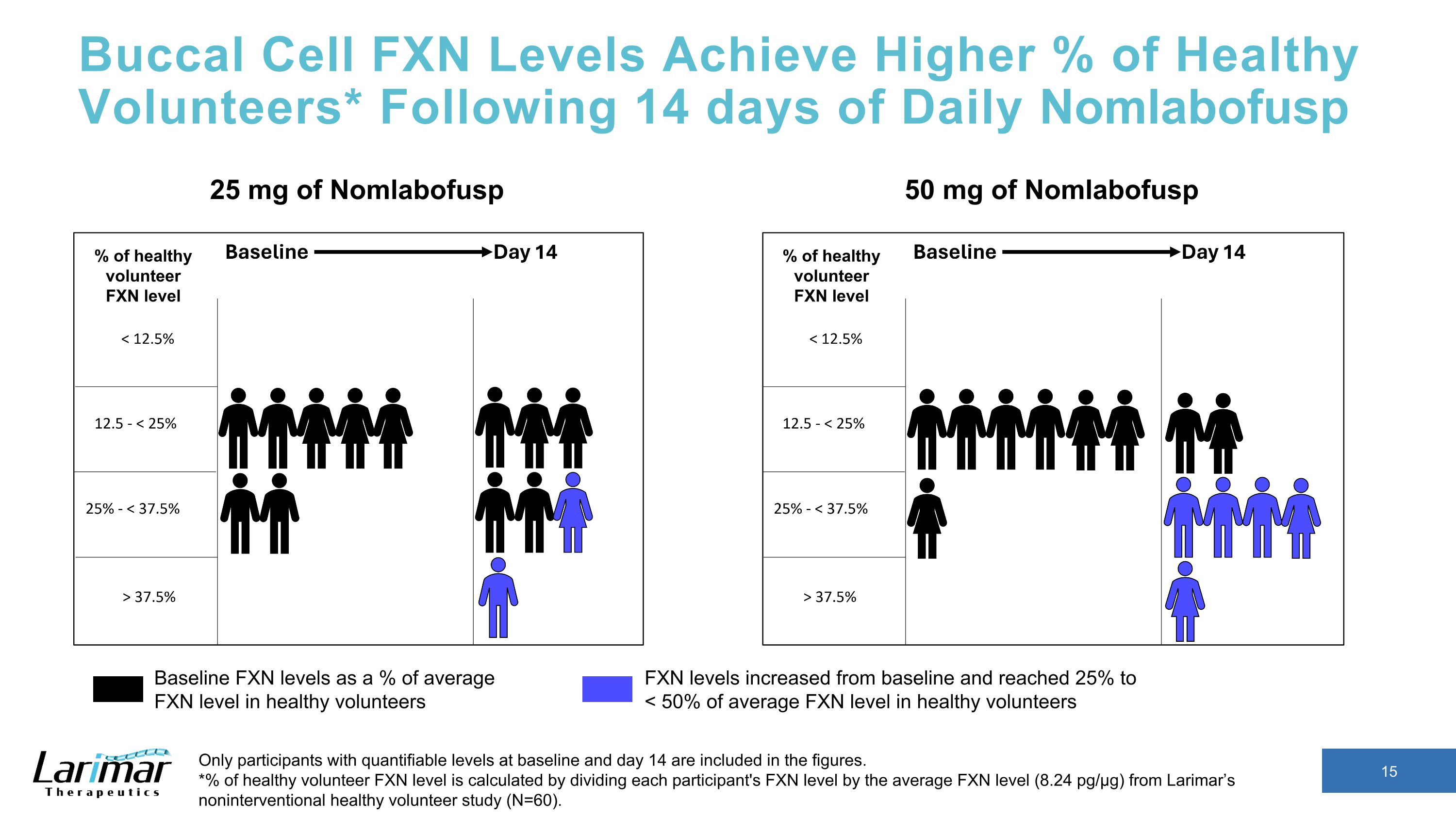
Buccal Cell FXN Levels Achieve Higher % of Healthy Volunteers* Following 14 days of Daily Nomlabofusp Only participants with quantifiable levels at baseline and day 14 are included in the figures. *% of healthy volunteer FXN level is calculated by dividing each participant's FXN level by the average FXN level (8.24 pg/µg) from Larimar’s noninterventional healthy volunteer study (N=60). 50 mg of Nomlabofusp Baseline FXN levels as a % of average FXN level in healthy volunteers FXN levels increased from baseline and reached 25% to �< 50% of average FXN level in healthy volunteers 25 mg of Nomlabofusp % of healthy volunteer FXN level % of healthy volunteer FXN level
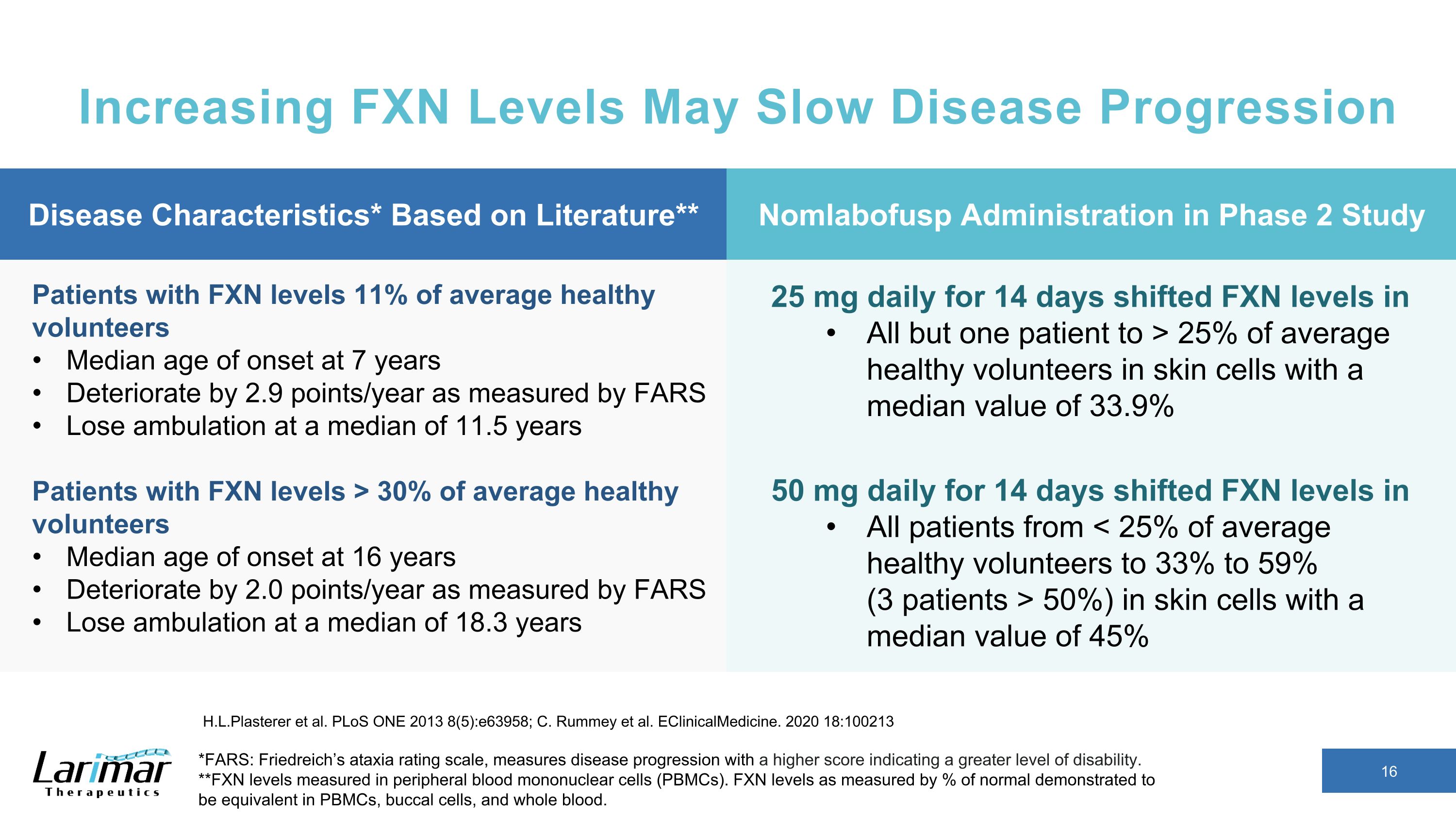
Increasing FXN Levels May Slow Disease Progression *FARS: Friedreich’s ataxia rating scale, measures disease progression with a higher score indicating a greater level of disability. **FXN levels measured in peripheral blood mononuclear cells (PBMCs). FXN levels as measured by % of normal demonstrated to be equivalent in PBMCs, buccal cells, and whole blood. H.L.Plasterer et al. PLoS ONE 2013 8(5):e63958; C. Rummey et al. EClinicalMedicine. 2020 18:100213 Patients with FXN levels 11% of average healthy volunteers Median age of onset at 7 years Deteriorate by 2.9 points/year as measured by FARS Lose ambulation at a median of 11.5 years Patients with FXN levels > 30% of average healthy volunteers Median age of onset at 16 years Deteriorate by 2.0 points/year as measured by FARS Lose ambulation at a median of 18.3 years 25 mg daily for 14 days shifted FXN levels in All but one patient to > 25% of average healthy volunteers in skin cells with a median value of 33.9% 50 mg daily for 14 days shifted FXN levels in All patients from < 25% of average healthy volunteers to 33% to 59% �(3 patients > 50%) in skin cells with a median value of 45% Disease Characteristics* Based on Literature** Nomlabofusp Administration in Phase 2 Study
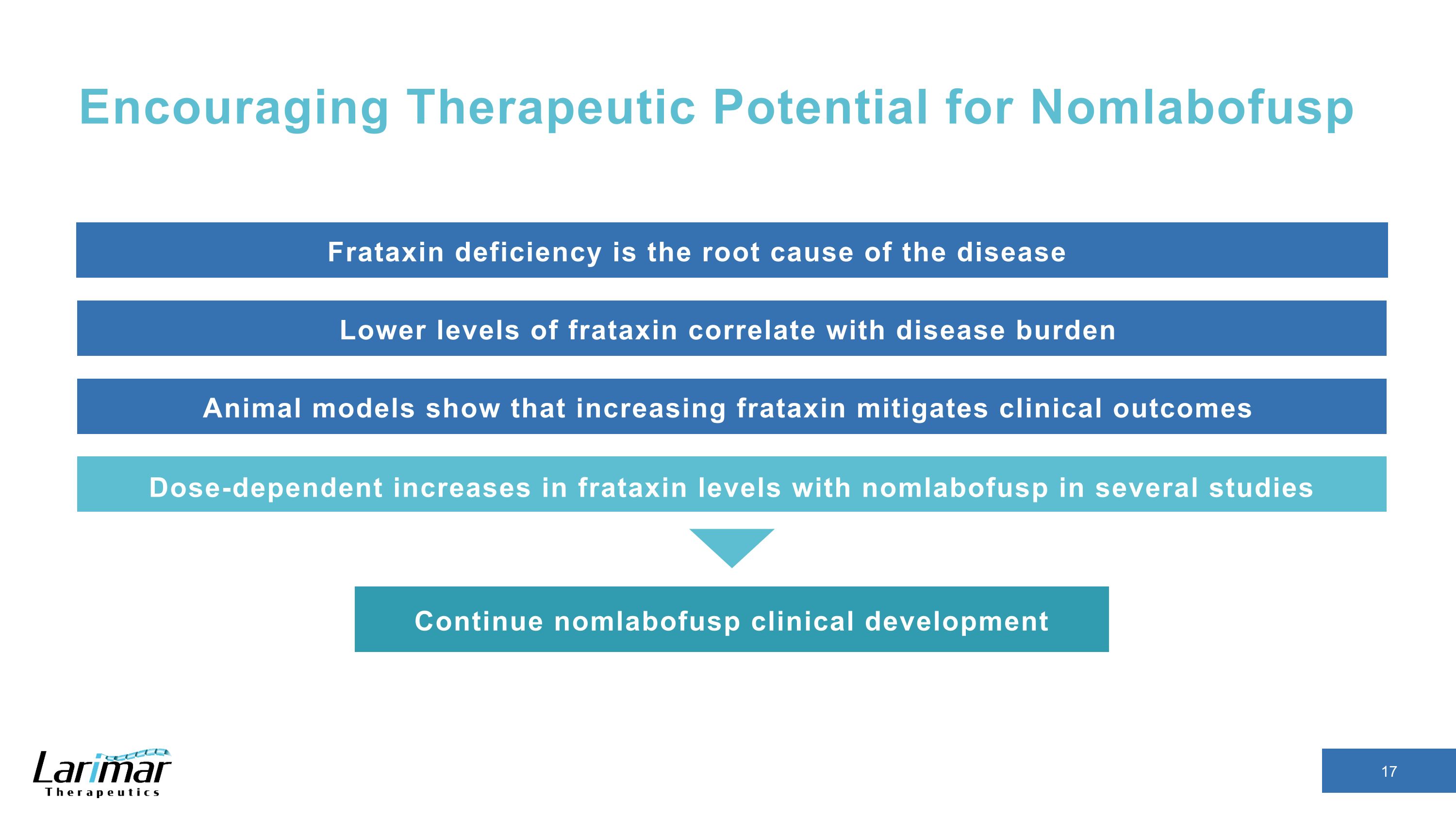
Encouraging Therapeutic Potential for Nomlabofusp Continue nomlabofusp clinical development Dose-dependent increases in frataxin levels with nomlabofusp in several studies Frataxin deficiency is the root cause of the disease Lower levels of frataxin correlate with disease burden Animal models show that increasing frataxin mitigates clinical outcomes
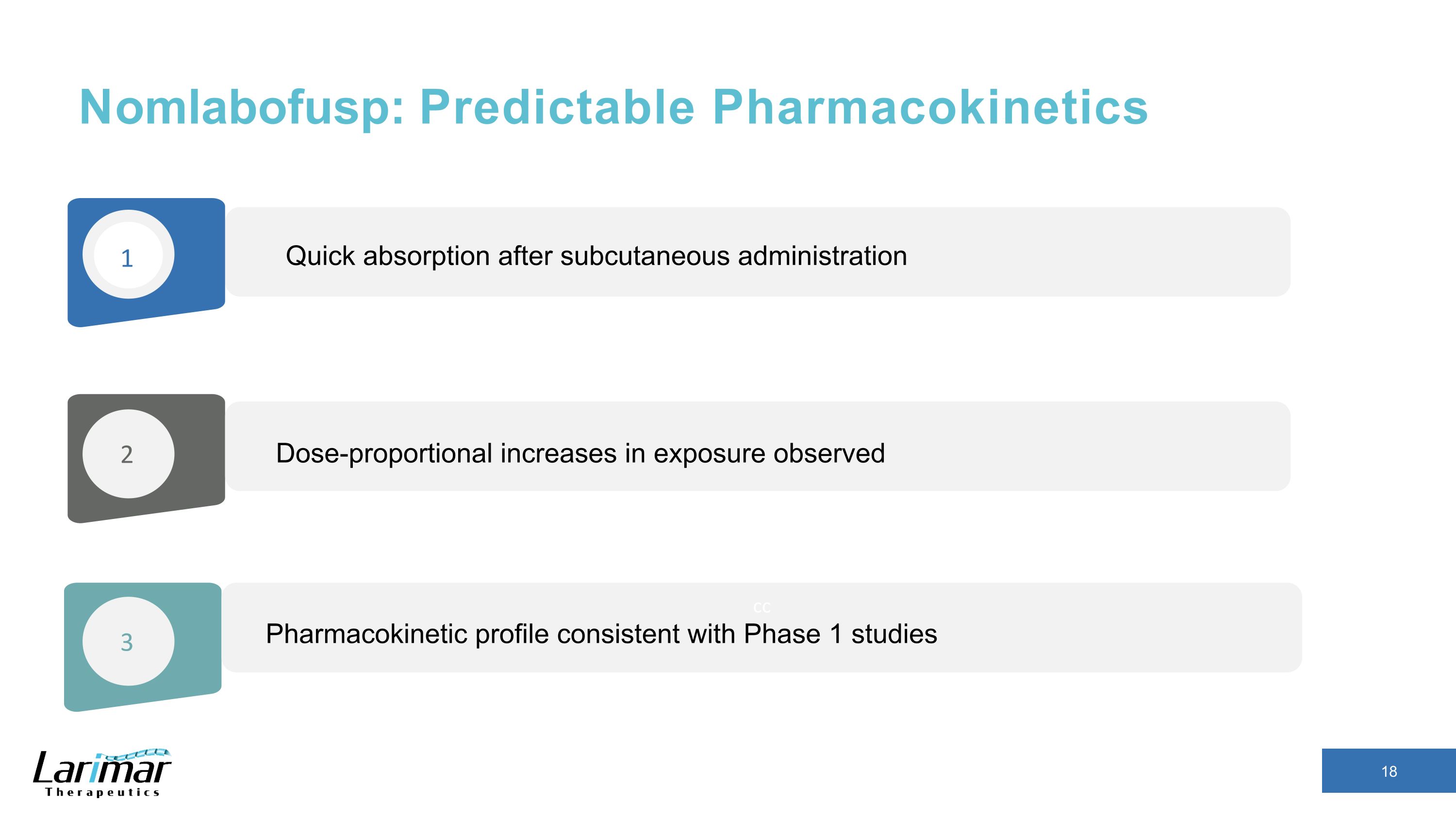
Nomlabofusp: Predictable Pharmacokinetics Quick absorption after subcutaneous administration 1 2 3 Dose-proportional increases in exposure observed cc Pharmacokinetic profile consistent with Phase 1 studies
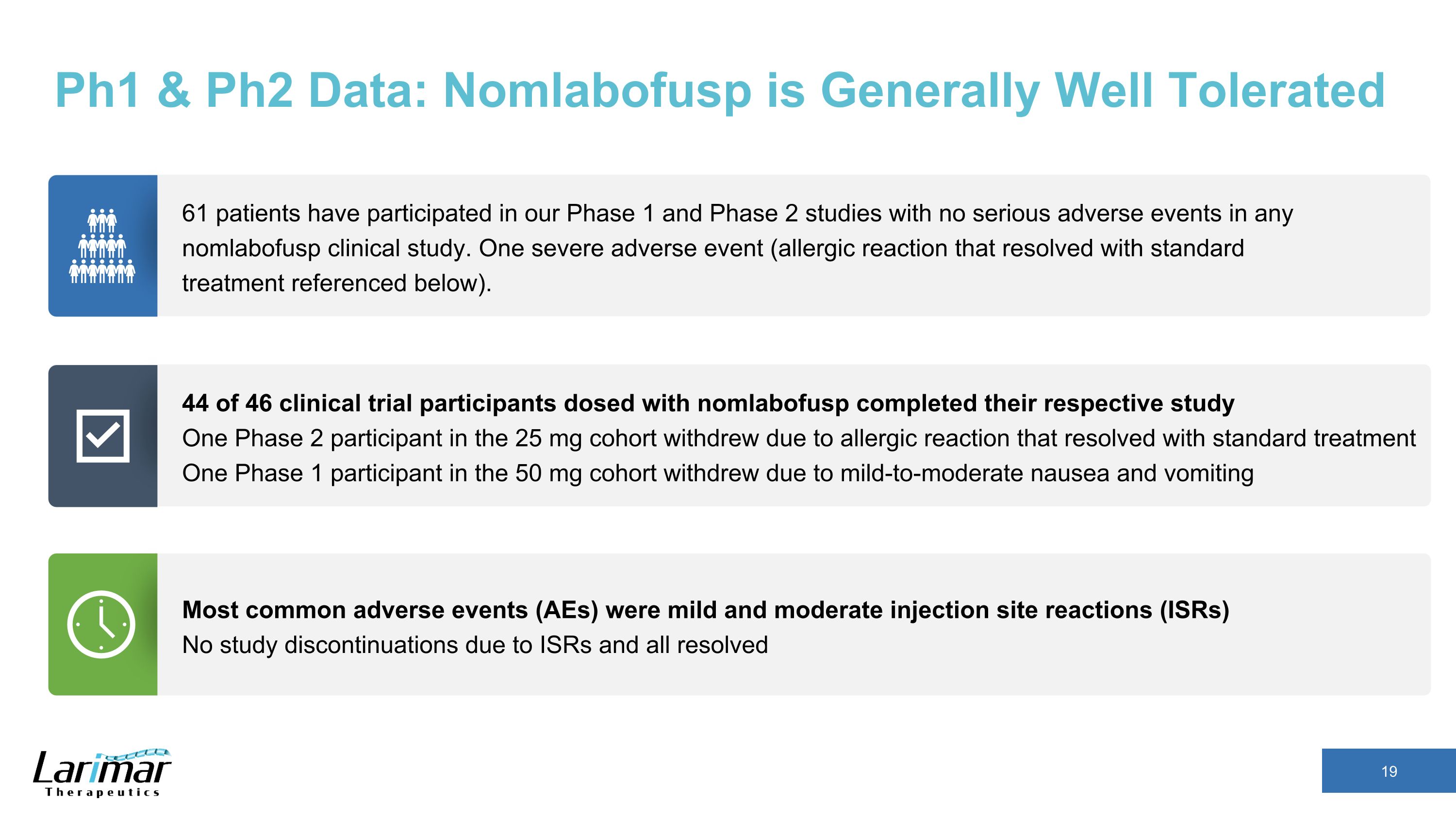
Ph1 & Ph2 Data: Nomlabofusp is Generally Well Tolerated 44 of 46 clinical trial participants dosed with nomlabofusp completed their respective study One Phase 2 participant in the 25 mg cohort withdrew due to allergic reaction that resolved with standard treatment One Phase 1 participant in the 50 mg cohort withdrew due to mild-to-moderate nausea and vomiting 61 patients have participated in our Phase 1 and Phase 2 studies with no serious adverse events in any nomlabofusp clinical study. One severe adverse event (allergic reaction that resolved with standard treatment referenced below). Most common adverse events (AEs) were mild and moderate injection site reactions (ISRs) No study discontinuations due to ISRs and all resolved
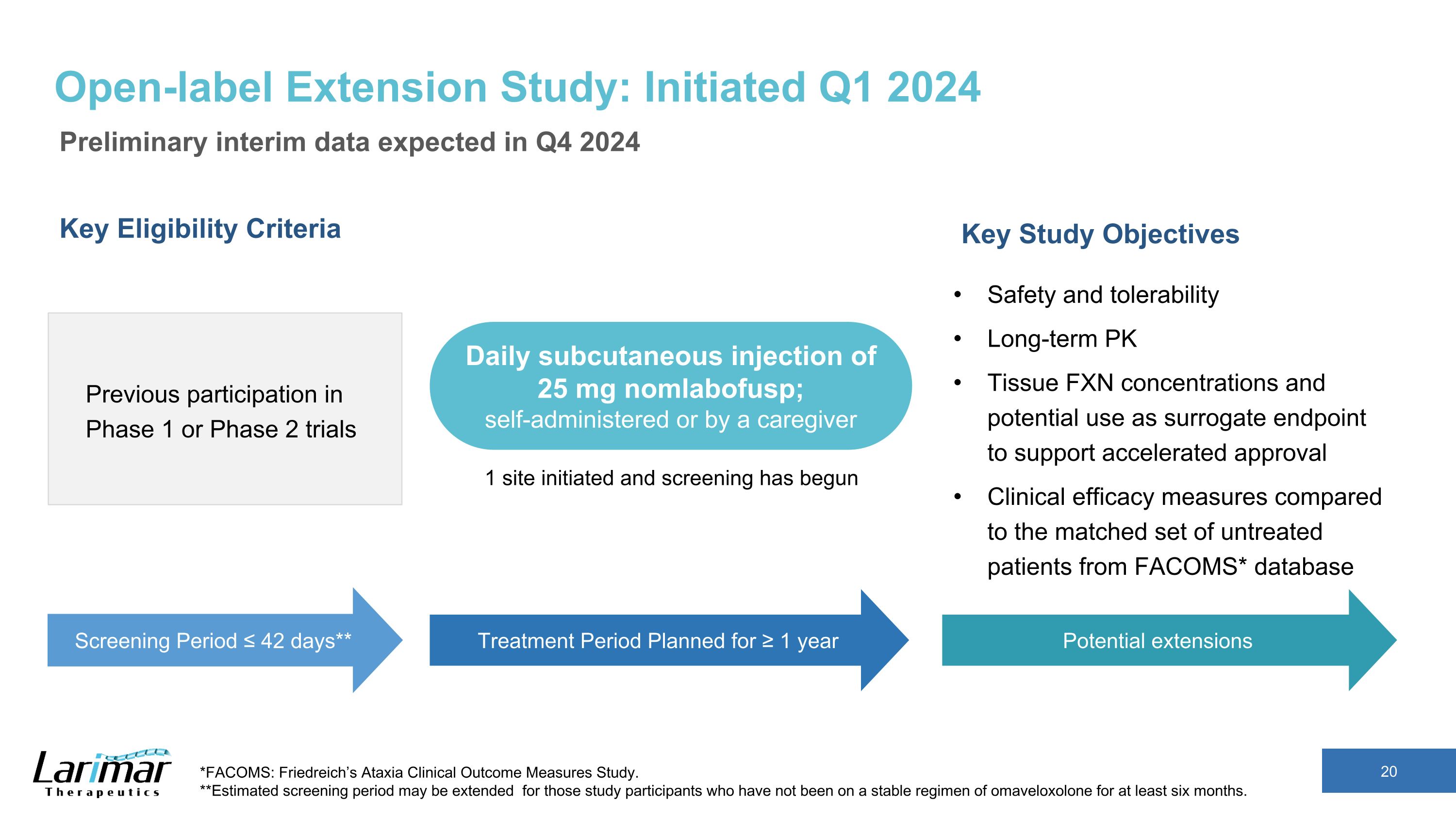
Open-label Extension Study: Initiated Q1 2024 Preliminary interim data expected in Q4 2024 Key Eligibility Criteria Previous participation in Phase 1 or Phase 2 trials Key Study Objectives Safety and tolerability Long-term PK Tissue FXN concentrations and potential use as surrogate endpoint to support accelerated approval Clinical efficacy measures compared to the matched set of untreated patients from FACOMS* database *FACOMS: Friedreich’s Ataxia Clinical Outcome Measures Study. **Estimated screening period may be extended for those study participants who have not been on a stable regimen of omaveloxolone for at least six months. Screening Period ≤ 42 days** Treatment Period Planned for ≥ 1 year Daily subcutaneous injection of 25 mg nomlabofusp; self-administered or by a caregiver 1 site initiated and screening has begun Potential extensions

Nomlabofusp Clinical Development Plan Planned global double-blind placebo-controlled registration/confirmatory study** Planned pediatric MAD trial in patients 2 to 17 years of age* Intend to pursue accelerated approval pathway with potential BLA submission targeted for 2H 2025 *Company is discussing with FDA how to best include patients 2 to 17 years of age in clinical development. **Company initiated discussions with FDA on the role of FXN levels to support accelerated approval. Also, the Company is planning discussions with regulators and investigators outside the U.S. to expand clinical program to international geographies. Initiation of additional U.S. clinical trials is contingent on FDA review of clinical data due to partial clinical hold. Ongoing open-label extension study with 25 mg daily dosing for eligible patients who participated in SAD, MAD, and/or four-week dose exploration studies OLE BLA submission targeted for �2H 2025 Participants eligible to screen for OLE trial Initial data expected Q4 2024
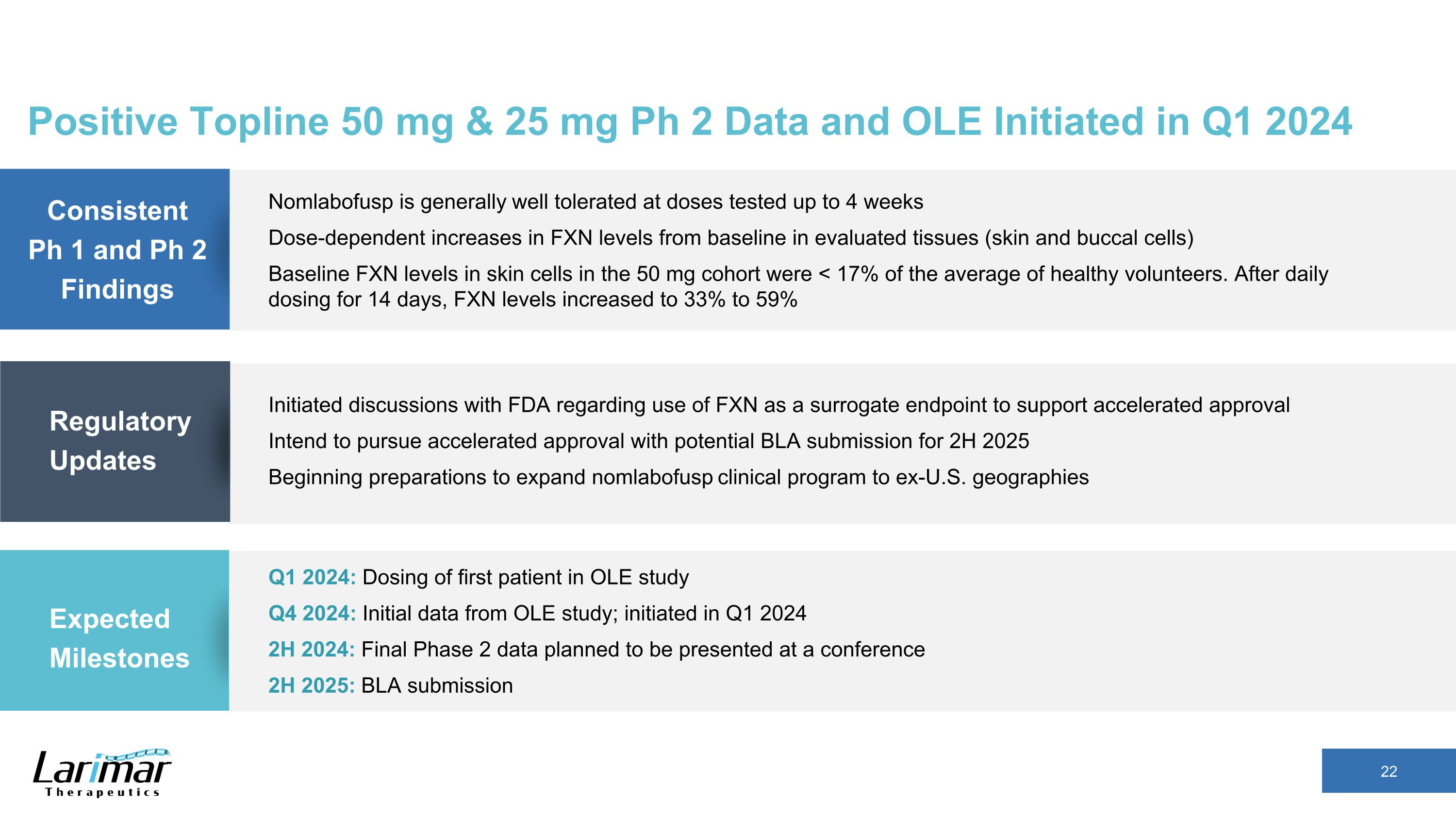
Regulatory Updates Q1 2024: Dosing of first patient in OLE study Q4 2024: Initial data from OLE study; initiated in Q1 2024 2H 2024: Final Phase 2 data planned to be presented at a conference 2H 2025: BLA submission Expected Milestones Consistent Ph 1 and Ph 2 Findings Initiated discussions with FDA regarding use of FXN as a surrogate endpoint to support accelerated approval Intend to pursue accelerated approval with potential BLA submission for 2H 2025 Beginning preparations to expand nomlabofusp clinical program to ex-U.S. geographies Nomlabofusp is generally well tolerated at doses tested up to 4 weeks Dose-dependent increases in FXN levels from baseline in evaluated tissues (skin and buccal cells) Baseline FXN levels in skin cells in the 50 mg cohort were < 17% of the average of healthy volunteers. After daily dosing for 14 days, FXN levels increased to 33% to 59% Positive Topline 50 mg & 25 mg Ph 2 Data and OLE Initiated in Q1 2024
v3.24.0.1
| X |
- DefinitionBoolean flag that is true when the XBRL content amends previously-filed or accepted submission.
| Name: |
dei_AmendmentFlag |
| Namespace Prefix: |
dei_ |
| Data Type: |
xbrli:booleanItemType |
| Balance Type: |
na |
| Period Type: |
duration |
|
| X |
- DefinitionFor the EDGAR submission types of Form 8-K: the date of the report, the date of the earliest event reported; for the EDGAR submission types of Form N-1A: the filing date; for all other submission types: the end of the reporting or transition period. The format of the date is YYYY-MM-DD.
| Name: |
dei_DocumentPeriodEndDate |
| Namespace Prefix: |
dei_ |
| Data Type: |
xbrli:dateItemType |
| Balance Type: |
na |
| Period Type: |
duration |
|
| X |
- DefinitionThe type of document being provided (such as 10-K, 10-Q, 485BPOS, etc). The document type is limited to the same value as the supporting SEC submission type, or the word 'Other'.
| Name: |
dei_DocumentType |
| Namespace Prefix: |
dei_ |
| Data Type: |
dei:submissionTypeItemType |
| Balance Type: |
na |
| Period Type: |
duration |
|
| X |
- DefinitionAddress Line 1 such as Attn, Building Name, Street Name
| Name: |
dei_EntityAddressAddressLine1 |
| Namespace Prefix: |
dei_ |
| Data Type: |
xbrli:normalizedStringItemType |
| Balance Type: |
na |
| Period Type: |
duration |
|
| X |
- Definition
+ References
+ Details
| Name: |
dei_EntityAddressCityOrTown |
| Namespace Prefix: |
dei_ |
| Data Type: |
xbrli:normalizedStringItemType |
| Balance Type: |
na |
| Period Type: |
duration |
|
| X |
- DefinitionCode for the postal or zip code
| Name: |
dei_EntityAddressPostalZipCode |
| Namespace Prefix: |
dei_ |
| Data Type: |
xbrli:normalizedStringItemType |
| Balance Type: |
na |
| Period Type: |
duration |
|
| X |
- DefinitionName of the state or province.
| Name: |
dei_EntityAddressStateOrProvince |
| Namespace Prefix: |
dei_ |
| Data Type: |
dei:stateOrProvinceItemType |
| Balance Type: |
na |
| Period Type: |
duration |
|
| X |
- DefinitionA unique 10-digit SEC-issued value to identify entities that have filed disclosures with the SEC. It is commonly abbreviated as CIK. Reference 1: http://www.xbrl.org/2003/role/presentationRef
-Publisher SEC
-Name Exchange Act
-Number 240
-Section 12
-Subsection b-2
| Name: |
dei_EntityCentralIndexKey |
| Namespace Prefix: |
dei_ |
| Data Type: |
dei:centralIndexKeyItemType |
| Balance Type: |
na |
| Period Type: |
duration |
|
| X |
- DefinitionIndicate if registrant meets the emerging growth company criteria. Reference 1: http://www.xbrl.org/2003/role/presentationRef
-Publisher SEC
-Name Exchange Act
-Number 240
-Section 12
-Subsection b-2
| Name: |
dei_EntityEmergingGrowthCompany |
| Namespace Prefix: |
dei_ |
| Data Type: |
xbrli:booleanItemType |
| Balance Type: |
na |
| Period Type: |
duration |
|
| X |
- DefinitionCommission file number. The field allows up to 17 characters. The prefix may contain 1-3 digits, the sequence number may contain 1-8 digits, the optional suffix may contain 1-4 characters, and the fields are separated with a hyphen.
| Name: |
dei_EntityFileNumber |
| Namespace Prefix: |
dei_ |
| Data Type: |
dei:fileNumberItemType |
| Balance Type: |
na |
| Period Type: |
duration |
|
| X |
- DefinitionTwo-character EDGAR code representing the state or country of incorporation.
| Name: |
dei_EntityIncorporationStateCountryCode |
| Namespace Prefix: |
dei_ |
| Data Type: |
dei:edgarStateCountryItemType |
| Balance Type: |
na |
| Period Type: |
duration |
|
| X |
- DefinitionThe exact name of the entity filing the report as specified in its charter, which is required by forms filed with the SEC. Reference 1: http://www.xbrl.org/2003/role/presentationRef
-Publisher SEC
-Name Exchange Act
-Number 240
-Section 12
-Subsection b-2
| Name: |
dei_EntityRegistrantName |
| Namespace Prefix: |
dei_ |
| Data Type: |
xbrli:normalizedStringItemType |
| Balance Type: |
na |
| Period Type: |
duration |
|
| X |
- DefinitionThe Tax Identification Number (TIN), also known as an Employer Identification Number (EIN), is a unique 9-digit value assigned by the IRS. Reference 1: http://www.xbrl.org/2003/role/presentationRef
-Publisher SEC
-Name Exchange Act
-Number 240
-Section 12
-Subsection b-2
| Name: |
dei_EntityTaxIdentificationNumber |
| Namespace Prefix: |
dei_ |
| Data Type: |
dei:employerIdItemType |
| Balance Type: |
na |
| Period Type: |
duration |
|
| X |
- DefinitionLocal phone number for entity.
| Name: |
dei_LocalPhoneNumber |
| Namespace Prefix: |
dei_ |
| Data Type: |
xbrli:normalizedStringItemType |
| Balance Type: |
na |
| Period Type: |
duration |
|
| X |
- DefinitionBoolean flag that is true when the Form 8-K filing is intended to satisfy the filing obligation of the registrant as pre-commencement communications pursuant to Rule 13e-4(c) under the Exchange Act. Reference 1: http://www.xbrl.org/2003/role/presentationRef
-Publisher SEC
-Name Exchange Act
-Number 240
-Section 13e
-Subsection 4c
| Name: |
dei_PreCommencementIssuerTenderOffer |
| Namespace Prefix: |
dei_ |
| Data Type: |
xbrli:booleanItemType |
| Balance Type: |
na |
| Period Type: |
duration |
|
| X |
- DefinitionBoolean flag that is true when the Form 8-K filing is intended to satisfy the filing obligation of the registrant as pre-commencement communications pursuant to Rule 14d-2(b) under the Exchange Act. Reference 1: http://www.xbrl.org/2003/role/presentationRef
-Publisher SEC
-Name Exchange Act
-Number 240
-Section 14d
-Subsection 2b
| Name: |
dei_PreCommencementTenderOffer |
| Namespace Prefix: |
dei_ |
| Data Type: |
xbrli:booleanItemType |
| Balance Type: |
na |
| Period Type: |
duration |
|
| X |
- DefinitionTitle of a 12(b) registered security. Reference 1: http://www.xbrl.org/2003/role/presentationRef
-Publisher SEC
-Name Exchange Act
-Number 240
-Section 12
-Subsection b
| Name: |
dei_Security12bTitle |
| Namespace Prefix: |
dei_ |
| Data Type: |
dei:securityTitleItemType |
| Balance Type: |
na |
| Period Type: |
duration |
|
| X |
- DefinitionName of the Exchange on which a security is registered. Reference 1: http://www.xbrl.org/2003/role/presentationRef
-Publisher SEC
-Name Exchange Act
-Number 240
-Section 12
-Subsection d1-1
| Name: |
dei_SecurityExchangeName |
| Namespace Prefix: |
dei_ |
| Data Type: |
dei:edgarExchangeCodeItemType |
| Balance Type: |
na |
| Period Type: |
duration |
|
| X |
- DefinitionBoolean flag that is true when the Form 8-K filing is intended to satisfy the filing obligation of the registrant as soliciting material pursuant to Rule 14a-12 under the Exchange Act. Reference 1: http://www.xbrl.org/2003/role/presentationRef
-Publisher SEC
-Name Exchange Act
-Section 14a
-Number 240
-Subsection 12
| Name: |
dei_SolicitingMaterial |
| Namespace Prefix: |
dei_ |
| Data Type: |
xbrli:booleanItemType |
| Balance Type: |
na |
| Period Type: |
duration |
|
| X |
- DefinitionTrading symbol of an instrument as listed on an exchange.
| Name: |
dei_TradingSymbol |
| Namespace Prefix: |
dei_ |
| Data Type: |
dei:tradingSymbolItemType |
| Balance Type: |
na |
| Period Type: |
duration |
|
| X |
- DefinitionBoolean flag that is true when the Form 8-K filing is intended to satisfy the filing obligation of the registrant as written communications pursuant to Rule 425 under the Securities Act. Reference 1: http://www.xbrl.org/2003/role/presentationRef
-Publisher SEC
-Name Securities Act
-Number 230
-Section 425
| Name: |
dei_WrittenCommunications |
| Namespace Prefix: |
dei_ |
| Data Type: |
xbrli:booleanItemType |
| Balance Type: |
na |
| Period Type: |
duration |
|
Larimar Therapeutics (NASDAQ:LRMR)
Historical Stock Chart
From Oct 2024 to Nov 2024
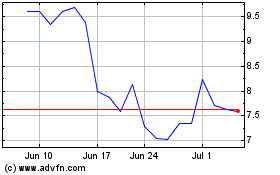
Larimar Therapeutics (NASDAQ:LRMR)
Historical Stock Chart
From Nov 2023 to Nov 2024
